Moxa WAPN008 Industrial 802.11a/b/g/n Outdoor Access Point User Manual AWK 4131A XXXXX UserMan
Moxa Inc. Industrial 802.11a/b/g/n Outdoor Access Point AWK 4131A XXXXX UserMan
Moxa >
Contents
- 1. Users Manual
- 2. (AWK-4131A-XXXXX) UserMan
- 3. (AWK-11xyz-p-t) UserMan
- 4. (AWK-3131A) UserMan
- 5. (TAP-213-XX-CT-T) UserMan 12-29
- 6. TAP-213_UM_e1
- 7. WAPN008- UserMan_0816
- 8. WAPN008- UserMan_AWK-3131A-M12-RCC_20180820
- 9. WAPN008- UserMan_AWK-3131A-M12-RTG_20180820
- 10. WAPN008- UserMan_AWK-3131A-SSC-RTG_20180820
- 11. WAPN008- UserMan_20180911
(AWK-4131A-XXXXX) UserMan
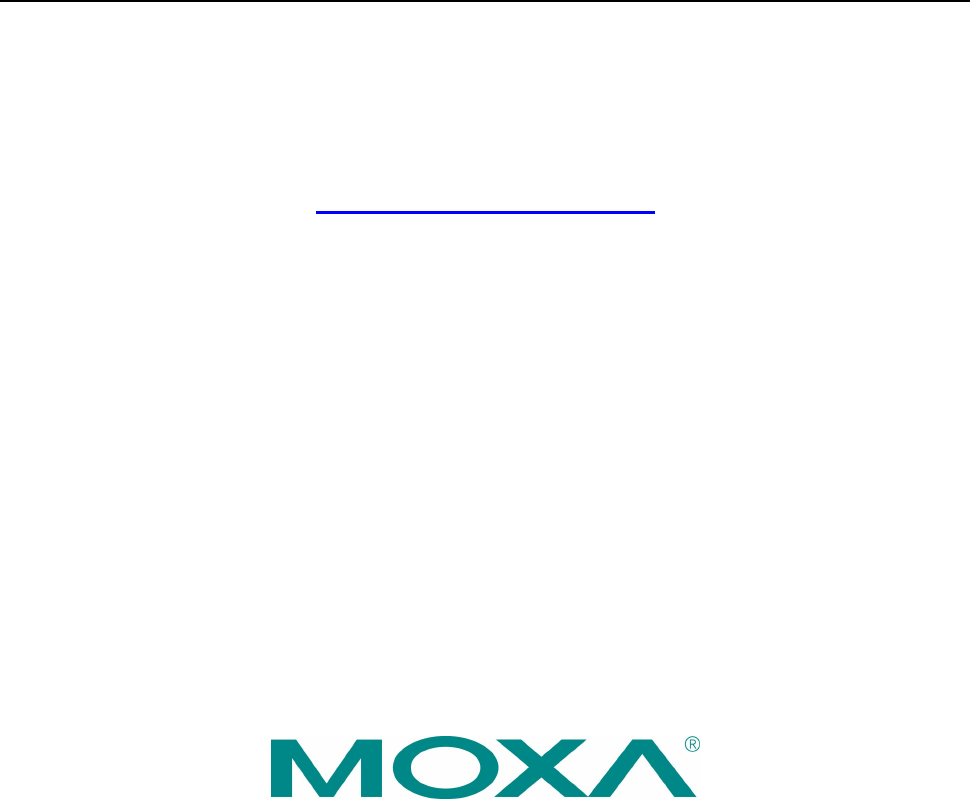
AirWorks AWK-4131A User’s Manual
First Edition, October 2015
www.moxa.com/product
© 2015 Moxa Inc. All rights reserved.

AirWorks AWK-4131A User’s Manual
The software described in this manual is furnished under a license agreement and may be used only in accordance with
the terms of that agreement.
Copyright Notice
© 2015 Moxa Inc. All rights reserved.
Trademarks
The MOXA logo is a registered trademark of Moxa Inc.
All other trademarks or registered marks in this manual belong to their respective manufacturers.
Disclaimer
Information in this document is subject to change without notice and does not represent a commitment on the part of
Moxa.
Moxa provides this document as is, without warranty of any kind, either expressed or implied, including, but not limited
to, its particular purpose. Moxa reserves the right to make improvements and/or changes to this manual, or to the
products and/or the programs described in this manual, at any time.
Information provided in this manual is intended to be accurate and reliable. However, Moxa assumes no responsibility for
its use, or for any infringements on the rights of third parties that may result from its use.
This product might include unintentional technical or typographical errors. Changes are periodically made to the
information herein to correct such errors, and these changes are incorporated into new editions of the publication.
Technical Support Contact Information
www.moxa.com/support
Moxa Americas
Toll
-free: 1-888-669-2872
Tel:
+1-714-528-6777
Fax:
+1-714-528-6778
Moxa China (Shanghai office)
Toll
-free: 800-820-5036
Tel:
+86-21-5258-9955
Fax:
+86-21-5258-5505
Moxa Europe
Tel:
+49-89-3 70 03 99-0
Fax:
+49-89-3 70 03 99-99
Moxa Asia
-Pacific
Tel:
+886-2-8919-1230
Fax:
+886-2-8919-1231
Moxa India
Tel:
+91-80-4172-9088
Fax:
+91-80-4132-1045
DoC (Declaration of Conformity)
Federal Communication Commission Interference Statement
This equipment has been tested and found to comply with the limits
for a Class B digital device, pursuant to Part 15 of the FCC Rules.
These limits are designed to provide reasonable protection against
harmful interference in a residential installation. This equipment
generates, uses and can radiate radio frequency energy and, if not
installed and used in accordance with the instructions, may cause
harmful interference to radio communications. However, there is no
guarantee that interference will not occur in a particular installation. If
this equipment does cause harmful interference to radio or television
reception, which can be determined by turning the equipment off and
on, the user is encouraged to try to correct the interference by one of
the following measures:
• Reorient or relocate the receiving antenna.
• Increase the separation between the equipment and receiver.
• Connect the equipment into an outlet on a circuit different from that
to which the receiver is connected.
• Consult the dealer or an experienced radio/TV technician for help.
FCC Caution: To assure continued compliance, (example – use only
shielded interface cables when connecting to computer or peripheral
devices). Any changes or modifications not expressly approved by the
party responsible for compliance could void the user’s authority to
operate this equipment. This transmitter must not be co-located or
operated in conjunction with any other antenna or transmitter.
FCC Radiation Exposure Statement
This equipment complies with FCC radiation exposure limits set forth
for an uncontrolled environment. This equipment should be installed
and operated with a minimum distance of 20 cm between the radiator
& your body.
This device complies with Part 15 of the FCC Rules. Operation is
subject to the following two conditions: (1) This device may not cause
harmful interference, and (2) this device must accept any
interference received, including interference that may cause
undesired operation.
Within the 5.15-5.25 GHz band, U-NII devices will be
restricted to indoor operations to reduce any potential for harmful
interference to co-channel MSS operations. AirWorks AWK-4131A
Supporting Information B-4
R&TTE Compliance Statement
Moxa declares that the apparatus AWK-4131A complies with the
essential requirements and other relevant provisions of Directive
1999/5/EC.
This equipment complies with all the requirements of DIRECTIVE
1999/5/CE OF THE EUROPEAN PARLIAMENT AND THE COUNCIL OF 9
March 1999 on radio equipment and telecommunication terminal
equipment and the mutual recognition of their conformity (R&TTE).
The R&TTE Directive repeals and replaces in the directive 98/13/EEC
(Telecommunications Terminal Equipment and Satellite Earth Station
Equipment) as of April 8, 2000.
Safety
This equipment is designed with the utmost care for the safety of
those who install and use it. However, special attention must be paid
to the dangers of electric shock and static electricity when working
with electrical equipment. All guidelines of this and of the computer
manufacturer must therefore be allowed at all times to ensure the
safe use of the equipment.
EU Countries Intended for Use
The ETSI version of this device is intended for home and office use in
Austria, Belgium, Denmark, Finland, France (with Frequency channel
restrictions), Germany, Greece, Ireland, Italy, Luxembourg, Portugal,
Spain, Sweden, The Netherlands, and United Kingdom.
The ETSI version of this device is also authorized for use in EFTA
member states Norway and Switzerland.
EU Countries Not Intended for Use
None.
Potential Restrictive Use
France: only channels 10, 11, 12, and 13.
Table of Contents
1. Introduction ...................................................................................................................................... 1-1
Overview ........................................................................................................................................... 1-2
Package Checklist ............................................................................................................................... 1-2
Product Features ................................................................................................................................ 1-2
Product Specifications ......................................................................................................................... 1-3
Functional Design ............................................................................................................................... 1-5
LED Indicators ............................................................................................................................ 1-5
Beeper ....................................................................................................................................... 1-6
Reset Button ............................................................................................................................... 1-6
Relay (Digital Output) .................................................................................................................. 1-6
2. Getting Started ................................................................................................................................. 2-1
First-time Installation and Configuration ................................................................................................ 2-2
Communication Testing ....................................................................................................................... 2-3
Function Guide ................................................................................................................................... 2-5
3. Web Console Configuration ............................................................................................................... 3-1
Configuration by Web Browser ............................................................................................................. 3-2
Overview ........................................................................................................................................... 3-4
Basic Settings .................................................................................................................................... 3-5
System Info Settings ................................................................................................................... 3-5
Network Settings ......................................................................................................................... 3-6
Time Settings ............................................................................................................................. 3-7
Wireless Settings ................................................................................................................................ 3-9
Operation Mode ................................................................................................................................ 3-10
Basic Wireless Settings ...................................................................................................................... 3-10
WLAN Security Settings ............................................................................................................. 3-12
Advanced Wireless Settings ........................................................................................................ 3-19
WLAN Certification Settings (for EAP-TLS in Client mode only) ........................................................ 3-22
Advanced Settings ............................................................................................................................ 3-23
Using Virtual LAN .............................................................................................................................. 3-23
The Virtual LAN (VLAN) Concept .................................................................................................. 3-23
Configuring Virtual LAN .............................................................................................................. 3-24
DHCP Server (for AP mode only) ................................................................................................. 3-25
Packet Filters ............................................................................................................................ 3-26
RSTP Settings (for WDS, Maste, or Slave mode only) ..................................................................... 3-28
SNMP Agent ............................................................................................................................. 3-30
Link Fault Pass-Through (for Client/Slave mode only) .................................................................... 3-33
Auto Warning Settings ....................................................................................................................... 3-33
System Log .............................................................................................................................. 3-33
Syslog ..................................................................................................................................... 3-34
E-mail ...................................................................................................................................... 3-35
Relay ....................................................................................................................................... 3-36
Trap ........................................................................................................................................ 3-37
Status ............................................................................................................................................. 3-38
Wireless Status ......................................................................................................................... 3-38
Associated Client List (for AP mode only)...................................................................................... 3-39
DHCP Client List (for AP mode only) ............................................................................................ 3-39
System Log .............................................................................................................................. 3-40
Relay Status ............................................................................................................................. 3-40
DI and Power Status .................................................................................................................. 3-41
Maintenance .................................................................................................................................... 3-41
Console Settings ....................................................................................................................... 3-41
Ping ......................................................................................................................................... 3-41
Firmware Upgrade ..................................................................................................................... 3-42
Config Import Export ................................................................................................................. 3-42
Load Factory Default .................................................................................................................. 3-43
Password ................................................................................................................................. 3-43
Misc. Settings ........................................................................................................................... 3-44
Save Configuration ........................................................................................................................... 3-44
Restart ............................................................................................................................................ 3-45
Logout ............................................................................................................................................ 3-45
4. Software Installation/Configuration ................................................................................................. 4-1
Overview ........................................................................................................................................... 4-2
AWK Search Utility .............................................................................................................................. 4-2
Installing AWK Search Utility ........................................................................................................ 4-2
Configuring AWK Search Utility ..................................................................................................... 4-4
5. Other Console Configurations ............................................................................................................ 5-1
RS-232 Console Configuration (115200, None, 8, 1, VT100) .................................................................... 5-2
Configuration by Telnet and SSH Consoles ............................................................................................. 5-4
Configuration by Web Browser with HTTPS/SSL ...................................................................................... 5-4
Disabling Telnet and Browser Access ..................................................................................................... 5-5
6. References ........................................................................................................................................ 6-1
Wireless Distribution System (WDS) ..................................................................................................... 6-2
Beacon .............................................................................................................................................. 6-3
DTIM ................................................................................................................................................. 6-3
Fragment ........................................................................................................................................... 6-4
RTS Threshold .................................................................................................................................... 6-4
STP and RSTP .................................................................................................................................... 6-4
The STP/RSTP Concept ................................................................................................................ 6-4
Differences between RSTP and STP ................................................................................................ 6-4
7. Supporting Information .................................................................................................................... 7-1
About This User’s Manual ..................................................................................................................... 7-2
DoC (Declaration of Conformity) ........................................................................................................... 7-2
Federal Communication Commission Interference Statement ............................................................ 7-2
R&TTE Compliance Statement ....................................................................................................... 7-3
Firmware Recovery ............................................................................................................................. 7-4
Technical Support Contact Information .................................................................................................. 7-5

1
1. Introduction
Moxa’s AirWorks AWK-4131A enables wireless access to network resources. The AWK-4131A is rated to
operate at temperatures ranging from -40 to 75°C and is rugged enough for any harsh industrial environment.
The following topics are covered in this chapter:
Overview
Package Checklist
Product Features
Product Specifications
Functional Design
LED Indicators
Beeper
Reset Button
Relay (Digital Output)

AirWorks AWK-4131A Introduction
1-2
Overview
The AWK-4131A outdoor wireless Access Point is an ideal solution for industrial applications that are hard to
wire, too expensive to wire, or use mobile equipment that connect to a TCP/IP network.
The AWK-4131A is rated to operate at temperatures ranging from -40 to 75°C, and its dust-tight and
weatherproof design is IP68-rated. An IP68 rating means the device is completely protected from dust and is
protected against the effects of immersion in water between 15cm and 1m in depth. This means you can set up
a WLAN or extend existing wired networks to outdoor locations and still maintain a reliable connection. The
AWK-4131A has two redundant DC power inputs for increased reliability, can be powered via PoE, and is easy
to deploy.
Package Checklist
Moxa’s AWK-4131A is shipped with the following items. If any of these items is missing or damaged, please
contact your customer service representative for assistance.
• AWK-4131A
• omni-directional antennas (5/2 dBi, N-type male, 2.4/5 GHz)
• Wall mounting kit
• Field-installable power plug
• Field-installable RJ45 plug
• Metal cap to cover M12 female DI/O connector
• Metal cap to cover RJ45 connector
• Documentation and software CD
• Quick installation guide (printed)
• Warranty card
NOTE
The above items come with the
AWK-4131A standard version. The package contents may vary in different
customized versions.
Product Features
• IEEE802.11a/b/g/n Compliant.
• Three-in-one design (AP/Bridge/Client).
• Advanced Wireless Security:
64-bit and 128-bit WEP/WPA/WPA2.
SSID Hiding/IEEE 802.1X/RADIUS.
Packet access control & filtering.
• STP/RSTP support for redundancy of system networking (for Master and Slave mode only).
• Long-distance transmission support.
• Turbo Roaming enables rapid handover (for Client mode only).
• ABC-01 for configuration import/export
• Customized antenna selection.
• RS-232 console management.
• 2DI+1DO for on-site monitoring and warming.
• Operating temperature range from -40 to 75℃.
• Power input via PoE (Power over Ethernet) or redundant 24 VDC power inputs.
• Wall mounting ability.

AirWorks AWK-4131A Introduction
1-3
• IP68-rated metal housing.
• Waterproof RJ45 connectors and M12 connectors.
Product Specifications
WLAN Interface
Standards:
IEEE 802.11a/b/g
/n for Wireless LAN
IEEE 802.11i for Wireless Secu
rity.
IEEE 802.3 for 10BaseT
IEEE 802.3u for 100BaseT(X)
IEEE 802.3ab for 1000BaseT
IEEE 802.3af for Power
-over-Ethernet
IEEE 802.1D for Spanning Tree Protocol
IEEE 802.1w for Rapid STP
IEEE 802.1Q VLAN
Spread Spectrum and Modulation (typical):
• DSSS with DBPSK, DQPSK, CCK
• OFDM with BPSK, QPSK, 16QAM, 64QAM
• 802.11b: CCK @ 11/5.5 Mbps, DQPSK @ 2 Mbps,
DBPSK @ 11 Mbps
• 802.11a/g: 64QAM @ 54/48 Mbps, 16QAM @ 36/24 Mbps,
QPSK @ 18/12 Mbps, BPSK @ 9/6 Mbps
Operating Channels (central frequency):
US:
2.412 to 2.462 GHz (11 channels)
5.18 to 5.24 GHz (
4 channels)
EU:
2.412 to 2.472 GHz (13 channels)
5.18 to 5.24 GHz (4 channels)
JP:
2.412 to 2.472 GHz (13 channels, OFDM)
2.412 to 2.484 GHz (14 channels, DSSS)
5.18 to 5.24 GHz (4 channels for W52)
Security:
• SSID broadcast enable/disable
• Firewall
for MAC/IP/Protocol/Port-based filtering
• 64
-bit and 128-bit WEP encryption, WPA /WPA2 Personal and Enterprise (IEEE 802.1X/RADIUS, TKIP and
AES)
Transmission Rates:
802.11b: 1, 2, 5.5, 11
Mbps
802.11a/g: 6, 9, 12, 18, 24, 36, 48, 54
Mbps
TX Transmit P
ower:
802.11b:
Typ. 23±1.5 dBm @ 1 to 11 Mbps
802.11g:
Typ. 20±1.5 dBm @ 6 to 24 Mbps, Typ. 19±1.5 dBm @ 36 Mbps, Typ. 18±1.5 dBm @ 48 Mbps, Typ. 17±1.5
dBm @ 54 Mbps
802.11a:
Typ. 18±1.5 dBm @ 6 to 24 Mbps, Typ. 16±1.5 dBm @
36 to 48 Mbps, Typ. 15±1.5 dBm @ 54 Mbps

AirWorks AWK-4131A Introduction
1-4
RX Sensiti
vity:
802.11b:
-
97 dBm @ 1 Mbps, -94 dBm @ 2 Mbps, -92 dBm @ 5.5 Mbps, -90 dBm @ 11 Mbps
802.11g:
-
93 dBm @ 6 Mbps, -91 dBm @ 9 Mbps, -90 dBm @ 12 Mbps, -88 dBm @ 18 Mbps, -84 dBm @ 24 Mbps, -
80
dBm @ 36 Mbps,
-76 dBm @ 48 Mbps, -74 dBm @ 54 Mbps
802.11a:
-
90 dBm @ 6 Mbps, -89 dBm @ 9 Mbps, -89 dBm @ 12 Mbps, -85 dBm @ 18 Mbps, -83 dBm @ 24 Mbps, -
79
dBm @ 36 Mbps,
-75 dBm @ 48 Mbps, -74 dBm @ 54 Mbps
Protocol Support
General Protocols:
Proxy ARP, DNS, HTTP, HTTPS, IP, ICMP, SNTP, TCP, UDP, RADIUS, SNMP, PPPoE, DHCP
,
LLDP
AP
-only Protocols: ARP, BOOTP, DHCP, STP/RSTP (IEEE 802.1D/w)
Interface
Default Antennas:
2 dual-band omni-directional antennas, 5 dBi at 2.4 GHz, 2 dBi at 5 GHz, N-type (male)
Connector for External Antennas:
N-type (female)
LAN Ports:
1, 10/100/1000BaseT(X), auto negotiation speed (waterproof RJ45-type)
Console Port:
RS-232 (waterproof RJ45-type)
LED Indicators:
PWR, FAULT, STATE, WLAN, LAN
Alarm Contact (digital output, M12 connector):
1 relay output with current carrying capacity of 1 A @ 24
VDC
Digital Inputs (M12 connector):
2 electrically isolated inputs
• +13 to +30 V for state “1”
• +
3 to -30 V for state “0”
• Max. input current: 8 mA
Physical Characteristics
Housing:
Metal, IP68 protection
Weight:
1.5 kg
Dimensions:
224 x 147.7 x 64.5 mm (8.82 x 5.82 x 2.54 in)
Installation:
Wall mounting (standard), DIN-Rail mounting (optional), pole mounting (optional)
Environmental Limits
Operating Temperature:
-40 to 75°C (-40 to 167°F)
Storage Temperature:
-40 to 85°C (-40 to 185°F)
Ambient Relative Humidity:
5% to 100% (non-condensing)
Power Requirements
Input Voltage:
12 to 48 VDC, redundant dual DC power inputs or 48 VDC Power-over-
Ethernet (IEEE 802.3af
compliant)
Connector:
M12 connector with A-coding
Power Consumption:
• 0.121 to 0.494 A @ 12 to 48
VDC
• 0.3 A @ 24 VDC
Reverse Polarity Protection:
Present
Standards and Certifications
Safety:
UL 60950-1, EN 60950-1
EMC:
EN 301 489-1/17, FCC Part 15 Subpart B Class B, EN 55022/55024
Radio:
EN 300 328, EN 301 893, TELEC
Note: Please check Moxa’s website for the most up
-to-date certification status.
Reliability
MTBF (mean time between failures):
364,564 hours
Warranty
Warranty Period:
5 years
Details:
See www.moxa.com/warranty
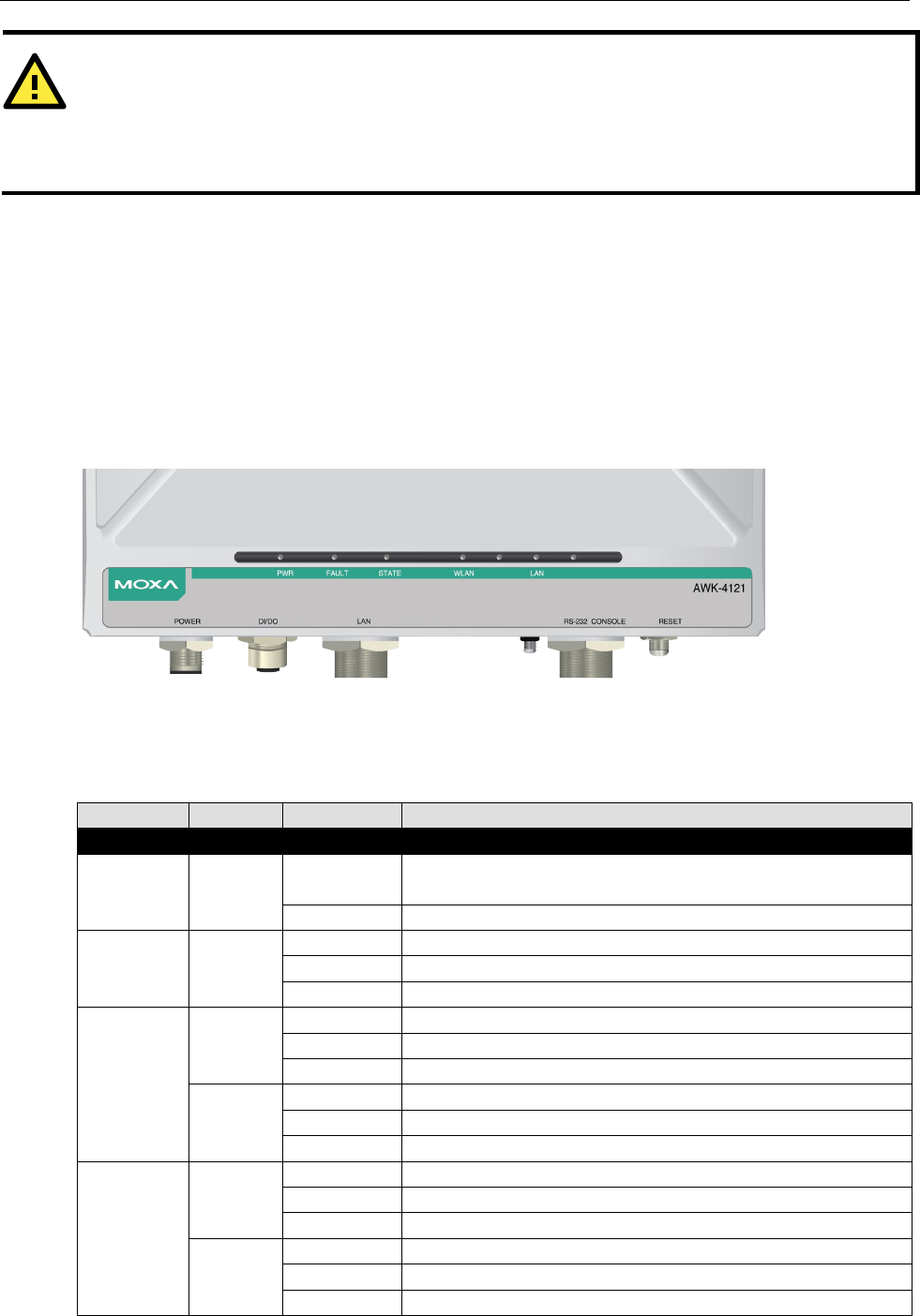
AirWorks AWK-4131A Introduction
1-5
ATTENTION
The
AWK-4131A
is NOT a portable mobile device and should be located at least 20cm away from the human
body.
The
AWK-4131A is NOT designed for the general public. To deploy AWK-4131As and establish a wireless
network safely, a well
-trained technician is required for installation.
Functional Design
LED Indicators
The LEDs on the front panel of AWK-4131A allow you to identity the status and wireless settings quickly.
The LED for FAULT indicates the system failure and user-configured events. If the AWK-4131A cannot retrieve
the IP address from a DHCP server, the FAULT LED will blink at an interval of one second.
The following table is a summary for the wireless settings and LED displays. You can check the status of the
AWK-4131A by reading these LEDs. More information about “Basic Wireless Settings” is presented in Chapter
3.
LED Color State Description
Front Panel LED Indicators (System)
PWR Green On Power is being supplied
(from power input 1 or 2, or PoE).
Off Power is not being supplied
FAULT Red
Blink (slow) Cannot get an IP address from the DHCP server (interval: 1 sec)
Blink (fast) IP address conflict (interval: 0.5 sec)
Off Error condition does not exist.
WLAN
Green
On WLAN functions is in Client/Slave mode.
Blink WLAN’s data communication is run in Client/Slave mode
Off WLAN is not in use or not working properly
Amber
On WLAN functions in AP/Bridge mode.
Blink WLAN’s data communication is run in AP/Master mode
Off WLAN is not in use or not working properly.
LAN
Green
On LAN port’s 100Mbps link is active.
Blink Data is being transmitted at 100Mbps
Off LAN port’s 100Mbps link is inactive.
Amber
On LAN port’s 10Mbps link is active.
Blink Data is being transmitted at 10Mbps
Off LAN port’s 10Mbps link is inactive.
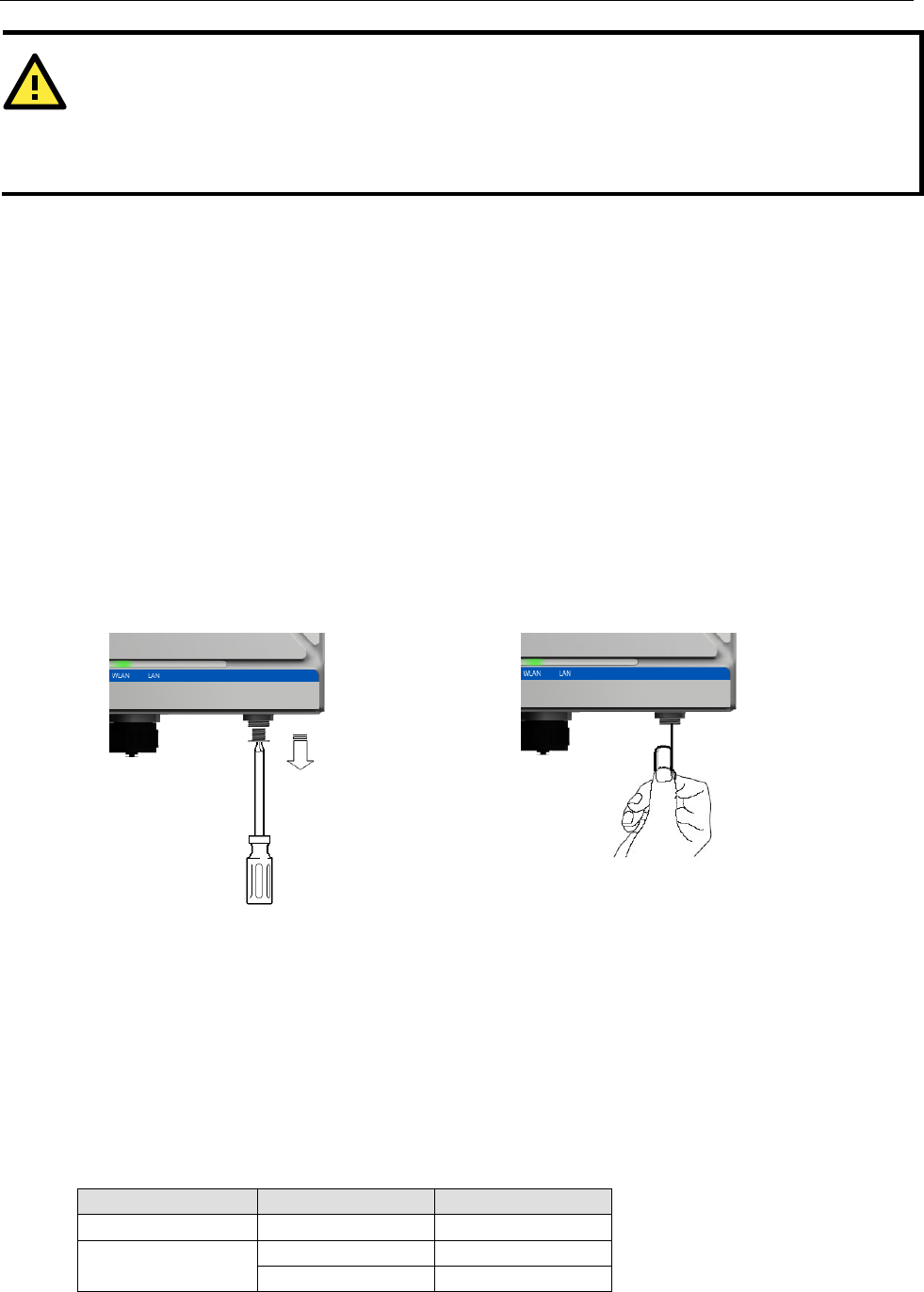
AirWorks AWK-4131A Introduction
1-6
ATTENTION
When the LEDs for STATE (Green), FAULT, and WLAN all light up simultaneously and blink at one
-second
intervals, it means the system failed to boot. This may be due to improper operation or uncontrollable issues,
such as an unexpected shutdown during firmware update. To recover the firmware, refer to “Firmware
Recovery” in Chapter 6.
Beeper
The beeper signals that the system is ready with two short beeps.
Reset Button
The RESET button is located on the bottom panel of the AWK-4131A. You can reboot the AWK-4131A or reset
it to factory default settings by pressing the RESET button with a pointed object such as an unfolded paper clip.
• System reboot: Hold the RESET button down for under 5 seconds and then release.
• Reset to factory default: Hold the RESET button down for over 5 seconds until the STATE LED starts
blinking green. Release the button to reset the AWK-4131A.
STEP 1:
Remove the reset button cover.
STEP 2:
Using a pointed object, press and hold the reset
button.
Relay (Digital Output)
The AWK-4131A has one relay output, which consists of the 2 contacts for the 8-pin M12 connector on the
bottom panel, as shown below. These relay contacts forward system failure and user-configured events.
The two wires attached to the relay contacts form an open circuit when a user-configured event is triggered. If
a user-configured event does not occur, the relay circuit will remain closed. For safety reason, the relay circuit
is kept open when the AWK-4131A is not powered.
The AWK-4131A’s relay status is summarized as follows:
Power Status Event Relay
Off --- Open
On Yes Open
No Short
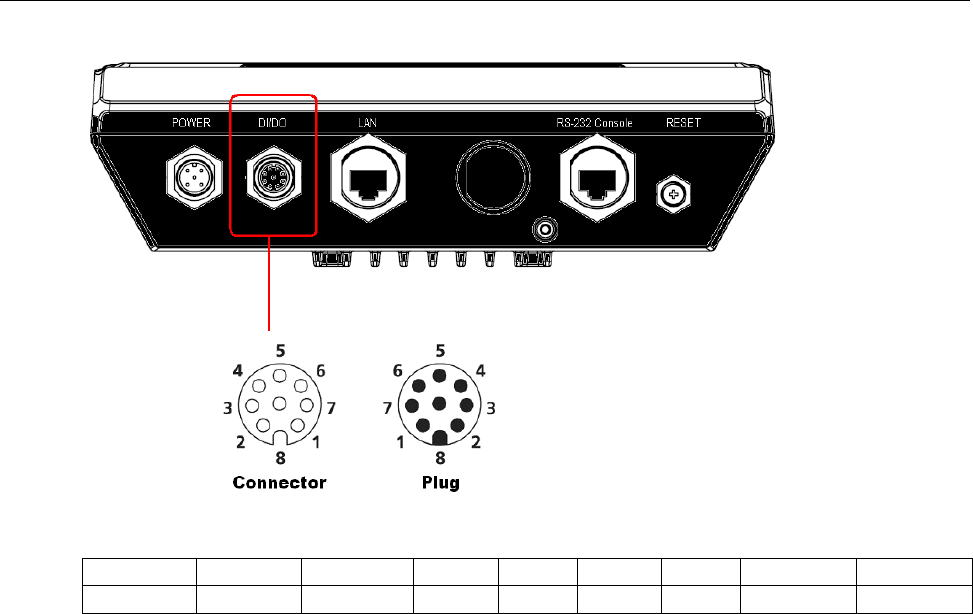
AirWorks AWK-4131A Introduction
1-7
Digital Inputs and Relay-out Pin Assignment (8-pin M12 connector)
PIN 1 2 3 4 5 6 7 8
Function DOUT_I DOUT_O DI0+ DI0- DI1+ DI1- reserved reserved

2
2. Getting Started
This chapter explains how to install Moxa’s AirWorks AWK-4131A for the first time, quickly set up your wireless
network, and test whether the connection is running well. With the function guide, you can easily locate the
functions you need.
The following topics are covered in this chapter:
First-time Installation and Configuration
Communication Testing
Function Guide
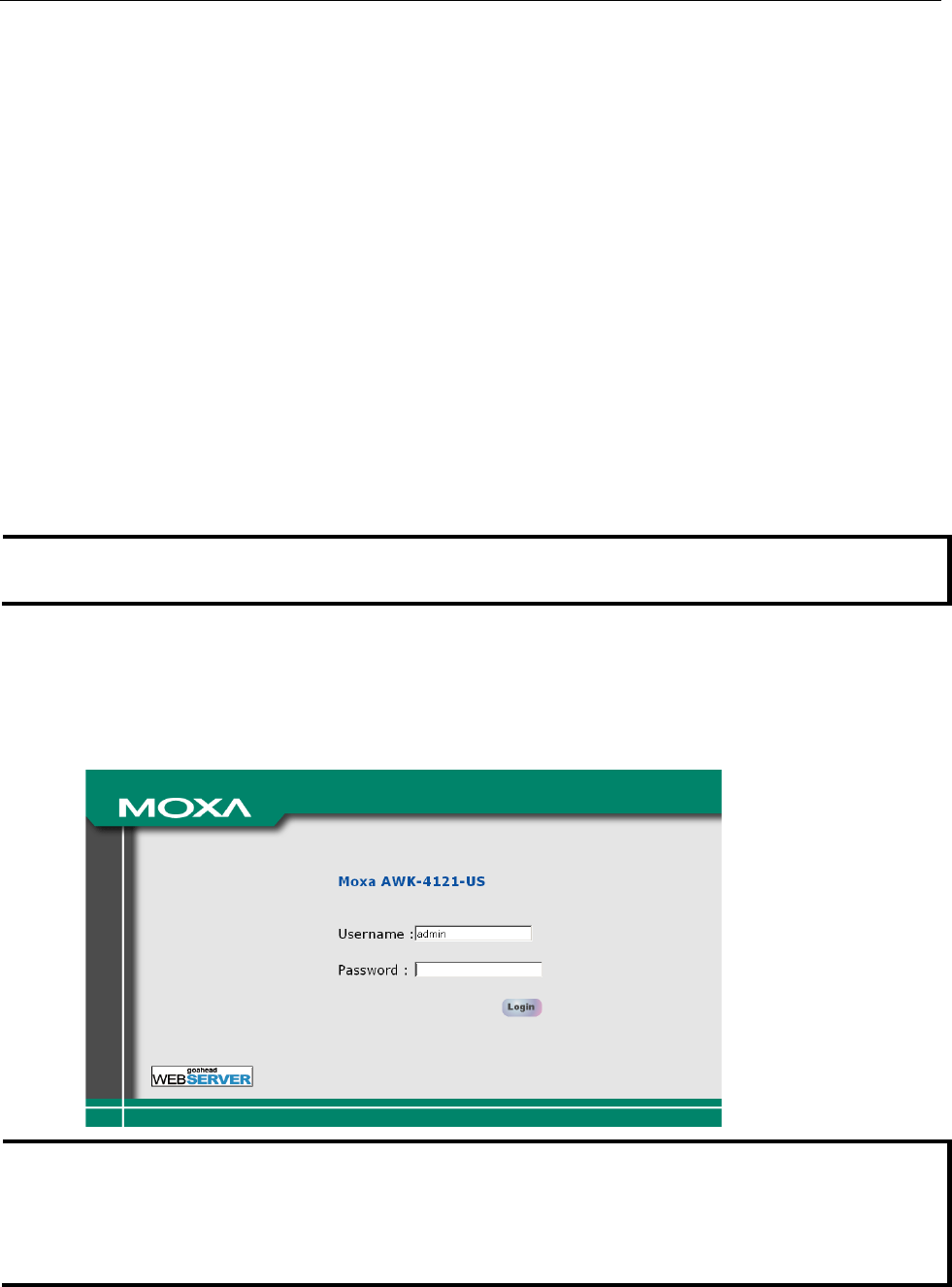
AirWorks AWK-4131A Getting Started
2-2
First-time Installation and Configuration
Before installing the AWK-4131A, make sure all items in the Package Checklist are in the box. In addition, you
will need access to a notebook computer or PC equipped with an Ethernet port. The AWK-4131A has a default
IP address that you must use when connecting to the device for the first time.
Step 1: Select the power source.
The AWK-4131A can be powered by DC power input or PoE (Power over Ethernet). The AWK-4131A will use
whichever power source you choose.
Step 2: Connect the AWK-4131A to a notebook or PC.
Since the AWK-4131A supports MDI/MDI-X auto-sensing, you can use either a straight-through cable or
crossover cable to connect the AWK-4131A to a computer. If the LED indicator on AWK-4131A’s LAN port lights
up, it means the connection is established.
Step 3: Set up the computer’s IP address.
Set an IP address on the same subnet as the AWK-4131A. Since the AWK-4131A’s default IP address is
192.168.127.253, and the subnet mask is 255.255.255.0, you should set the IP address of the computer to
192.168.127.xxx.
NOTE
After you select
Maintenance Load Factory Default and click the Submit button, the AWK-4131A
will be
reset to factory default settings and the IP address will be also reset to
192.168.127.253.
Step 4: Use the web-based manager to configure AWK-4131A
Open your computer’s web browser and type http://192.168.127.253 in the address field to access the
homepage of the web-based Network Manager. Before the homepage opens, you will need to enter the user
name and password as shown in the following figure. For first-time configuration, enter the default user name
and password and then click on the Login button:
NOTE
Default user name and password:
User Name: admin
Password: root
For security reasons, we strongly recommend changing the default password. To do so, select Maintenance >
Password, and then follow the on
-screen instructions to change the password.
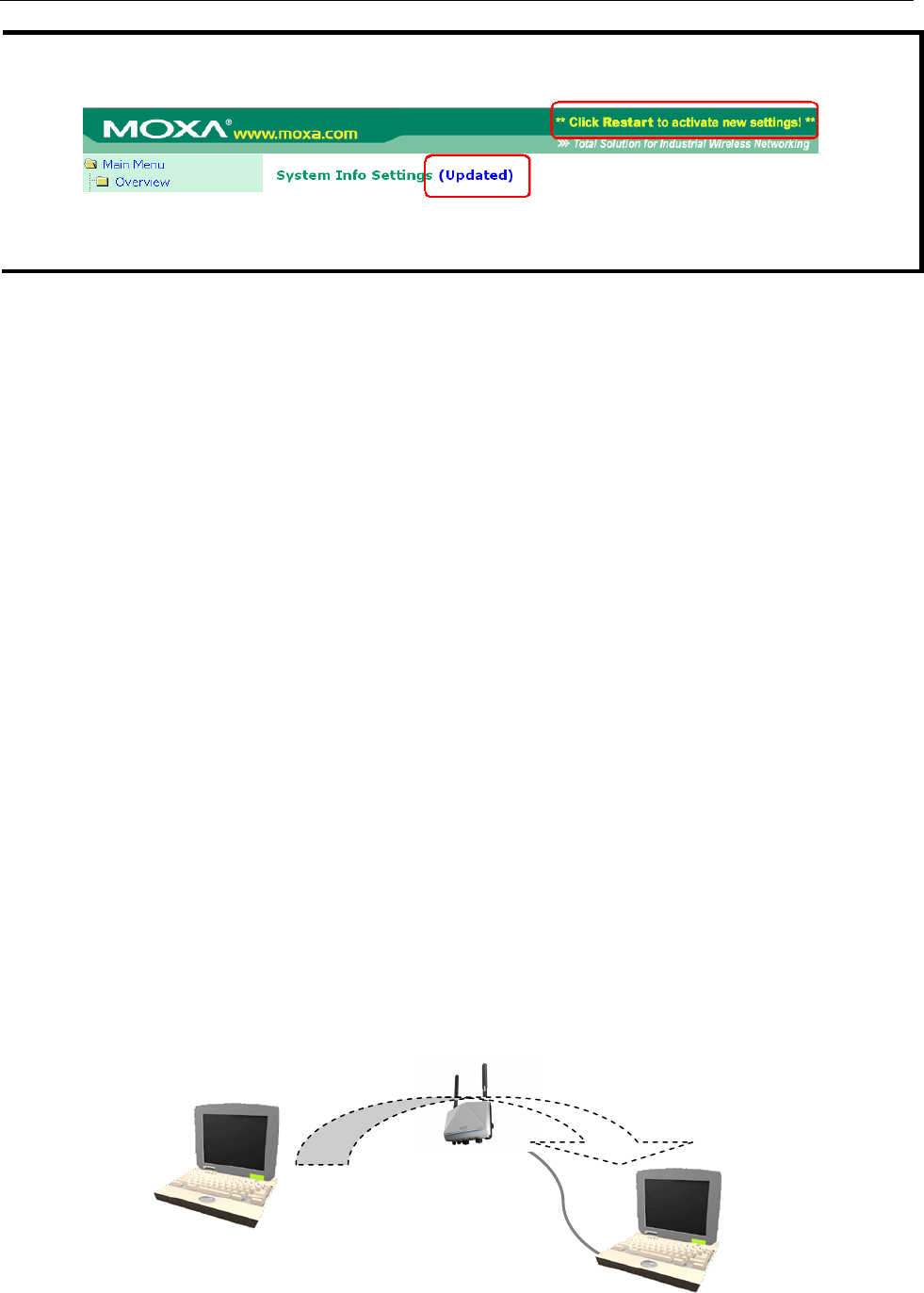
AirWorks AWK-4131A Getting Started
2-3
NOTE
Clicking
Submit will apply your changes refresh the web page. The string “(Updated)” and a blinking
reminder will appear in the upper
-right corner of web page, as follows.
To make the changes effective, click Restart and then Save and Restart after you change the settings. It will
take about 30 seconds for the
AWK-4131A to restart.
Step 5: Select the operation mode for the AWK-4131A.
By default, the AWK-4131A’s operation mode is set to AP. You can change the setting in Wireless Settings
→
Basic Wireless Settings if you would like to use the Client mode instead. Detailed information about
configuring the AWK-4131A’s operation can be found in Chapter 3.
Step 6: Test communications.
We will describe 2 test methods to make sure the network connection has been established. Please refer to the
following section for more details.
Communication Testing
After installation, you can run a sample test to make sure the AWK-4131A and wireless connection are
functioning normally. Two testing methods are explained in the following sections. Use the first method if you
are using only one AWK-4131A device, and use the second method if you are using two or more AWK-4131As.
Testing Method for one AWK-4131A
If you are only using one AWK-4131A, you will need a second notebook computer equipped with a WLAN card.
Configure the WLAN card to connect to the AWK-4131A (NOTE: the default SSID is MOXA), and change the IP
address of the second notebook (B) so that it is on the same subnet as the first notebook (A), which is
connected to the AWK-4131A.
After configuring the WLAN card, establish a wireless connection with the AWK-4131A and open a DOS window
on Notebook B. At the prompt, type
ping <IP address of notebook A>
and then press Enter (see the figure below). A “Reply from IP address …” response means the communication
was successful. A “Request timed out.” response means the communication failed. In this case, recheck the
configuration to make sure the connections are correct.
Notebook B
IP: 192.168.127.1
SSID: Moxa
Notebook A
IP: 192.168.127.2
PING
AWK-4131A
IP: 192.168.127.253
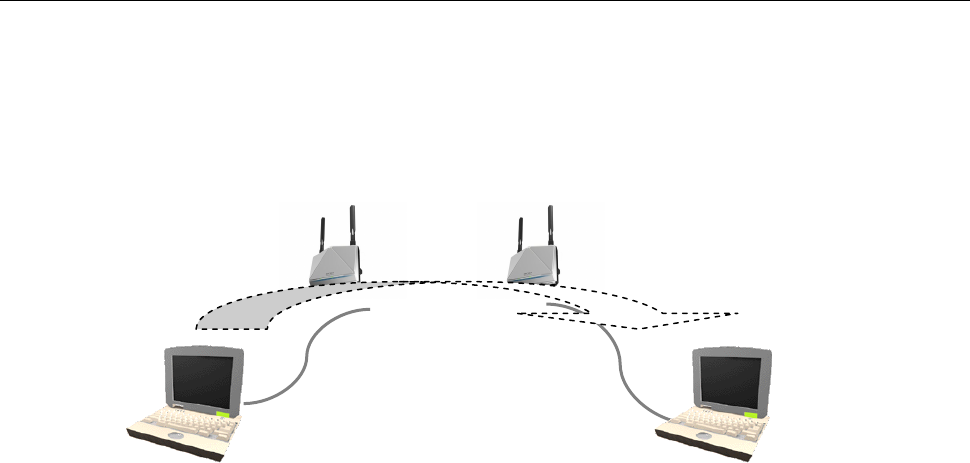
AirWorks AWK-4131A Getting Started
2-4
Testing Method for two or more AWK-4131As
If you have two or more AWK-4131As, you will need a second notebook computer (B) equipped with an
Ethernet port. Use the default settings for the first AWK-4131A connected to notebook A and change the
second or third AWK-4131A connected to notebook B to Client mode. Then, configure the notebooks and
AWK-4131As properly.
After setting up the testing environment, open a DOS window on notebook B. At the prompt, type
ping <IP address of notebook A>
and then press Enter. A “Reply from IP address …” response means the communication was successful. A
“Request timed out” response means the communication failed. In this case, recheck the configuration to make
sure the connections are correct.
PING
Notebook B
IP: 192.168.127.1
Notebook A
IP: 192.168.127.2
SSID
: Moxa AWK-4131A / AP
IP:192.168.127.253
AWK-4131A / Client
IP: 192.168.127.252

AirWorks AWK-4131A Getting Started
2-5
Function Guide
The management functions are categorized in a tree and shown in the left field of the web-based management
console. You can efficiently locate the function you need with the following guide.
Quick overview of the AWK-4131A’s status
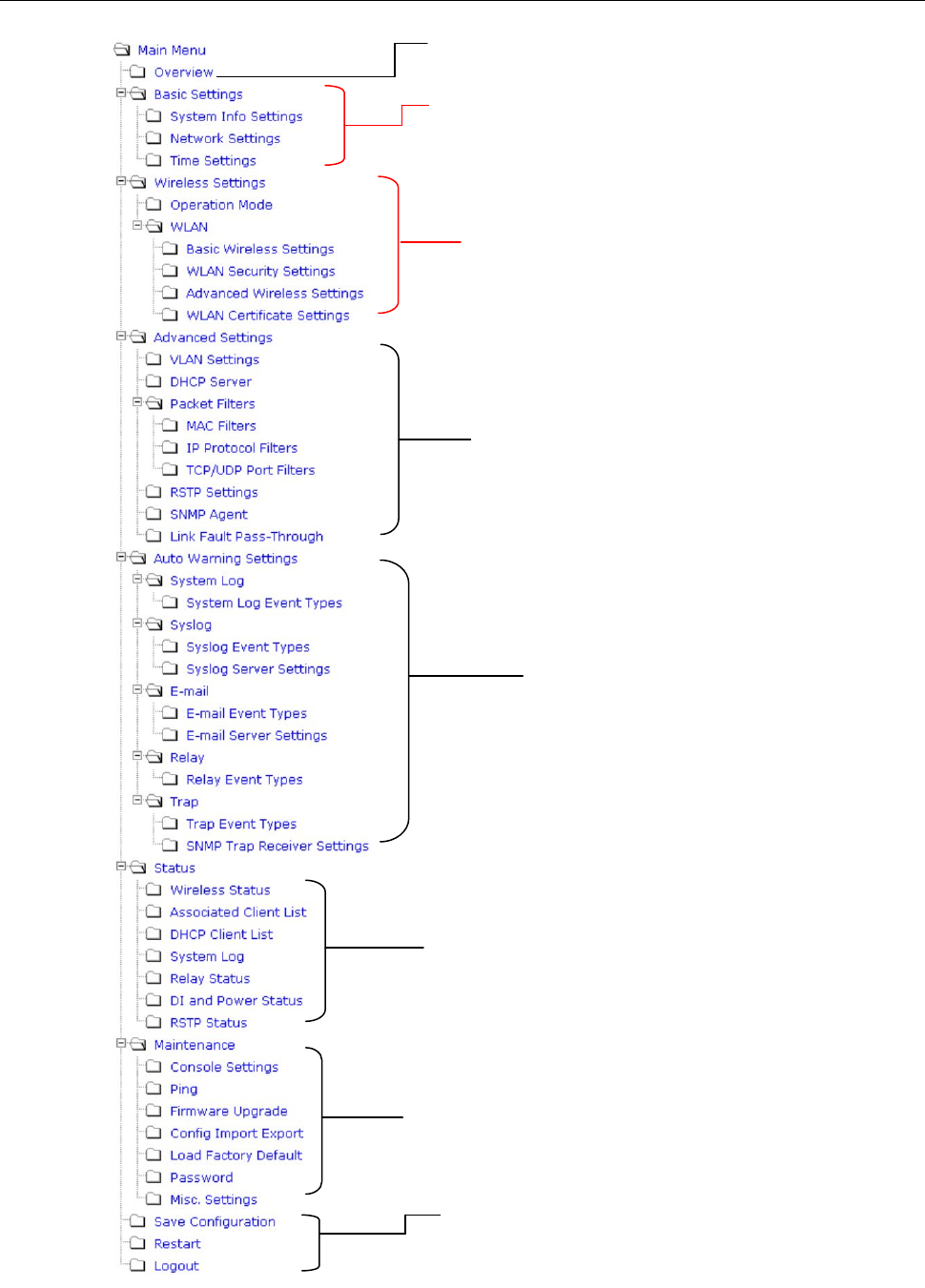
AirWorks AWK-4131A Getting Started
2-6
Basic settings for administering the AWK-4131A
Essential settings related to establishing a
wireless network
Advanced features to support additional network
management and secure wired and wireless
communication
Note: These advanced functions are all optional.
Application-oriented device management
functions to set up events, traps, and
reactions via relay warning, e-mail, and
SNMP notification
Note: These functions are all optional.
Real-time status information for monitoring
wired/wireless network performance, advanced
services, and device management functions.
Functions for maintaining the AWK-4131A, and for
diagnosing the network.
On-demand functions to support the web-based
console management operation.

3
3. Web Console Configuration
In this chapter, we will explain each web management page of the web-based console configuration. Moxa’s
easy-to-use management functions will help you set up your AWK-4131A, as well as establish and maintain
your wireless network easily.
The following topics are covered in this chapter:
Configuration by Web Browser
Overview
Basic Settings
System Info Settings
Network Settings
Time Settings
Wireless Settings
Operation Mode
Basic Wireless Settings
WLAN Security Settings
Advanced Wireless Settings
WLAN Certification Settings (for EAP-TLS in
Client mode only)
Advanced Settings
Using Virtual LAN
The Virtual LAN (VLAN) Concept
Configuring Virtual LAN
DHCP Server (for AP mode only)
Packet Filters
RSTP Settings (
for WDS, Maste, or Slave mode
only)
SNMP Agent
Link Fault Pass-Through (for Client/Slave
mode only)
Auto Warning Settings
System Log
Syslog
E-mail
Relay
Trap
Status
Wireless Status
Associated Client List (for AP mode only)
DHCP Client List (for AP mode only)
System Log
Relay Status
DI and Power Status
Maintenance
Console Settings
Ping
Firmware Upgrade
Config Import Export
Load Factory Default
Password
Misc. Settings
Save Configuration
Restart
Logout
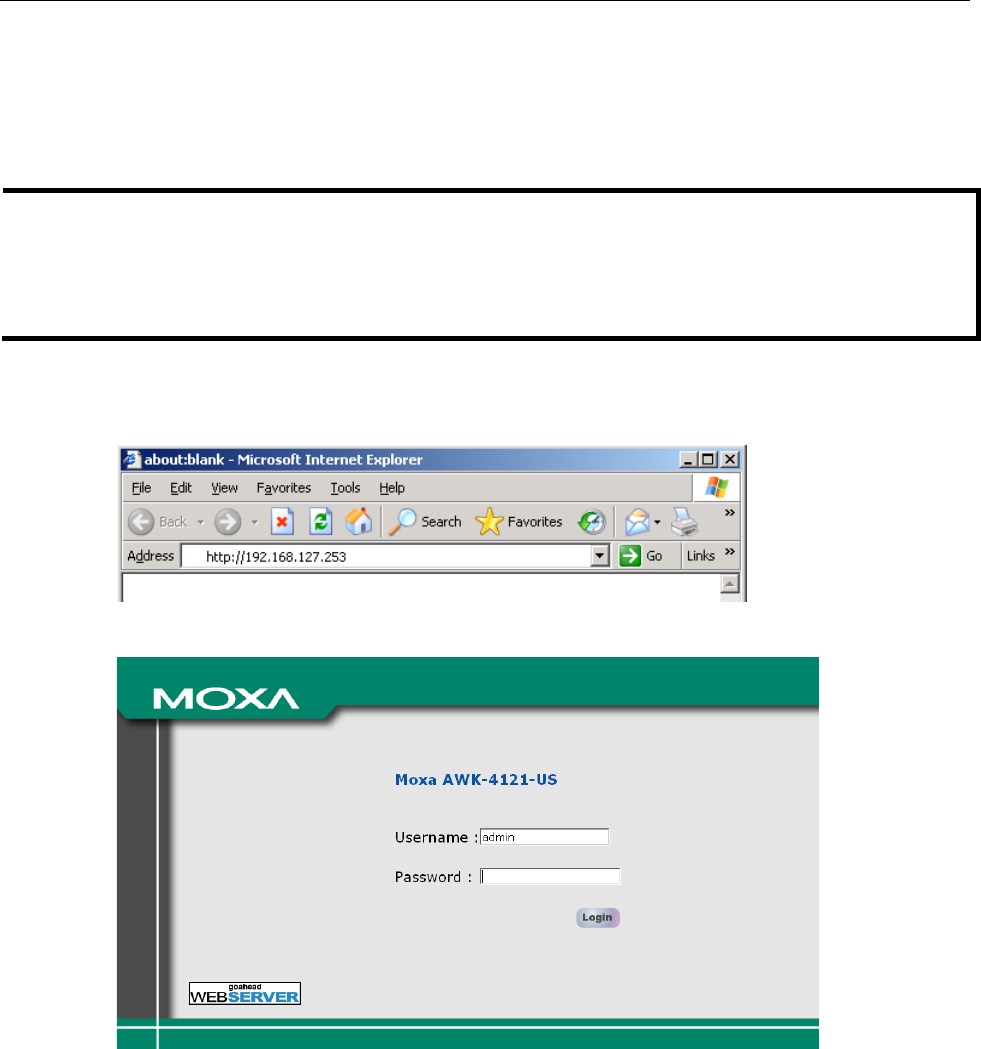
AirWorks AWK-4131A Web Console Configuration
3-2
Configuration by Web Browser
Moxa AWK-4131A’s web browser interface provides a convenient way to modify its configuration and access
the built-in monitoring and network administration functions. The recommended web browser is Microsoft®
Internet Explorer 7.0 or 8.0 with JVM (Java Virtual Machine) installed.
NOTE
To use the
AWK-4131A’s management and monitoring functions from a PC
host connected to the same LAN as
the
AWK-4131A, you must make sure that the PC host and AWK-4131A are on the same logical subnet.
Similarly, if the
AWK-4131A
is configured for other VLAN settings, you must make sure your PC host is on the
management VLAN
.
The Moxa
AWK-4131A’s default IP address is 192.168.127.253.
Follow the steps below to access the AWK-4131A’s web-based console management.
1. Open your web browser (ex. Internet Explorer) and type the AWK-4131A’s IP address in the address field.
Then press Enter to establish the connection.
2. The Web Console Login page will open. Enter the password (User Name is set as admin; the default
password is root if a new password has not been set.) and then click Login to continue.
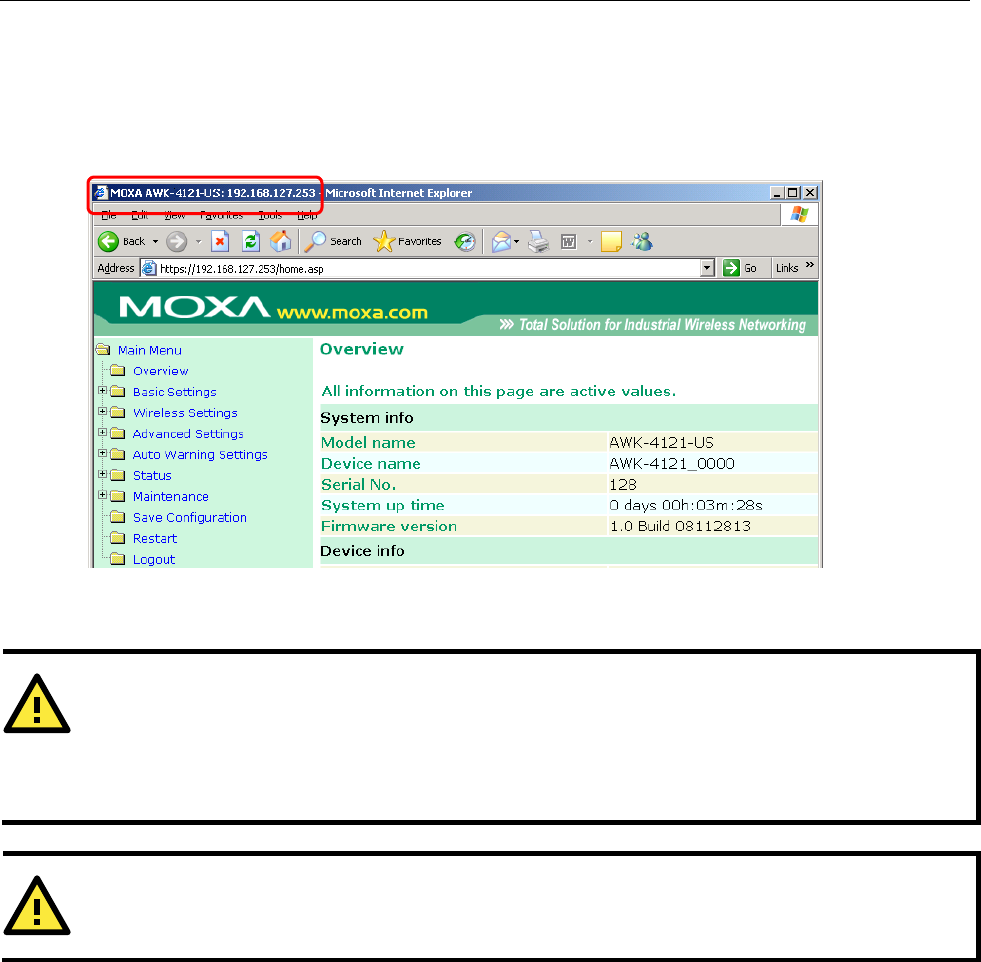
AirWorks AWK-4131A Web Console Configuration
3-3
You may need to wait a few moments for the web page to download onto your computer. Please note that the
model name and IP address of your AWK-312 are both shown in the title of the web page. This information can
help you identify multiple AWK-4131As.
You can use the menu tree on the left side of the window to open the function pages to access each of
AWK-4131A’s functions.
In the following paragraphs, we will go through each of the AWK-4131A’s management functions in detail. You
can also get a quick overview of these functions in the Function Guide section of Chapter 2.
ATTENTION
The model name of the
AWK-4131A is shown as AWK-4131A-XX where XX indicates the country code. The
country code represents the
AWK-4131A version and which bandwidth it uses. We use AWK-4131A-US
as an
example in the following figures. The country code for the model name on your screen may vary if you are using
a different version (band)
AWK-4131A.
ATTENTION
For security reasons, you will need to log back into the
AWK-4131A after the 5-minute time-out.
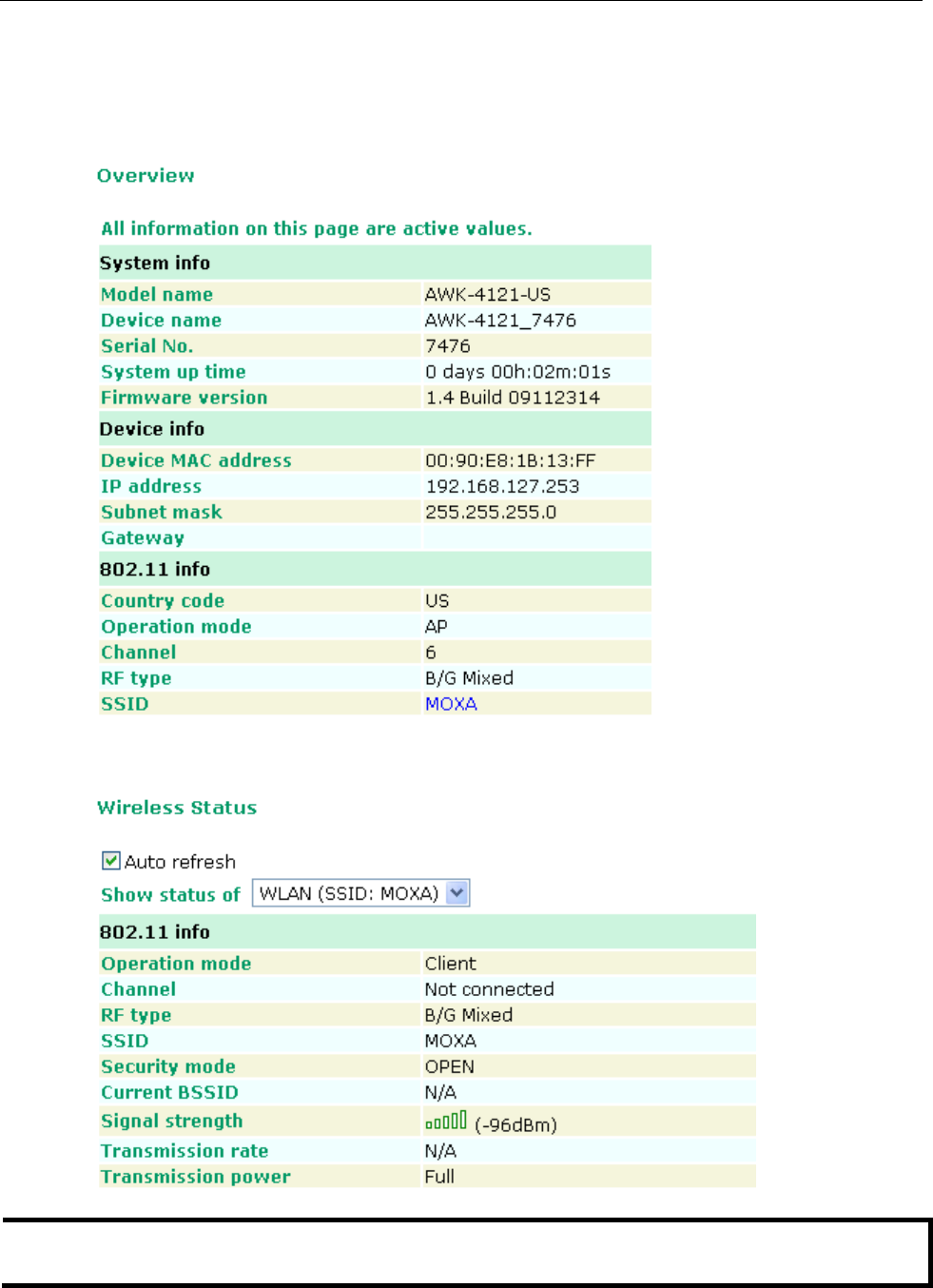
AirWorks AWK-4131A Web Console Configuration
3-4
Overview
The Overview page summarizes the AWK-4131A’s current status. The information is categorized into several
groups: System info, Device info and 802.11 info.
Click on SSID for more detailed 802.11 information, as shown in the following figure.
NOTE
The 802.11 info that is displayed may be different for different operation modes. For example, “Current BSSID”
is not available in C
lient mode, and “Signal strength” is not available in AP mode.
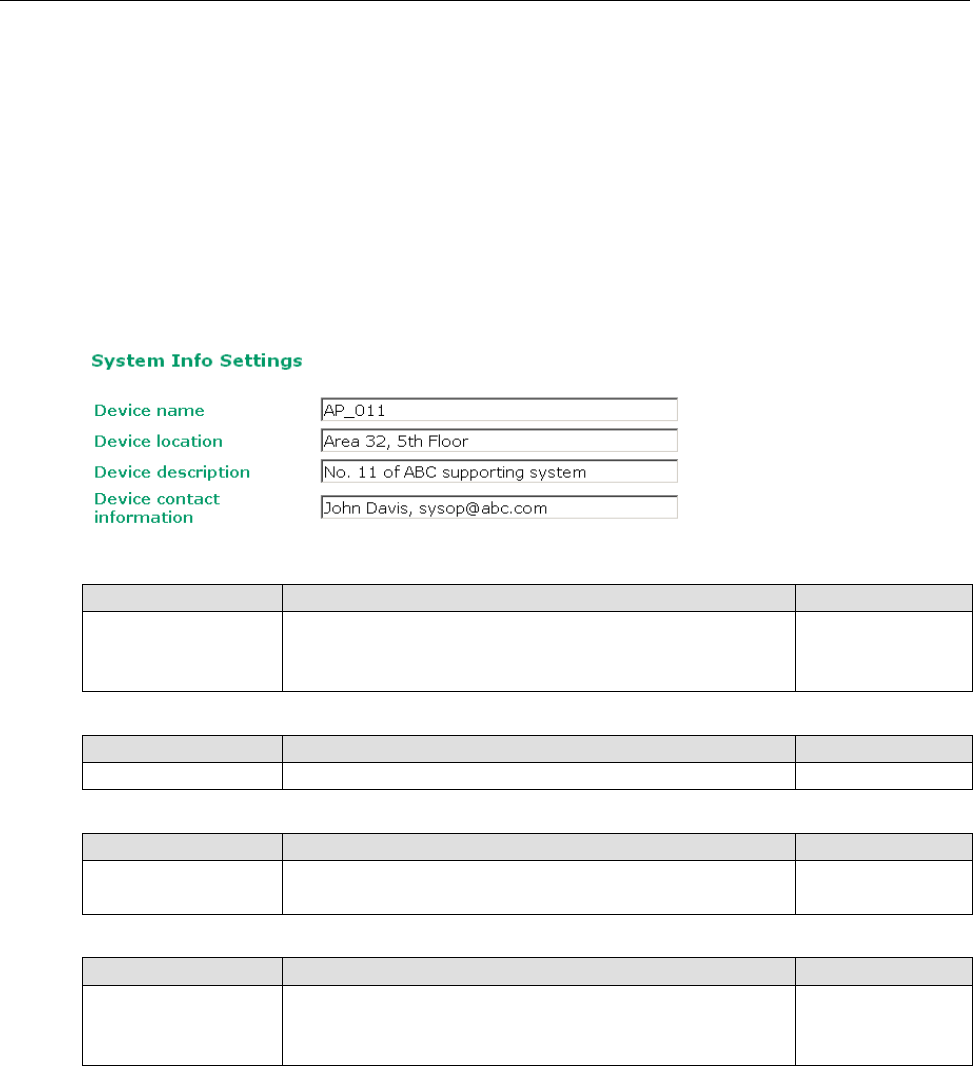
AirWorks AWK-4131A Web Console Configuration
3-5
Basic Settings
The Basic Settings group includes the most commonly used settings required by administrators to maintain and
control the AWK-4131A.
System Info Settings
The System Info items, especially Device name and Device description, are displayed and included on the
Overview page, SNMP information, and alarm emails. Setting System Info items makes it easier to identify
the different AWK-4131As connected to your network.
Device name
Setting Description Factory Default
Max. 31 Characters This option is useful for specifying the role or application of
different AWK-4131A units. AWK-4131A_<Serial
No. of this
AWK-4131A>
Device location
Setting Description Factory Default
Max. 31 Characters This specifies the location of different AWK-4131A units. None
Device description
Setting Description Factory Default
Max. 31 Characters Use this space to record more detailed description of
AWK-4131A. None
Device name
Setting Description Factory Default
Max. 31 Characters To provide information about whom to contact in order to
resolve problems, use this space to record contact information
of the person responsible for maintaining this AWK-4131A.
None
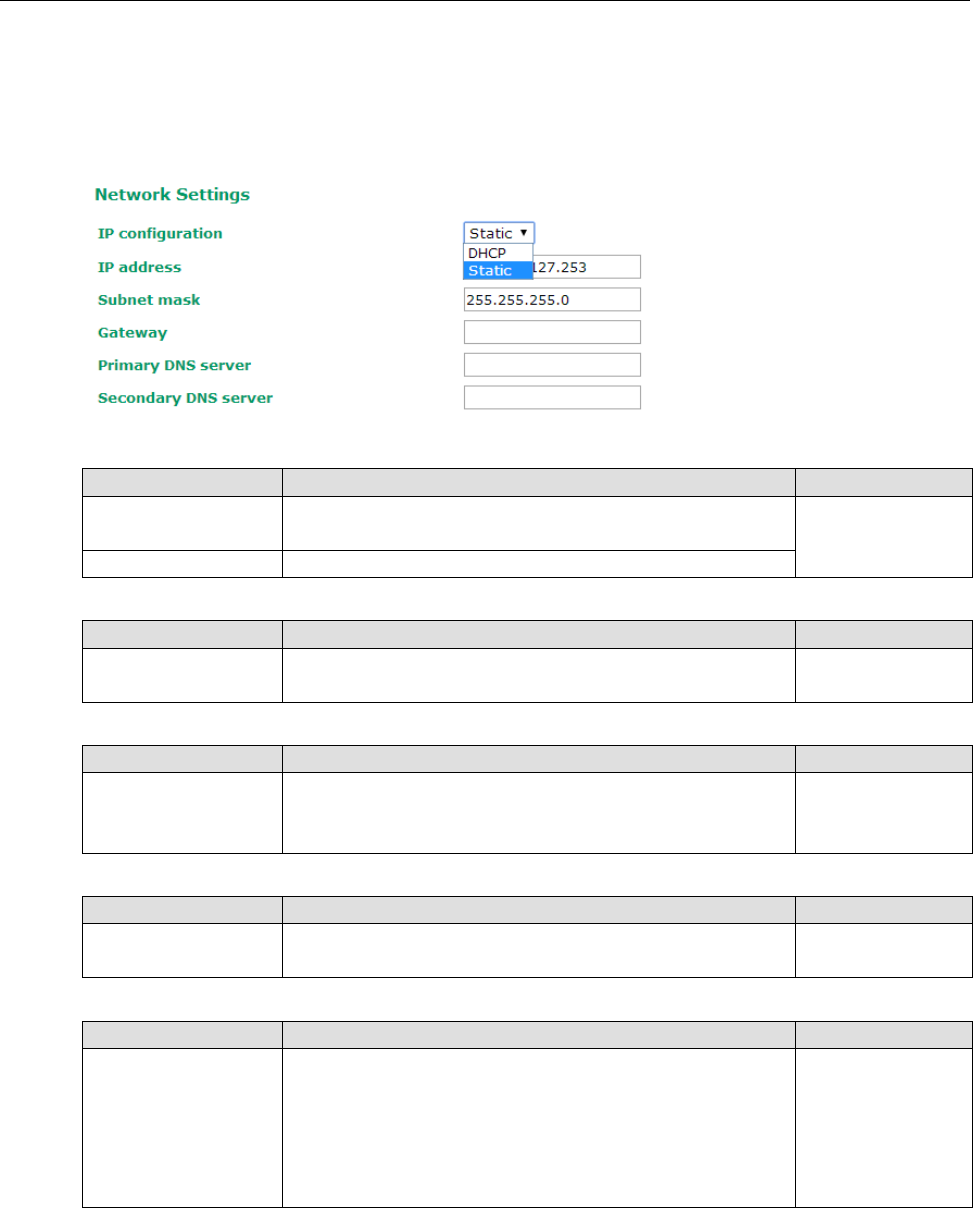
AirWorks AWK-4131A Web Console Configuration
3-6
Network Settings
The Network Settings configuration allows you to modify the usual TCP/IP network parameters. An explanation
of each configuration item is given below.
IP configuration
Setting Description Factory Default
DHCP The AWK-4131A’s IP address will be assigned
automatically by
the network’s DHCP server Static
Static Set up the AWK-4131A’s IP address manually.
IP address
Setting Description Factory Default
AWK-4131A’s IP
address Identifies the AWK-4131A on a TCP/IP network. 192.168.127.253
Subnet mask
Setting Description Factory Default
AWK-4131A’s subnet
mask Identifies the type of network to which the AWK-4131A is
connected (e.g., 255.255.0.0 for a Class B network, or
255.255.255.0 for a Class C network).
255.255.255.0
Gateway
Setting Description Factory Default
AWK-4131A’s default
gateway The IP address of the router that connects the LAN to an
outside network. None
Primary/ Secondary DNS server
Setting Description Factory Default
IP address of Primary/
Secondary DNS server
The IP address of the DNS Server used by your network. After
entering the DNS Server’s IP address, you can input the
AWK-4131A’s URL (e.g., http://ap11.abc.com) in your
browser’s address field instead of entering the IP address. The
Secondary DNS server will be used if the Primary DNS server
fails to connect.
None
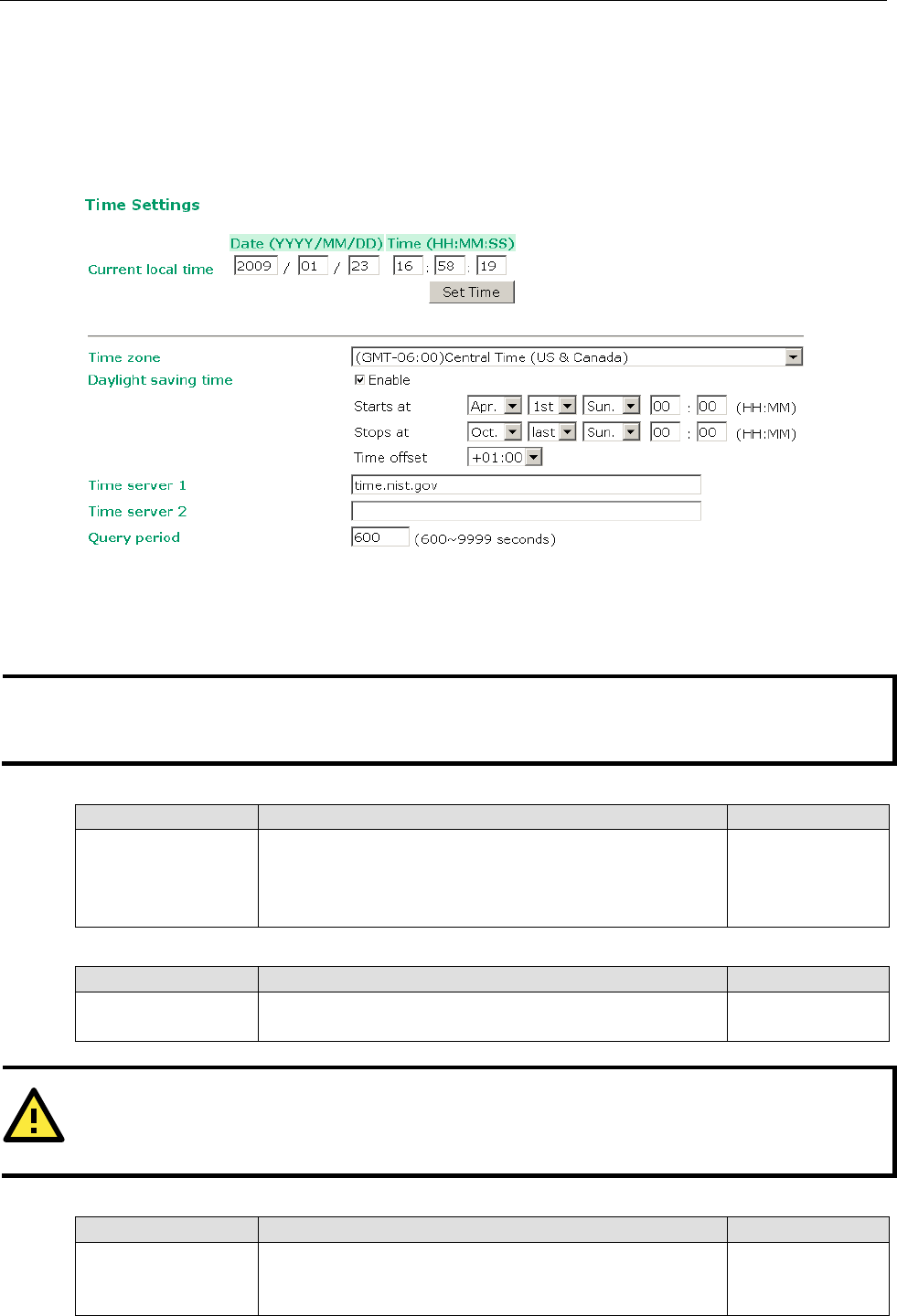
AirWorks AWK-4131A Web Console Configuration
3-7
Time Settings
The AWK-4131A has a time calibration function based on information from an NTP server or user specified Date
and Time information. Functions such as Auto warning can add real-time information to the message.
Current local time shows the AWK-4131A’s system time when you open this web page. You can click on the
Set Time button to activate the update after setting up the date and time parameters. An “(Updated)” string
will appear to indicate that the change is complete. Local time settings will be immediately activated in the
system without running Save and Restart.
NOTE
The
AWK-4131A
has a real time clock (RTC). Users are strongly recommended to update the Local time for the
AWK
-4131A after initial setup or long-term shutdown, especially when the net
work does not have an Internet
connection for accessing the NTP server or there is no NTP server on the LAN.
Current local time
Setting Description Factory Default
User adjustable time The date and time parameters allow configuration of the local
time with aimmediate activation. None
(yyyy/mm/dd
hh:mm:ss format;
24-hour format.)
Time zone
Setting Description Factory Default
User selectable time
zone The time zone setting allows conversion from GMT (Greenwich
Mean Time) to local time. GMT (Greenwich
Mean Time)
ATTENTION
Changing the time zone will automatically adjust the Current local time. You should configure the Time zone
before setting the Current local time.
Daylight saving time
Setting Description Factory Default
Enable/ Disable Daylight saving time (also know as DST or summer time)
involves advancing clocks (usually 1hour) during the summer
time to provide an extra hour of daylight in the afternoon.
Disable

AirWorks AWK-4131A Web Console Configuration
3-8
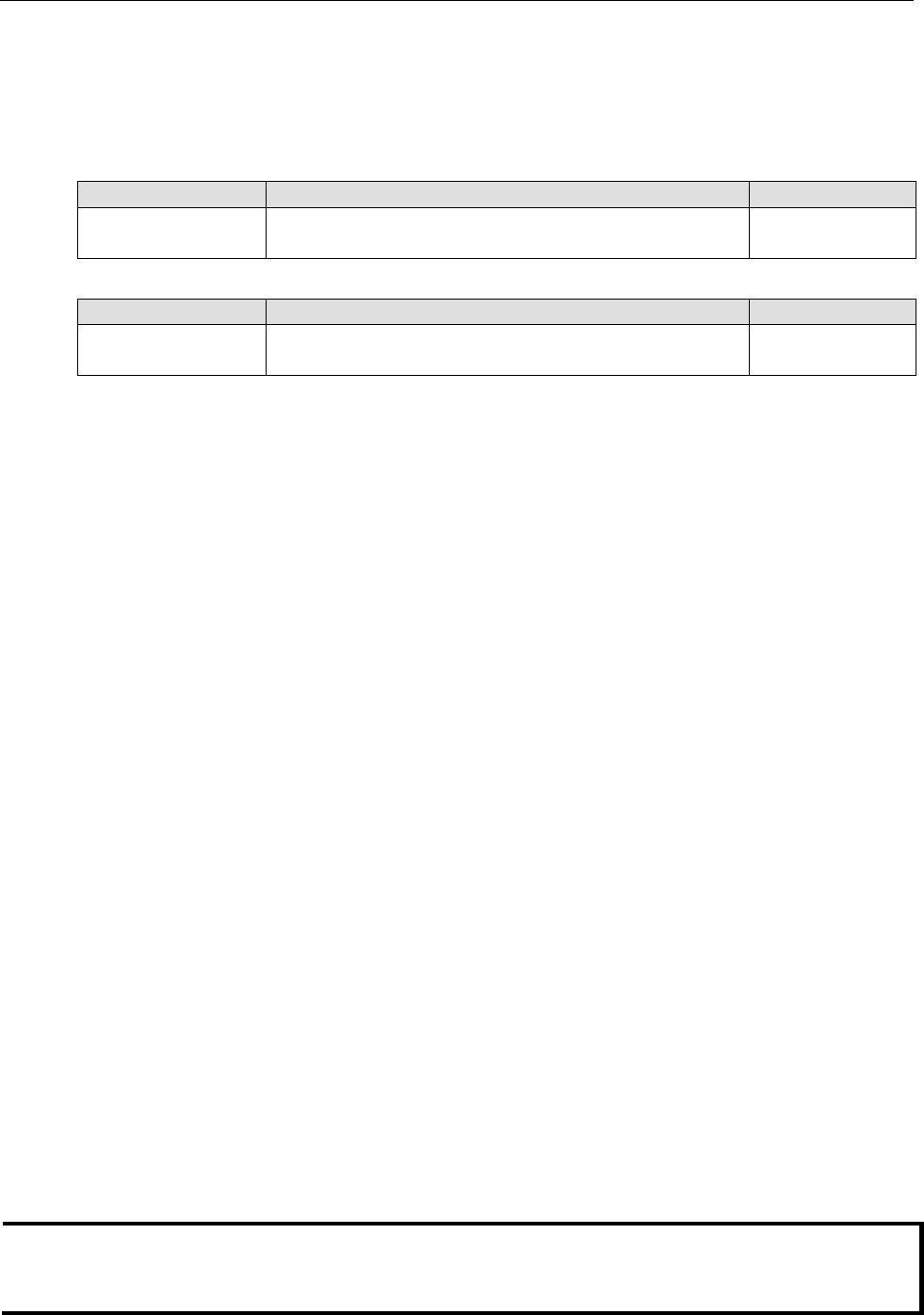
AirWorks AWK-4131A Web Console Configuration
3-9
When Daylight Saving Time is enabled, the following parameters are shown:
• The Starts at parameter allows users to enter the date that daylight saving time begins.
• The Stops at parameter allows users to enter the date that daylight saving time ends.
• The Time offset parameter indicates how many hours forward the clock should be advanced.
Time server 1/ 2
Setting Description Factory Default
The 1st/ 2nd time
server IP/Name IP or Domain address of NTP time server. The 2nd time will be
used if the 1st NTP server fails to connect. time.nist.gov
Query period
Setting Description Factory Default
Query period time
(1- 9999 seconds) This parameter determines how often the time is updated from
the NTP server. 600 (seconds)
Wireless Settings
The essential settings for wireless networks are presented in this function group. Settings must be properly set
before establishing your wireless network. Familiarize yourself with the following terms before starting the
configuration process:
AP/Bridge: This mode provides both Access Point and Static LAN-to-LAN Bridging functionality. The static
LAN-to-LAN bridging function is supported by the Wireless Distribution System (WDS).
Client: This mode is for Dynamic LAN-to-LAN Bridging or Device-to-LAN scenarios. The Client automatically
establishes bridge links with other APs.
In either AP/Bridge or Client mode, the AWK-4131A forwards packets between its Ethernet interface (LAN) and
wireless interface (WLAN) to connect wired hosts on the Ethernet side with wireless host(s) on the wireless side.
There are two types of wireless links specified by the IEEE802.11 standard:
• STA-AP: This type of wireless link is established between an IEEE802.11 Station (STA) and an IEEE802.11
Access Point (AP). An STA is usually a client computer (PC or PDA) with a WLAN network interface card
(NIC). The Client mode is actually an STA.
• WDS: This type of wireless link is established between two IEEE802.11 APs. Wireless packets transmitted
along the WDS link comply with the IEEE802.11 WDS (Wireless Distribution System) format at the link layer.
Refer to the “Wireless Distribution System (WDS)” section in Chapter 5 for details. Keep in mind that
WPA/WPA2 CANNOT be supported in WDS.
To establish a static bridge link based on the WDS, the APs at both end of the WDS link must be configured
manually with each other’s MAC addresses. To establish a dynamic bridge link between an AP and a Client, both
devices must be configured with the same channel, and security settings (see “WLAN Security Settings” for
details). Moreover, the same SSID is also needed for clients that roam the APs in Bridge mode. The Client
automatically scans for any AP that is using the matched SSID and establishes a bridge link with the scanned
AP.
When the AWK-4131A is configured for Client mode, it can be used as an Ethernet-to-wireless (or
LAN-to-WLAN) network adapter. For example, a notebook computer equipped with an Ethernet adaptor but no
wireless card can be connected to this device with an Ethernet cable to provide wireless connectivity to another
AP.
NOTE
Although it is more convenient to use dynamic bridging, there is a limitation
—the Client can only transmit
IP
-based packets between its wireless interface (WLAN) and Ethernet interface (LAN); other types of traffic
(such as IPX and AppleTalk) are not forwa
rded.
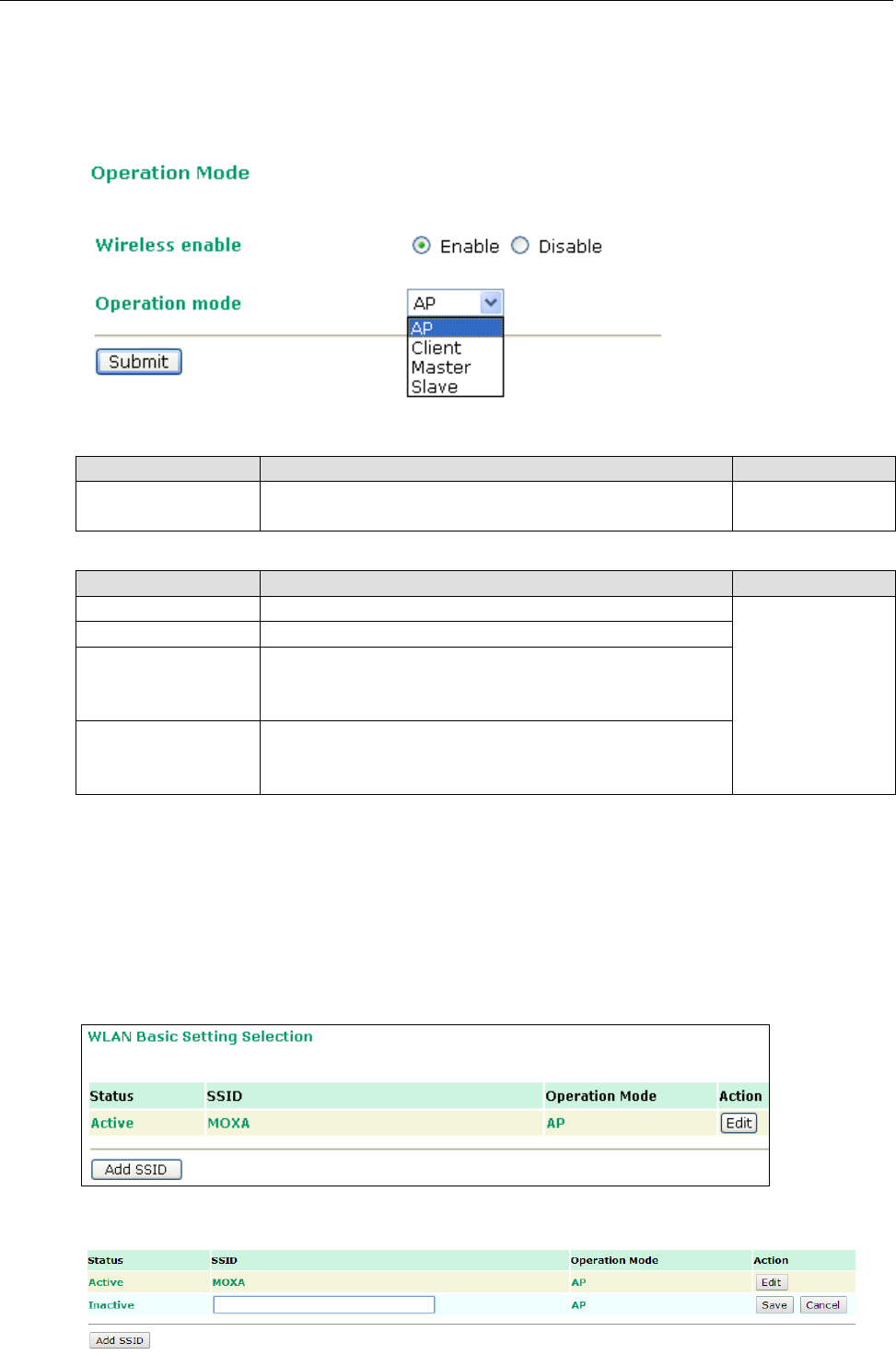
AirWorks AWK-4131A Web Console Configuration
3-10
Operation Mode
The AWK-4131A supports four main operation modes—Client, AP, Master, and Slave—each of which plays a
distinct role on the wireless network.
Wireless Enable
Setting Description Factory Default
Enable/Disable The RF (Radio Frequency) module can be manually turned on or
off. This function is available in AP operation mode only. Enable
Operation Mode
Setting Description Factory Default
AP The AWK-4131A plays the role of wireless AP/Bridge AP
Client The AWK-4131A plays the role of wireless Client
Master This mode collocates with AWK-5222/5232/6222/6232’s
Wireless bridge mode. The AWK-4131A plays the role of
wireless Master.
Slave This mode collocates with AWK-5222/5232/6222/6232’s
Wireless bridge mode. The AWK-4131A plays the role of
wireless Slave.
Basic Wireless Settings
The “WLAN Basic Setting Selection” panel is used to add and edit SSIDs. An SSID is a unique identifier that
wireless networking devices use to establish and maintain wireless connectivity. Multiple access points on a
network or sub-network can use the same SSIDs. You can configure your AWK to use up to 9 SSIDs, and
configure each SSID differently. All of the SSIDs are active at the same time; that is, client devices can use any
of the SSIDs to associate with the access point.
Click on Add SSID to create more SSIDs.
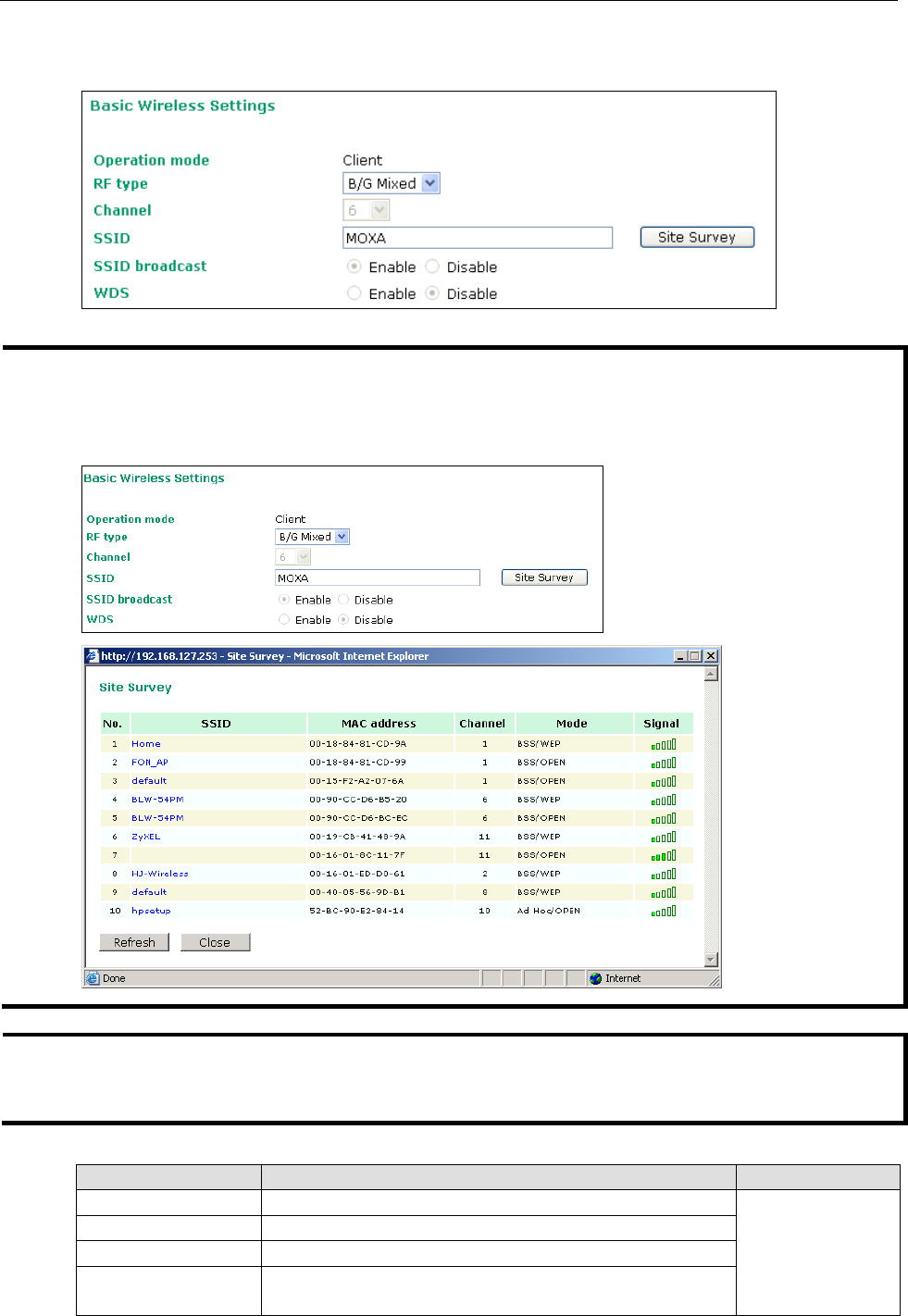
AirWorks AWK-4131A Web Console Configuration
3-11
Click on Edit to assign different configuration settings to each SSID. The configuration panel appears as
follows:
NOTE
When you switch to Client mode, a Site Survey button will be available on the Basic Wireless Settings panel.
Click the “Site Survey” button to view information about available APs, as shown in the following figure. You can
click on the SSID of an entity and bring the value of its SSID onto the SSID field of the Basic Wireless Settings
page. Click the Refresh button to re
-scan and update the table.
NOTE
If the
Gateway field in Basic Settings
Network Settings is empty, a warning message will appear,
reminding you to set the default gateway when
Client
mode is enabled. You can ignore this message if you are
only planning a local network and no packets will be sent outside the network.
RF type
Setting Description Factory Default
A Supports IEEE802.11a standard only B/G Mixed
B Supports IEEE802.11b standard only
G Supports IEEE802.11g standard only
B/G Mixed Supports both of IEEE802.11b/g standards, but 802.11g can
be slowed down when 802.11b clients are on the network
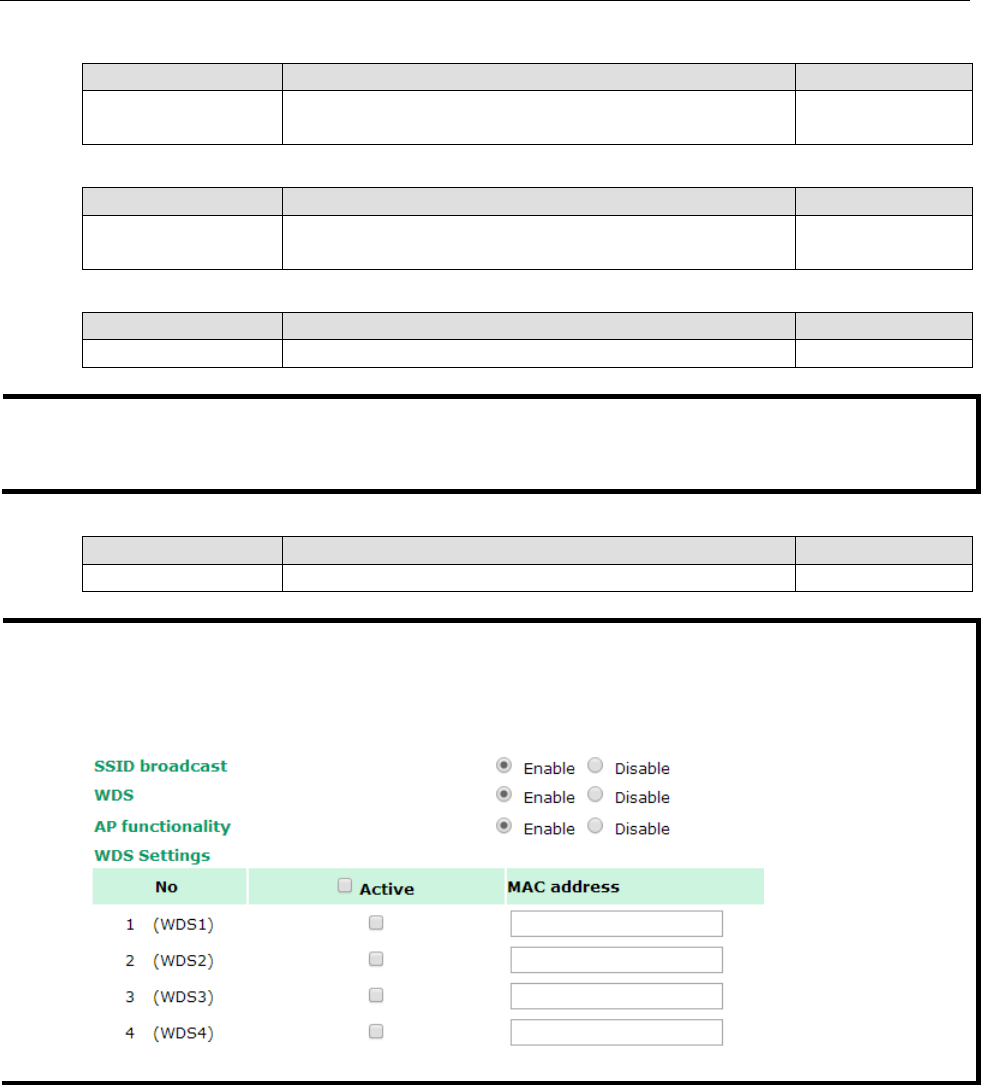
AirWorks AWK-4131A Web Console Configuration
3-12
Channel (for AP/Master mode only)
Setting Description Factory Default
Available channels vary
with RF type AWK-4131A plays a role of wireless AP. 6 (in B/G Mixed
mode)
SSID
Setting Description Factory Default
Max. 31 Characters
The SSID of a client and the SSID of the AP must be identical for
them to communicate with each other. MOXA
SSID broadcast (for AP/Master mode only)
Setting Description Factory Default
Enable/ Disable SSID can be broadcast or not. Enable
NOTE
The
AWK-4131A-JP (for Japanese frequency bands) only connects SSID-hidden APs in all IEEE802.11a
channels and IEEE802.11g channel 1 to 11. The
AWK-4131A-
EU (for European frequency bands) only connects
SSID
-hidden APs in all IEEE802.11b/g channels.
WDS (for AP mode only)
Setting Description Factory Default
Enable/ Disable AWK-4131A supports WDS or not. Disable
NOTE
When
WDS is enabled, you can choose to use a pure point-to-point WDS link by disabling AP functionality
.
The
AWK-4131A
provides 8 entities for WDS settings and can support up to 8 WDS links to other APs or wireless
bridges. The list appears when WDS
Enable is checked. Enter the MAC address to set up a WDS link.
Remember to activate a WDS link by checking the
Active check box.
WLAN Security Settings
The AWK-4131A provides four standardized wireless security modes: Open, WEP (Wired Equivalent Privacy),
WPA (Wi-Fi Protected Access) and WPA2. Several types of security models are available in AWK-4131A by
selecting Security mode and WPA type:
• Open: No authentication, no data encryption.
• WEP: Static WEP (Wired Equivalent Privacy) keys must be manually configured.
• WPA/WPA2-Personal: Also known as WPA/WPA2-PSK. You need to specify the Pre-Shared Key in the
Passphrase field, which will be used by the TKIP or AES engine as a master key to generate keys that
actually encrypt outgoing packets and decrypt incoming packets.
• WPA/WPA2-Enterprise: Also called WPA/WPA2-EAP (Extensible Authentication Protocol). In addition to
device-based authentication, WPA/WPA2-Enterprise enables user-based authentication via IEEE802.1X.
The AWK-4131A can support three EAP methods: EAP-TLS, EAP-TTLS, and EAP-PEAP.
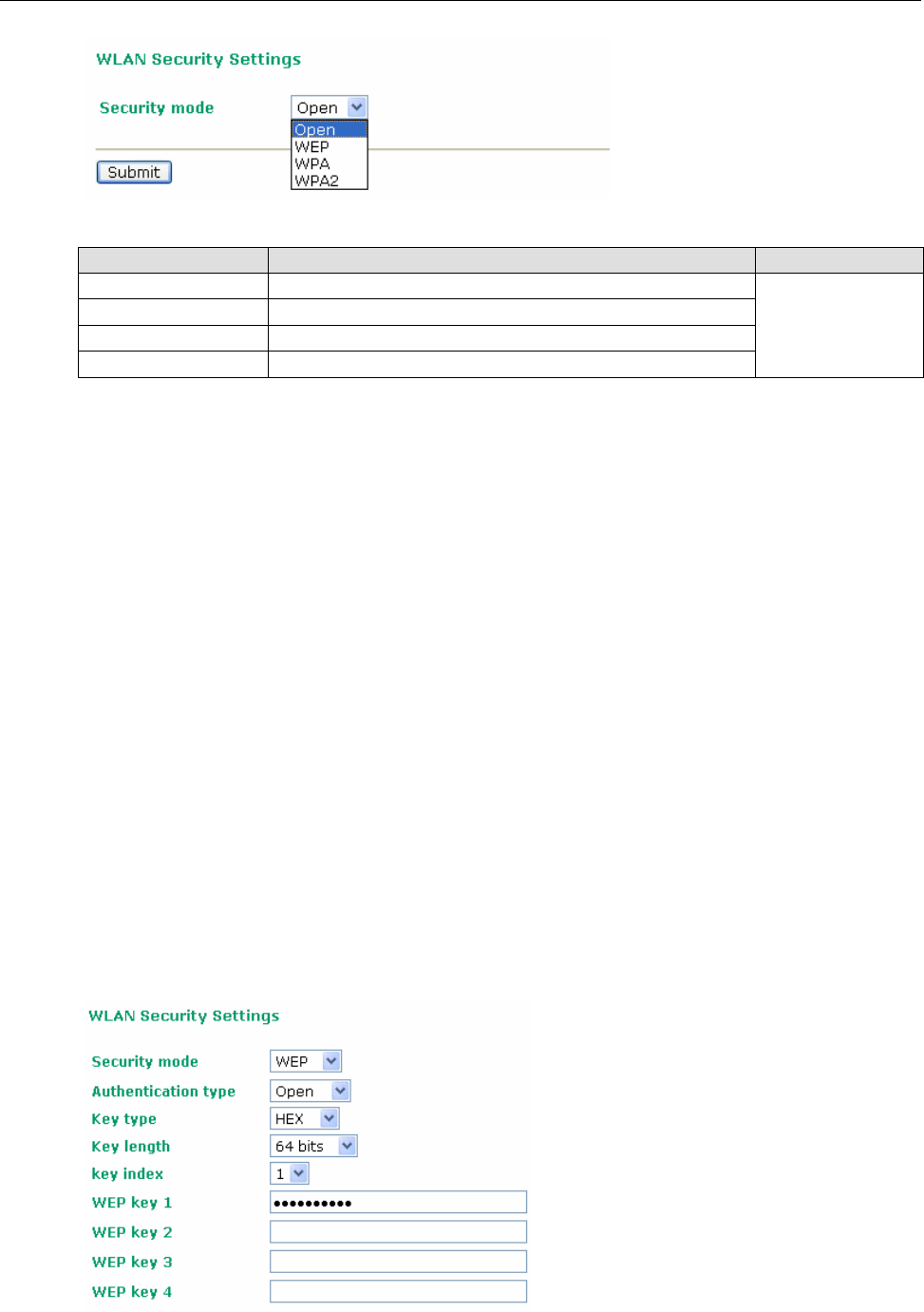
AirWorks AWK-4131A Web Console Configuration
3-13
Security mode
Setting Description Factory Default
Open No authentication Open
WEP Static WEP is used
WPA* WPA is used
WPA2* Fully supports IEEE802.11i with “TKIP/AES + 802.1X”
* WPA and WPA2 cannot be supported in WDS (Bridge) mode.
Open
For security reasons, it is highly recommended that the security mode should be set to the options other than
Open System. When the security mode is set to Open System, no authentication or data encryption will be
performed.
WEP
According to the IEEE802.11 standard, WEP can be used for authentication and data encryption
(confidentiality). Shared (or Shared Key) authentication type is used if WEP authentication and data
encryption are both needed. Normally, Open (or Open System) authentication type is often used when WEP
data encryption is run with authentication.
When WEP is enabled as a security mode, the length of a key (so-called WEP seed) can be specified as 64/128
bits, which is actually a 40/104-bit secret key with a 24-bit initialization vector. The AWK-4131A provides 4
entities of WEP key settings that can be selected to use with Key index. The selected key setting specifies the
key to be used as a send-key for encrypting traffic from the AP side to the wireless client side. All 4 WEP keys
are used as receive-keys to decrypt traffic from the wireless client side to the AP side.
The WEP key can be presented in two Key type, HEX and ASCII. Each ASCII character has 8 bits, so a 40-bit
(or 64-bit) WEP key contains 5 characters, and a 104-bit (or 128-bit) key has 13 characters. In hex, each
character uses 4 bits, so a 40-bit key has 10 hex characters, and a 128-bit key has 26 characters.
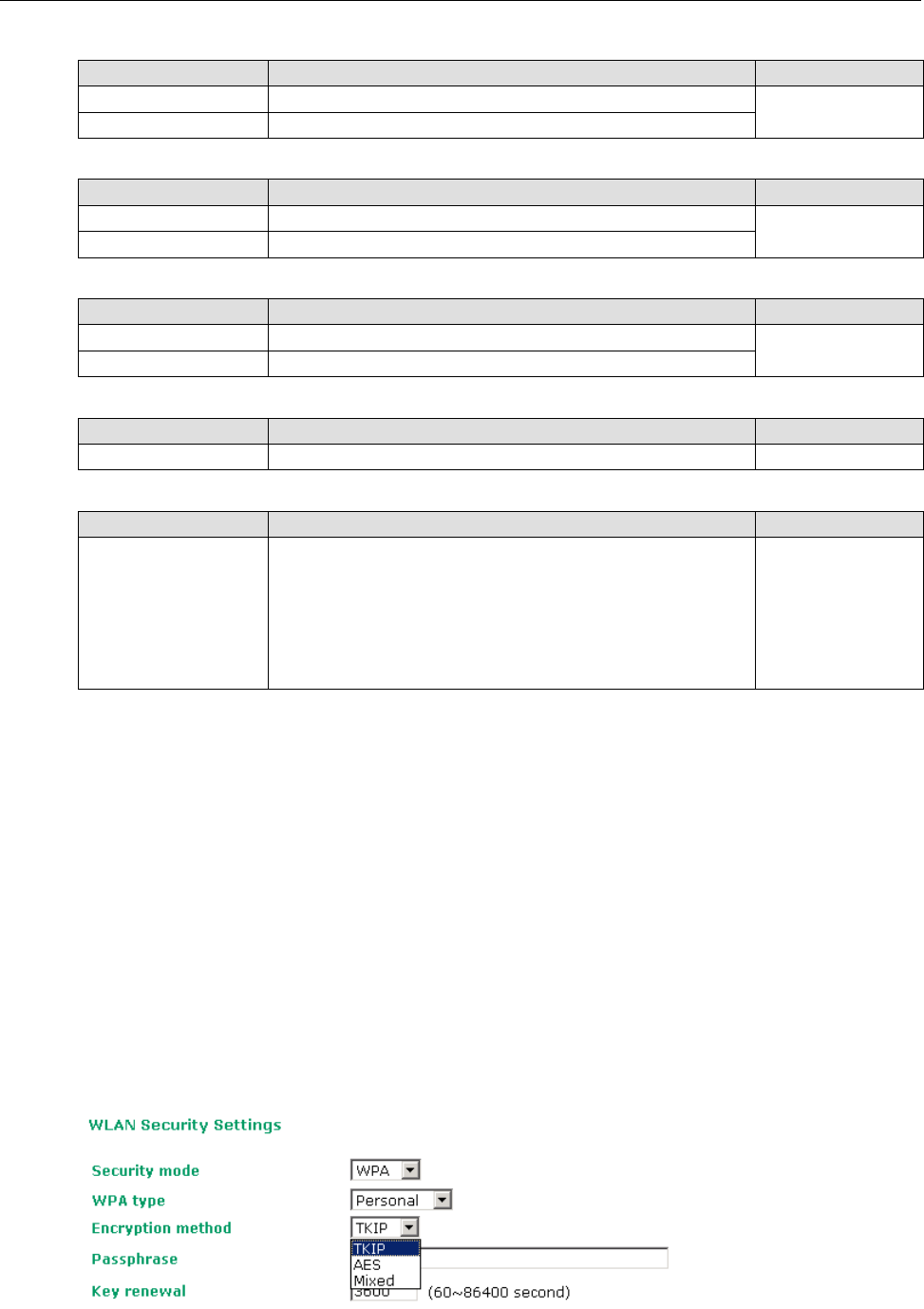
AirWorks AWK-4131A Web Console Configuration
3-14
Authentication type
Setting Description Factory Default
Open Data encryption is enabled, but no authentication Open
Shared Data encryption and authentication are both enabled.
Key type
Setting Description Factory Default
HEX Specifies WEP keys in hex-decimal number form HEX
ASCII Specifies WEP keys in ASCII form
Key length
Setting Description Factory Default
64 bits Uses 40-bit secret keys with 24-bit initialization vector 64 bits
128 bits Uses 104-bit secret key with 24-bit initialization vector
Key index
Setting Description Factory Default
1-4 Specifies which WEP key is used Open
WEP key 1-4
Setting Description Factory Default
ASCII type:
64 bits: 5 chars
128 bits: 13chars
HEX type:
64 bits: 10 hex chars
128 bits: 26 hex chars
A string that can be used as a WEP seed for RC4 encryption
engine. None
WPA/WPA2-Personal
WPA (Wi-Fi Protected Access) and WPA2 are significantly improved encryption methods of WEP. WPA is a
security standard based on 802.11i draft 3, while WPA2 is based on the fully ratified version of 802.11i. The
initial vector is transmitted, encrypted, and enhanced with its 48 bits, twice as long as WEP. The key is regularly
changed so for added security.
Even though AES encryption is only included in the WPA2 standard, it is widely available in the WPA security
mode of some wireless APs and clients as well. The AWK-4131A also supports AES algorithms in WPA and WPA2
for better compatibility.
Personal versions of WPA/WPA2, also know as WPA/WPA-PSK (Pre-Shared Key), provides a simple way of
encrypting a wireless connection for high confidentiality. A Passphrase is used as a basis for encryption
methods (or cipher types) in a WLAN connection. The passphrases should be complex and as long as possible.
The number of ASCII characters of the Passphrase must be at least 8 and can go up to 63. For security reason,
this passphrase should be disclosed to the relevant users only and changed regularly.
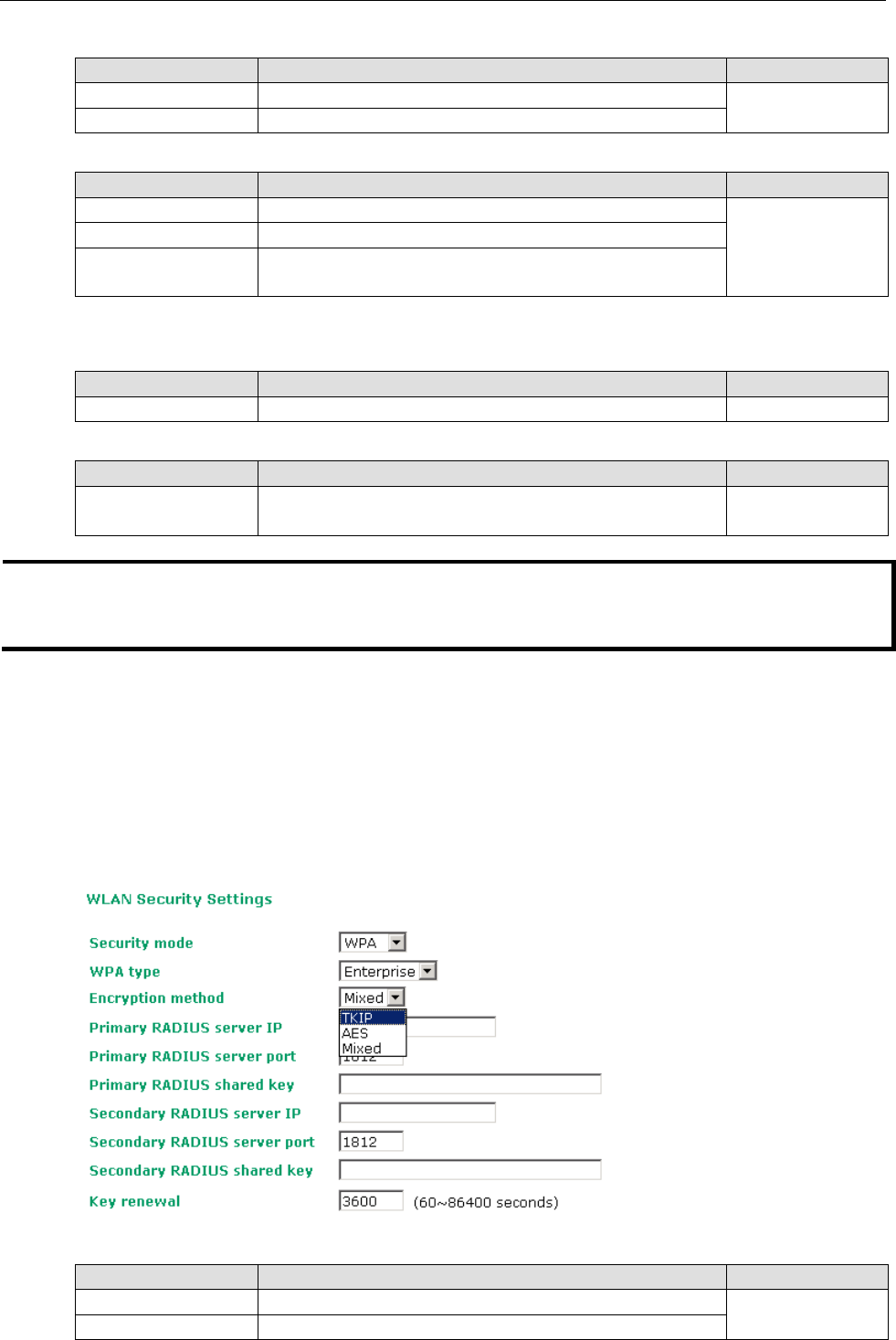
AirWorks AWK-4131A Web Console Configuration
3-15
WPA type
Setting Description Factory Default
Personal Provides Pre-Shared Key-enabled WPA and WPA2 Personal
Enterprise Provides enterprise-level security for WPA and WPA2
Encryption method
Setting Description Factory Default
TKIP Temporal Key Integrity Protocol is enabled TKIP
AES Advance Encryption System is enabled
Mixed* Provides TKIP broadcast key and TKIP+AES unicast key for
some legacy clients. This option is rarely used.
*This option is available in AP/Master mode only, and cannot support AES-enabled clients.
Passphrase
Setting Description Factory Default
8 – 63 characters Master key to generate keys for encryption and decryption None
Key renewal (for AP/Master mode only)
Setting Description Factory Default
60 – 86400 seconds
(1 minute to 1 day) Specifies the time period of group key renewal 3600 (seconds)
NOTE
The value for key renewal instructs the wireless AP how often it should change the encryption keys. Usually the
security level will be higher if you set this value shorter so that the encryption keys are changed more often.
Default value is 3600 seconds (6 minutes). Longer time periods can be considered if traffic is not so busy.
WPA/WPA2-Enterprise (for AP/Master mode)
By selecting WPA type as Enterprise, you can use EAP (Extensible Authentication Protocol), a framework
authentication protocol used by 802.1X to provide network authentication. In these Enterprise-level security
modes, a back-end RADIUS (Remote Authentication Dial-In User Service) server is needed if IEEE 802.1X
functionality is enabled in WPA /WPA2. The IEEE 802.1X protocol also offers the possibility of carrying out an
efficient connection authentication in a large-scaled network. It is not necessary to exchange keys or pass
phrases.
WPA type
Setting Description Factory Default
Personal Provides Pre-Shared Key-enabled WPA and WPA2 Personal
Enterprise Provides enterprise-level security for WPA and WPA2
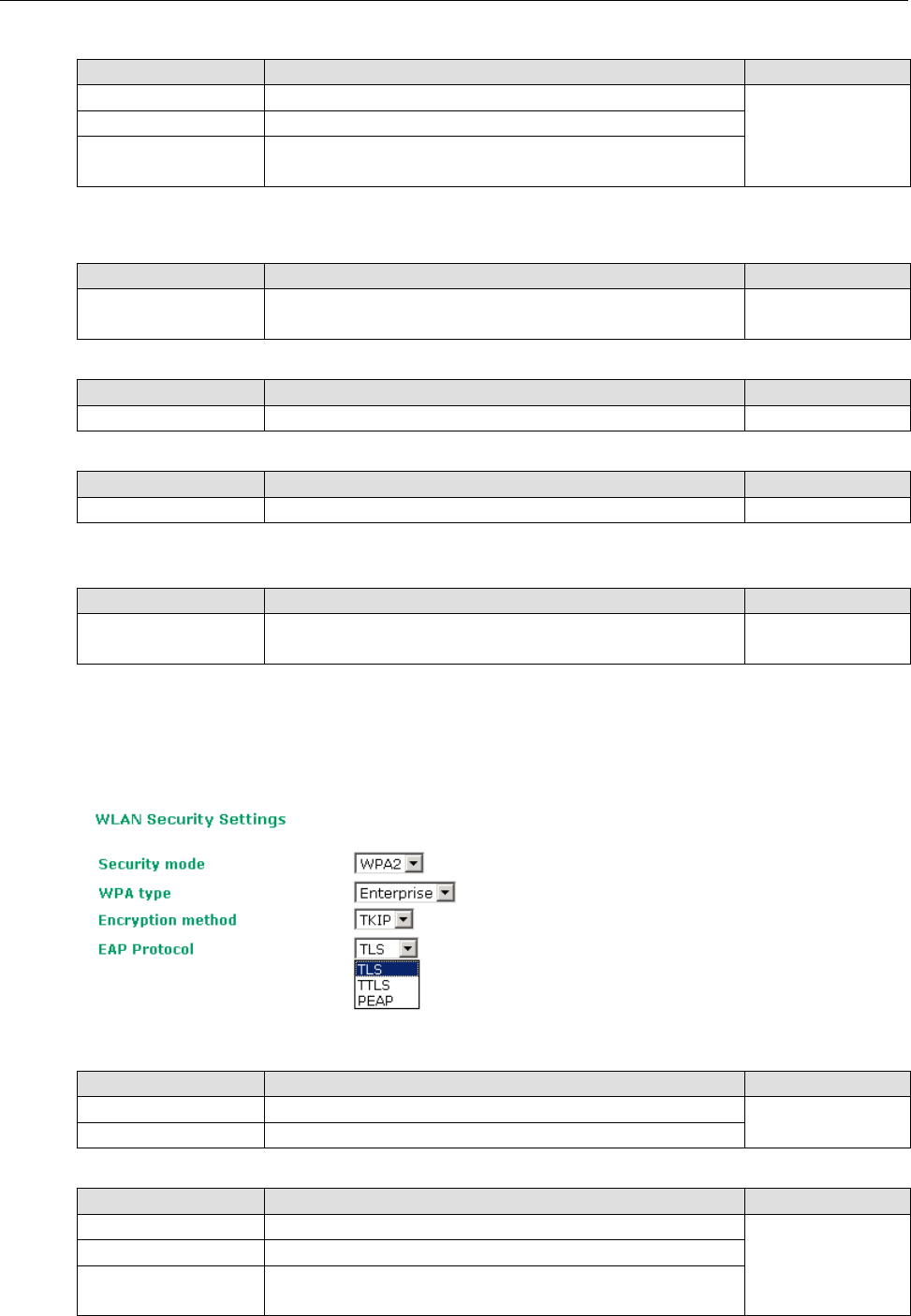
AirWorks AWK-4131A Web Console Configuration
3-16
Encryption method
Setting Description Factory Default
TKIP Temporal Key Integrity Protocol is enabled TKIP
AES Advance Encryption System is enabled
Mixed Provides TKIP broadcast key and TKIP+AES unicast key for
some legacy clients. This option is rarely used.
*This option is available in AP/Master mode only, and cannot support AES-enabled clients.
Primary/ Secondary RADIUS server IP
Setting Description Factory Default
The IP address of
RADIUS server Specifies the delegated RADIUS server for EAP None
Primary/ Secondary RADIUS port
Setting Description Factory Default
Port number Specifies the port number of the delegated RADIUS server 1812
Primary/ Secondary RADIUS shared key
Setting Description Factory Default
Max. 31 characters The secret key shared between AP and RADIUS server None
Key renewal
Setting Description Factory Default
60 – 86400 seconds
(1 minute to 1 year) Specifies the time period of group key renewal 3600 (seconds)
WPA/WPA2-Enterprise (for Client/Slave mode)
In a client role, the AWK-4131A can support three EAP methods (or EAP protocols): EAP-TLS, EAP-TTLS,
and EAP-PEAP, corresponding to WPA/WPA-Enterprise settings on the AP side.
Encryption method
Setting Description Factory Default
TKIP Temporal Key Integrity Protocol is enabled TKIP
AES Advance Encryption System is enabled
EAP Protocol
Setting Description Factory Default
TLS Specifies Transport Layer Security protocol TLS
TTLS Specifies Tunneled Transport Layer Security
PEAP Specifies Protected Extensible Authentication Protocol, or
Protected EAP
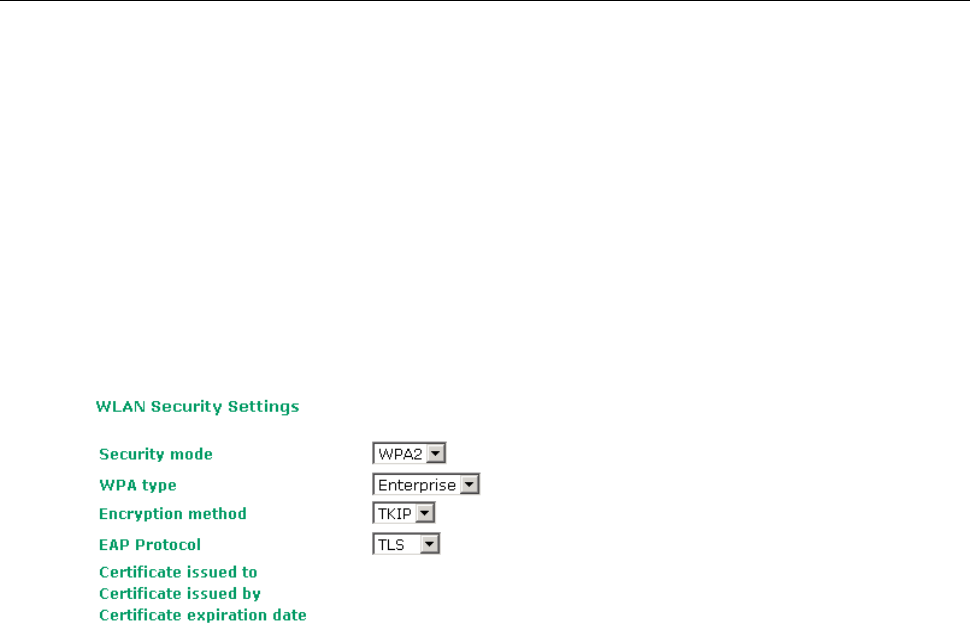
AirWorks AWK-4131A Web Console Configuration
3-17
Before choosing the EAP protocol for your WPA/WPA2-Enterpise settings on the client end, please contact the
network administrator to make sure the system supports the protocol on the AP end. Detailed information on
these three popular EAP protocols is presented in the following sections:
EAP-TLS
TLS is the standards-based successor to the Secure Socket Layer (SSL). It can establish a trusted
communication channel over a distrusted network. TLS provides mutual authentication through certificate
exchange. EAP-TLS is also secure to use. You are required to submit a digital certificate to the authentication
server for validation, but the authentication server must also supply a certificate.
You can use Basic Wireless Settings WLAN Certificate Settings to import your WLAN certificate and
enable EAP-TLS on the client end.
You can check the current certificate status in Current Status if it is available.
Certificate issued to: shows the certificate user
Certificate issued by: shows the certificate issuer
Certificate expiration date: indicates when the certificate gets invalid
EAP-TTLS
It is usually much easier to re-use existing authentication systems, such as a Windows domain or Active
Directory, LDAP directory, or Kerberos realm, rather than creating a parallel authentication system. As a result,
TTLS (Tunneled TLS) and PEAP (Protected EAP) are used to support the use of so-called “legacy authentication
methods.”
TTLS and PEAP work in a similar way. First, they establish a TLS tunnel, like EAP-TLS, and validate whether the
network is trustworthy with digital certificates on the authentication server. This step is run to establish a
tunnel that protects the next step (or “inner” authentication) so it is sometimes referred to as the “outer”
authentication. Then the TLS tunnel is used to encrypt an older authentication protocol that authenticates the
user for the network.
As you can see, digital certificates are still needed for the outer authentication in a simplified form. Only a small
number of certificates are required, which can be generated by a small certificate authority. Certificate
reduction makes TTLS and PEAP much more popular than EAP-TLS.
The AWK-4131A provides some non-cryptographic EAP methods including PAP, CHAP, MS-CHAP, and
MS-CHAP-V2. These EAP methods are not recommended for direct use on wireless networks. However, they
may be useful as inner authentication methods with TTLS or PEAP.
Because the inner and outer authentications can use distinct user names in TTLS and PEAP, you can use an
anonymous user name for the outer authentication, while the true user name is shown only through the
encrypted channel. Remember, not all client software supports anonymous altercation. Confirm this with the
network administrator before you enable identity hiding in TTLS and PEAP.
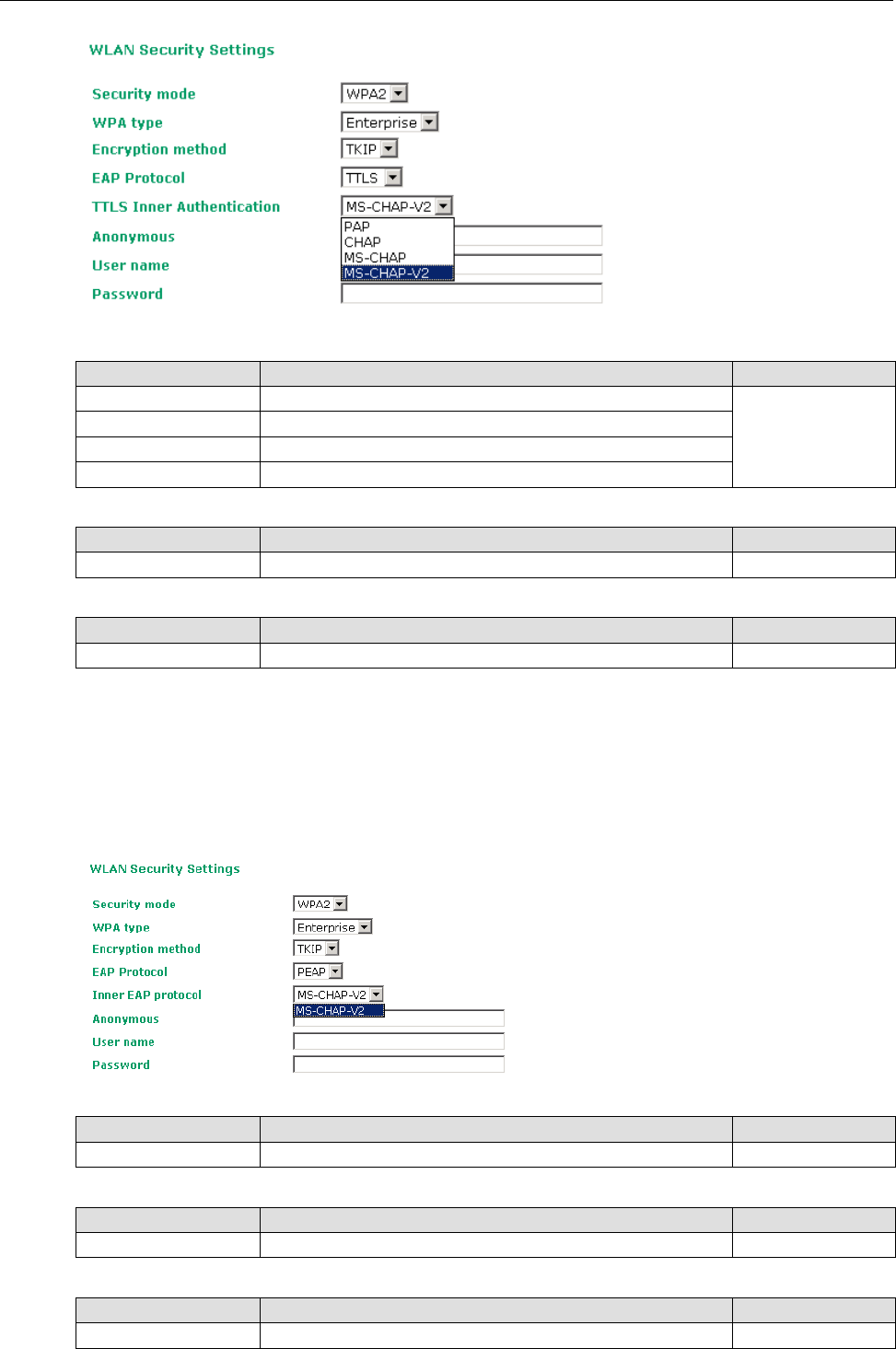
AirWorks AWK-4131A Web Console Configuration
3-18
TTL Inner Authentication
Setting Description Factory Default
PAP Password Authentication Protocol is used MS-CHAP-V2
CHAP Challenge Handshake Authentication Protocol is used
MS-CHAP Microsoft CHAP is used
MS-CHAP-V2 Microsoft CHAP version 2 is used
Anonymous
Setting Description Factory Default
Max. 31 characters A distinct name used for outer authentication None
User name & Password
Setting Description Factory Default
User name and password used in inner authentication None
PEAP
There are a few differences in the inner authentication procedures for TTLS and PEAP. TTLS uses the encrypted
channel to exchange attribute-value pairs (AVPs), while PEAP uses the encrypted channel to start a second EAP
exchange inside of the tunnel. The AWK-4131A provides MS-CHAP-V2 merely as an EAP method for inner
authentication.
Inner EAP protocol
Setting Description Factory Default
MS-CHAP-V2 Microsoft CHAP version 2 is used MS-CHAP-V2
Anonymous
Setting Description Factory Default
Max. 31 characters A distinct name used for outer authentication None
User name & Password
Setting Description Factory Default
User name and password used in inner authentication None
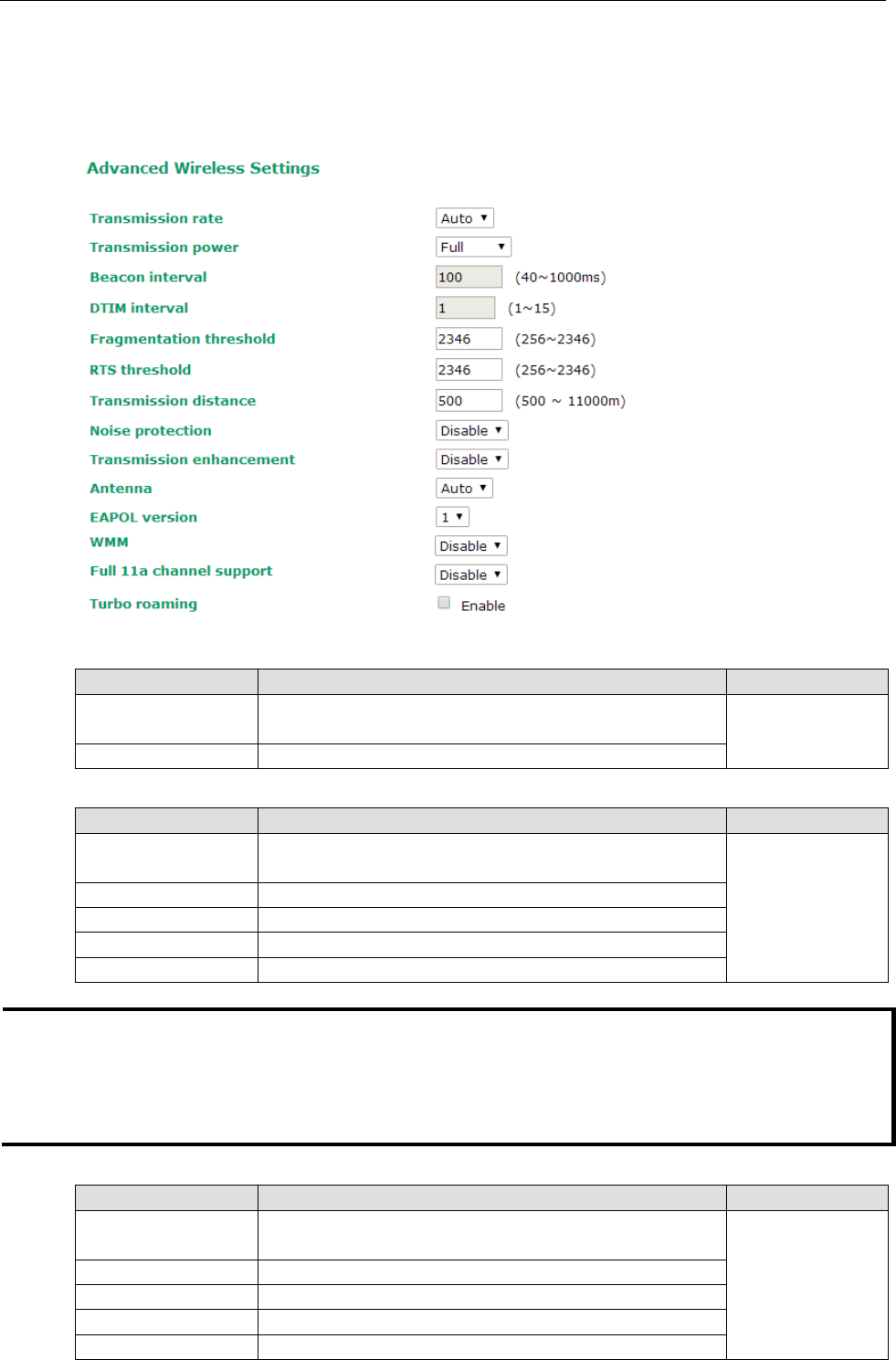
AirWorks AWK-4131A Web Console Configuration
3-19
Advanced Wireless Settings
Additional wireless-related parameters are presented in this section to help you set up your wireless network
in detail.
Transmission Rate
Setting Description Factory Default
Auto The AWK-4131A will sense and adjust the data rate
automatically Auto
Available rates User can manually select a target transmission data rate
Transmission Power
Setting Description Factory Default
Auto Specifies wireless signal coverage by automatically selecting
the strength of Tx power Full
Full Equivalent to 0 full Tx power
High -5 dB of full Tx power
Medium -10 dB of full Tx power
Low -15 dB of full Tx power
NOTE
NOTE
Tx power
at “Full”
•
US model: 17 dB
•
EU model: 16 dB
•
JP model: 18 dB
RF type = A (Channel 36 ~ 48)
Setting Description Factory Default
Auto Specifies wireless signal coverage by automatically selecting
the strength of Tx power Full
Full Equivalent to 0 full Tx power
High -4 dB of full Tx power
Medium -8 dB of full Tx power
Low -12 dB of full Tx power
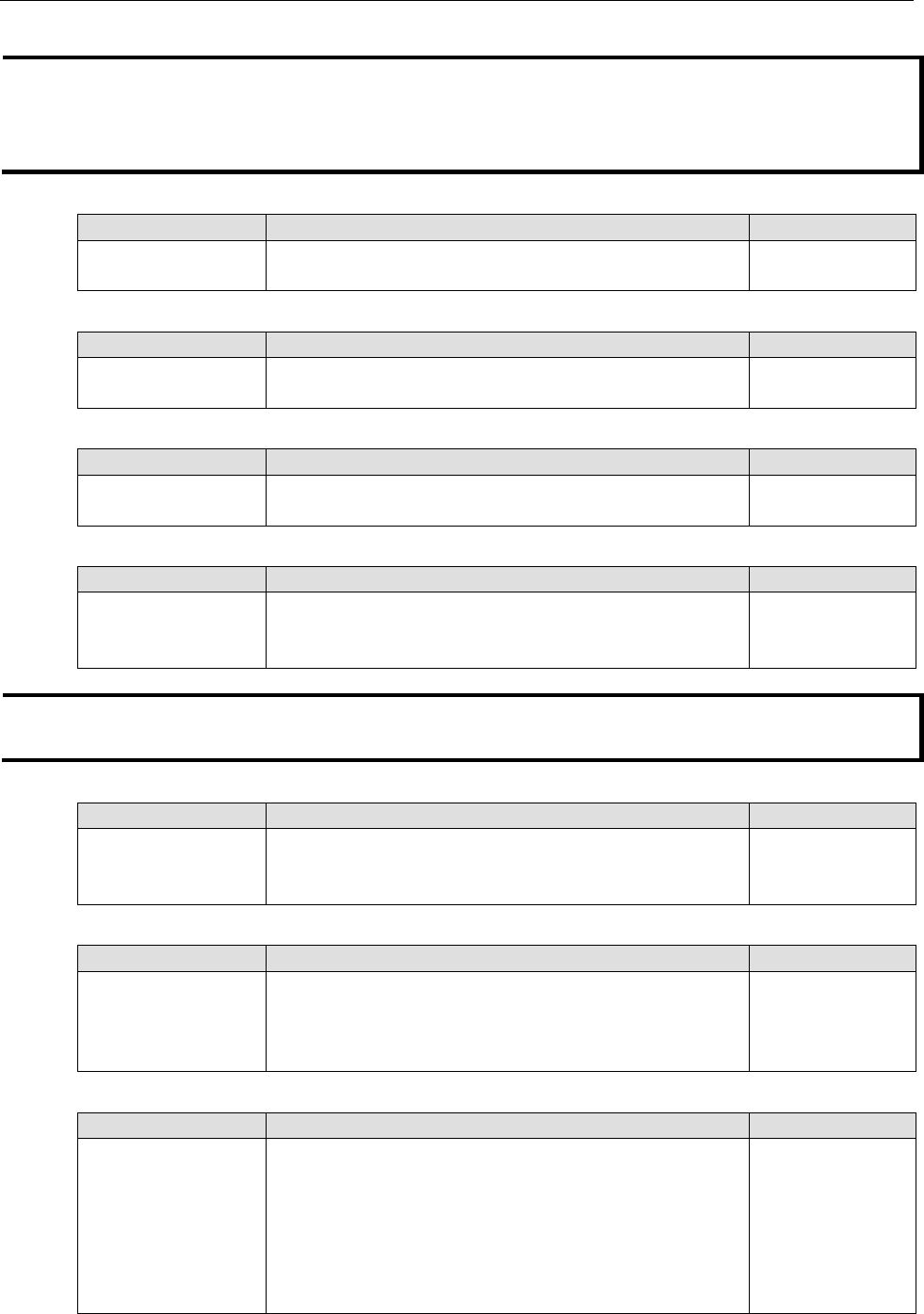
AirWorks AWK-4131A Web Console Configuration
3-20
NOTE
Tx power at “Full”
•
US model: 14 dB
•
EU model: 16 dB
•
JP model: 14 dB
Beacon Interval (for AP/Master mode only)
Setting Description Factory Default
Beacon Interval
(40-1000 ms) This value indicates the frequency interval of the beacon 100 (ms)
DTIM Interval (for AP/Master mode only)
Setting Description Factory Default
Data Beacon Rate
(1-15) This value indicates how often the AWK-4131A sends out a
Delivery Traffic Indication Message 1
Fragmentation threshold
Setting Description Factory Default
Fragment Length
(256-2346) This parameter specifies the maximum size a data packet
before splitting and creating another new packet 2346
RTS threshold
Setting Description Factory Default
RTS/CTS Threshold
(256-2346) This setting determines how large a packet can be before the
Access Point coordinates transmission and reception to ensure
efficient communication
2346
NOTE
You can refer to the
related glossaries in Chapter 5 for more detailed information about the above-
mentioned
settings. By setting these parameters properly, you can better tune the performance of your wireless network.
Transmission distance
Setting Description Factory Default
Distance or max. range
for transmission
(500-10000m)
The distance specifies the transmission distance or max. range
between two AWK devices. This parameter should be set
properly, especially for long-distance communication.
500
Noise protection
Setting Description Factory Default
Enable/Disable Adjusts the interference coping capability of the wireless signal.
This option should be enabled for communication distances
under 500 meters, and should be disabled for communication
distances over 500 meters.
Disable
Transmission enhancement
Setting Description Factory Default
Enable/ Disable This setting can enhance communication by strengthening the
AWK-4131A’s transmission power. It is quite useful for
long-distance transmission or countering environmental
interference. The user must carefully evaluate and measure the
transmission power of the entire system to make sure that it is
still below the regulative limit. Note, too, that RF type 802.11a
mode cannot be used if this function is enabled.
Disable

AirWorks AWK-4131A Web Console Configuration
3-21
NOTE
When Transmission enhancement is enabled, the Tx Power is at “Full”
RF type = B/G/Mixed (Channel1~13)
•
US model: 22 dB
•
EU model: 20 dB
•
JP model: 20 dB
RF
type = A (Channel 36 ~ 48)
•
US model: 17 dB
•
EU model: 17 dB
•
JP model: 17 dB
NOTE
Make sure the same
Transmission distance parameters are set in both AP and Client sides, and both
Bridges
. When this parameter is more than 500, an optimal algorithm will be enabled to support long-
distance
transmission.
Transmission enhancement
only supports 802.11b/g mode; 802.11a mode is not supported.
Transmission enhancement
is also recommended to enable communication at both ends when
long
-distance transmission is required. A high-gain antenna installed at a fixed antenna connector can also
improve performance. (Select Antenna at MAIN or AUX.)
Antenna
Setting Description Factory Default
Auto The AWK-4131A uses two antennas (MAIN and AUX) and
enables the diversity function for reducing multipath effects. Auto
MAIN Diversity function is disabled. Only MAIN antenna is in use.
AUX Diversity function is disabled. Only AUX antenna is in use.
EAPOL version
Setting Description Factory Default
1 EAPOL version 1 was standardized in the 2001 version of
802.1X, which is much more commonly implemented. 1
2 EAPOL version 2 was specified in 802.1X-2004.
WMM
Setting Description Factory Default
Enable/ Disable
WMM is a QoS standard for WLAN traffic. Voice and video data
will be given priority bandwidth when enabled with WMM
supported wireless clients.
Disable
Full 11a channel support
Setting Description Factory Default
Enable/ Disable “Full 11a channel support” allows users to select one channel
from 802.11a, including channels in licensed and unlicensed
bands.
Disable
Turbo Roaming (for Client mode only)
Setting Description Factory Default
Enable/ Disable Moxa’s Turbo Roaming can enable rapid handover when the
AWK-4131A, as a client, roams among a group of APs. Disable
When Turbo Roaming is enabled, RF type and Scan channels will be shown as follows. RF type shows the
current RF type, which this client is using now. You can set up Scan channels for the APs among which this
client is going to roam. There are three Scan channels available. Please note that the Scan channels may need
to be modified when the RF type is changed. (For example, channel 36 is not available in B, G or B/G Mix
mode.)
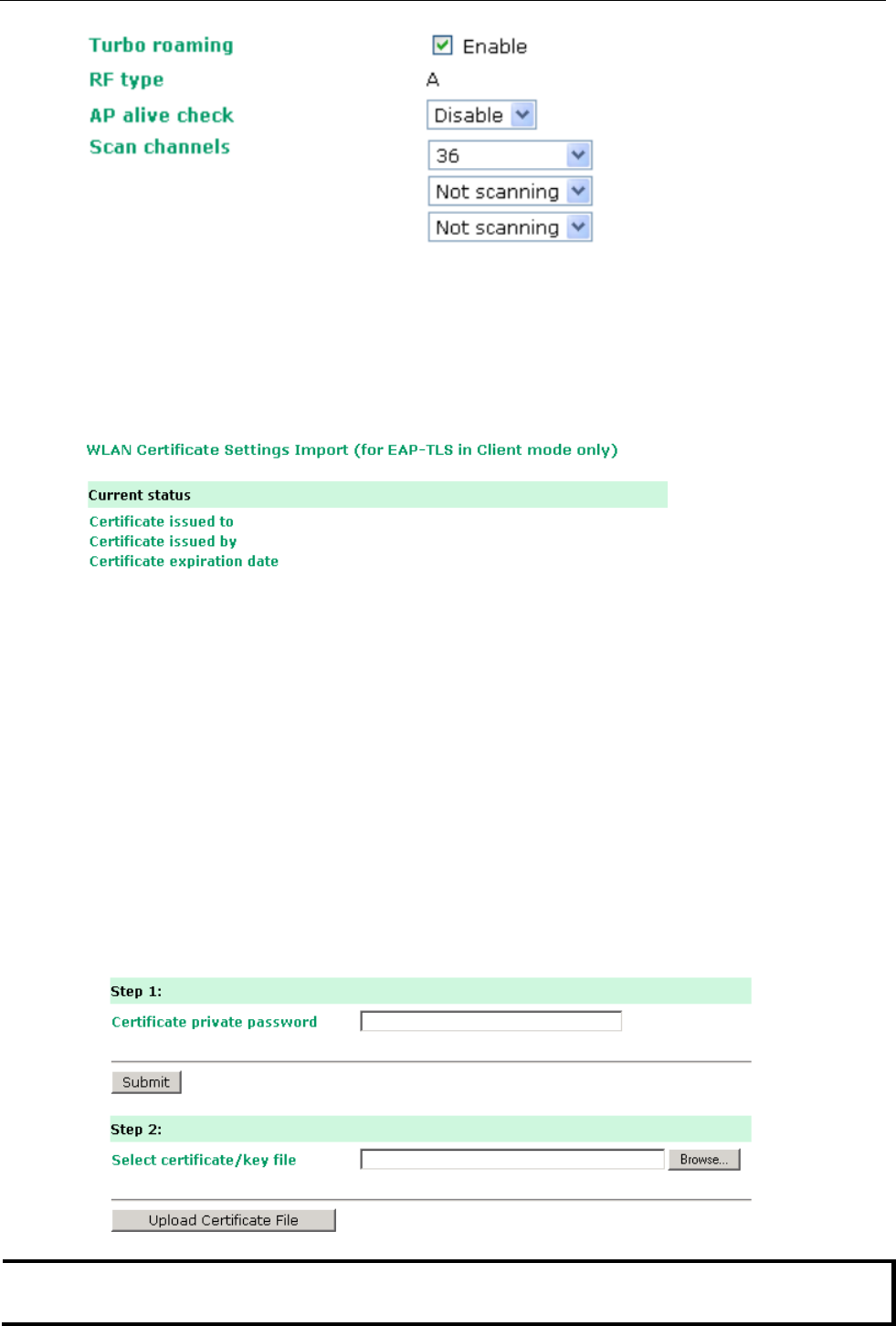
AirWorks AWK-4131A Web Console Configuration
3-22
WLAN Certification Settings (for EAP-TLS in Client mode only)
When EAP-TLS is used, a WLAN Certificate will be required at the client end to support WPA/WPA2-Enterprise.
The AWK-4131A can support the PKCS #12, also known as Personal Information Exchange Syntax Standard,
certificate formats that define file formats commonly used to store private keys with accompanying public key
certificates, protected with a password-based symmetric key.
Current status displays information for the current WLAN certificate, which has been imported into the
AWK-4131A. Nothing will be shown if no certificate is available.
Certificate issued to: shows the certificate user
Certificate issued by: shows the certificate issuer
Certificate expiration date: indicates when the certificate gets invalid
You can import a new WLAN certificate in Import WLAN Certificate by following these steps in order:
1. Input the corresponding password (or key) in the Certificate private password field. Then click Submit
to set the password.
2. You can see the password displayed in the Certificate private password field. Then click on the Browse
button in Select certificate/key file and select the certificate file.
3. Click Upload Certificate File to import the certificate file. If it succeeds, you can see the information
uploaded in Current Certificate. If it fails, you may need to return to step 1 to set the password correctly
and then import the certificate file again.
NOTE
The WLAN certificate will remain after the
AWK-4131A
reboots. Even though it is expired, it can still be seen on
Current Certificate.

AirWorks AWK-4131A Web Console Configuration
3-23
Advanced Settings
Several advanced functions are available to increase the functionality of your AWK-4131A and wireless network
system. A VLAN is a collection of clients and hosts grouped together as if they were connected to the broadcast
domains in a layer 2 network. The DHCP server helps you deploy wireless clients efficiently. Packet filters
provide security mechanisms, such as firewalls, in different network layers. Moreover, the AWK-4131A can
support STP/RSTP protocol to increase reliability across the entire network, and SNMP support can make
network management easier.
Using Virtual LAN
Setting up Virtual LANs (VLANs) on your AWK series increases the efficiency of your network by dividing the
LAN into logical segments, as opposed to physical segments. In general, VLANs are easier to manage.
The Virtual LAN (VLAN) Concept
What is a VLAN?
A virtual LAN, commonly known as a VLAN, is a group of hosts with a common set of requirements that
communicate as if they were attached to the same broadcast domain, regardless of their physical location. A
VLAN has the same attributes as a physical LAN, but it allows for end stations to be grouped together even if
they are not located on the same network switch. Network reconfiguration can be done through software
instead of physically relocating devices.
VLANs now extend as far as the reach of the access point signal. Clients can be segmented into wireless
sub-networks via SSID and VLAN assignment. A Client can access the network by connecting to an AP
configured to support its assigned SSID/VLAN.
Benefits of VLANs
VLANs are used to conveniently, efficiently, and easily manage your network in the following ways:
• Manage adds, moves, and changes from a single point of contact
• Define and monitor groups
• Reduce broadcast and multicast traffic to unnecessary destinations
• Improve network performance and reduce latency
• Increase security
• Secure network restricts members to resources on their own VLAN
• Clients roam without compromising security
VLAN Workgroups and Traffic Management
The AP assigns clients to a VLAN based on a Network Name (SSID). The AP can support up to 9 SSIDs per radio
interface, with a unique VLAN configurable per SSID.
The AP matches packets transmitted or received to a network name with the associated VLAN. Traffic received
by a VLAN is only sent on the wireless interface associated with that same VLAN. This eliminates unnecessary
traffic on the wireless LAN, conserving bandwidth and maximizing throughput.
In addition to enhancing wireless traffic management, the VLAN-capable AP supports easy assignment of
wireless users to workgroups. In a typical scenario, each user VLAN represents a department workgroup; for
example, one VLAN could be used for a marketing department and the other for a human resource department.
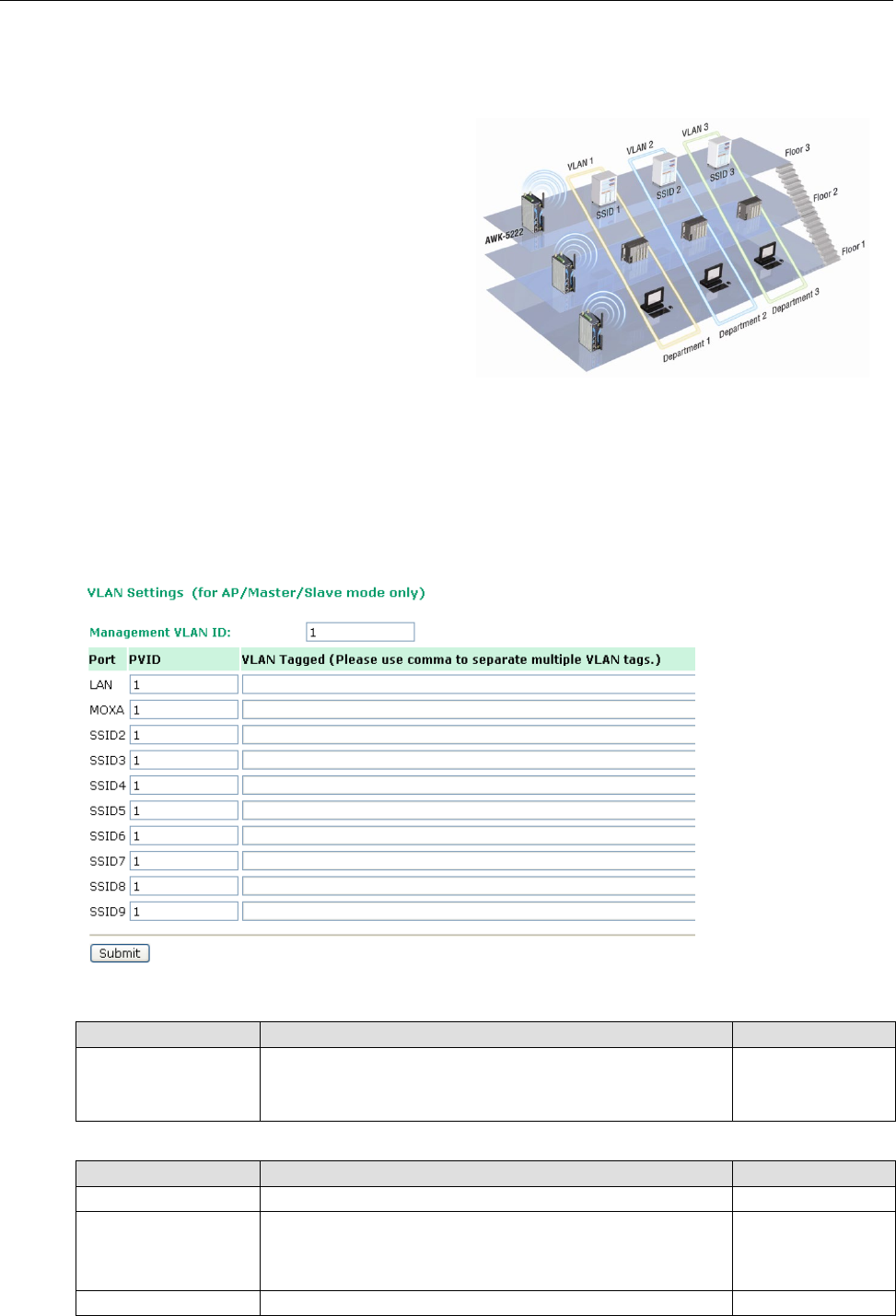
AirWorks AWK-4131A Web Console Configuration
3-24
In this scenario, the AP would assign every packet it accepted to a VLAN. Each packet would then be identified
as marketing or human resource, depending on which wireless client received it. The AP would insert VLAN
headers or “tags” with identifiers into the packets transmitted on the wired backbone to a network switch.
Finally, the switch would be configured t
o route
packets from the marketing department to the
appropriate corporate resources such as printers
and servers. Packets from the human resource
department could be restricted to a gateway that
allowed access to only the Internet. A member of
the human r
esource department could send and
receive e
-
mail and access the Internet, but would
be prevented from accessing servers or hosts on
the local corporate network.
Configuring Virtual LAN
VLAN Settings
To configure the AWK’s VLAN, use the VLAN Setting page to configure the ports.
Management VLAN ID
Setting Description Factory Default
VLAN ID
ranges from
1 to 4094
Set the management VLAN of this AWK. 1
Port
Type Description Trunk Port
LAN This port is the LAN port on the AWK. Yes
WLAN This is a wireless port for the specific SSID. This field will refer
to the SSID that you have created. If more SSIDs have been
created, new rows will be added.
WDS This is the WDS port on the AWK Yes
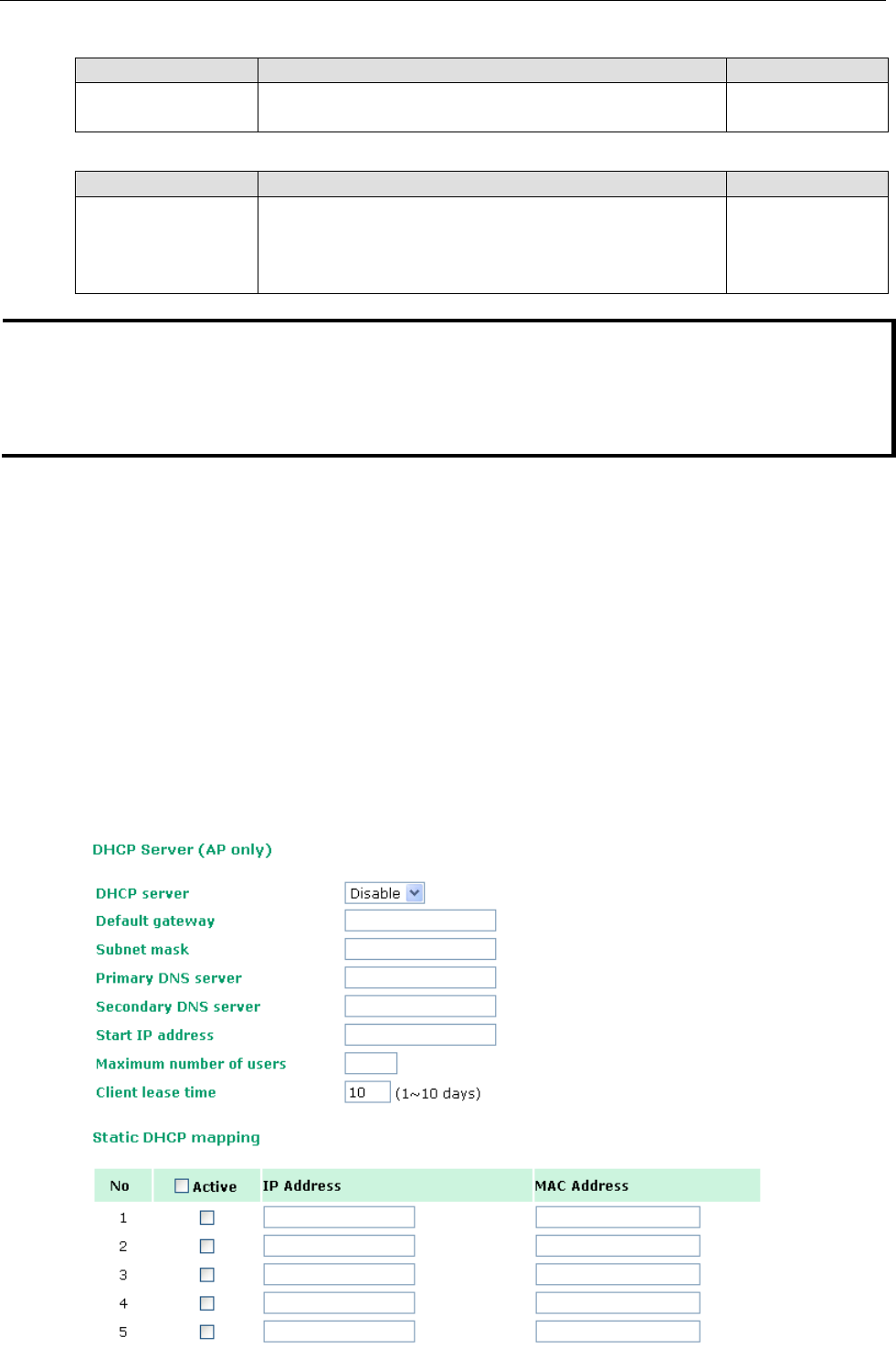
AirWorks AWK-4131A Web Console Configuration
3-25
Port PVID
Setting Description Factory Default
VLAN ID ranging from 1
to 4094 Set the port’s VLAN ID for devices that connect to the port. The
port can be a LAN port or WLAN ports. 1
VLAN Tagged
Setting Description Factory Default
A comma-
seperated list
of VLAN IDs. Each of
the VLAN IDs range
from 1 to 4094.
Specify which VLANs can communicate with this specific VLAN.
(Empty)
NOTE
The VLAN feature can allow wireless clients to manage the AP. If the VLAN Management ID matches a VLAN ID,
then those wireless clients who are members of that VLAN will have AP
management access.
CAUTION: Once a VLAN Management ID is configured and is equivalent to one of the VLAN IDs on the AP, all
members of that User VLAN will have management access to the AP. Be careful to restrict VLAN membership
to those with legitimate acc
ess to the AP.
DHCP Server (for AP mode only)
DHCP (Dynamic Host Configuration Protocol) is a networking protocol that allows administrators to assign
temporary IP addresses to network computers by “leasing” an IP address to a user for a limited amount of time,
instead of assigning permanent IP addresses.
The AWK-4131A can act as a simplified DHCP server and easily assign IP addresses to your DHCP clients by
responding to the DHCP requests from the client ends. The IP-related parameters you set on this page will also
be sent to the client.
You can also assign a static IP address to a specific client by entering its MAC address. The AWK-4131A
provides a Static DHCP mapping list with up to 16 entities. Be reminded to check the Active check box for
each entity to activate the setting.
You can check the IP assignment status under Status
DHCP Client List.
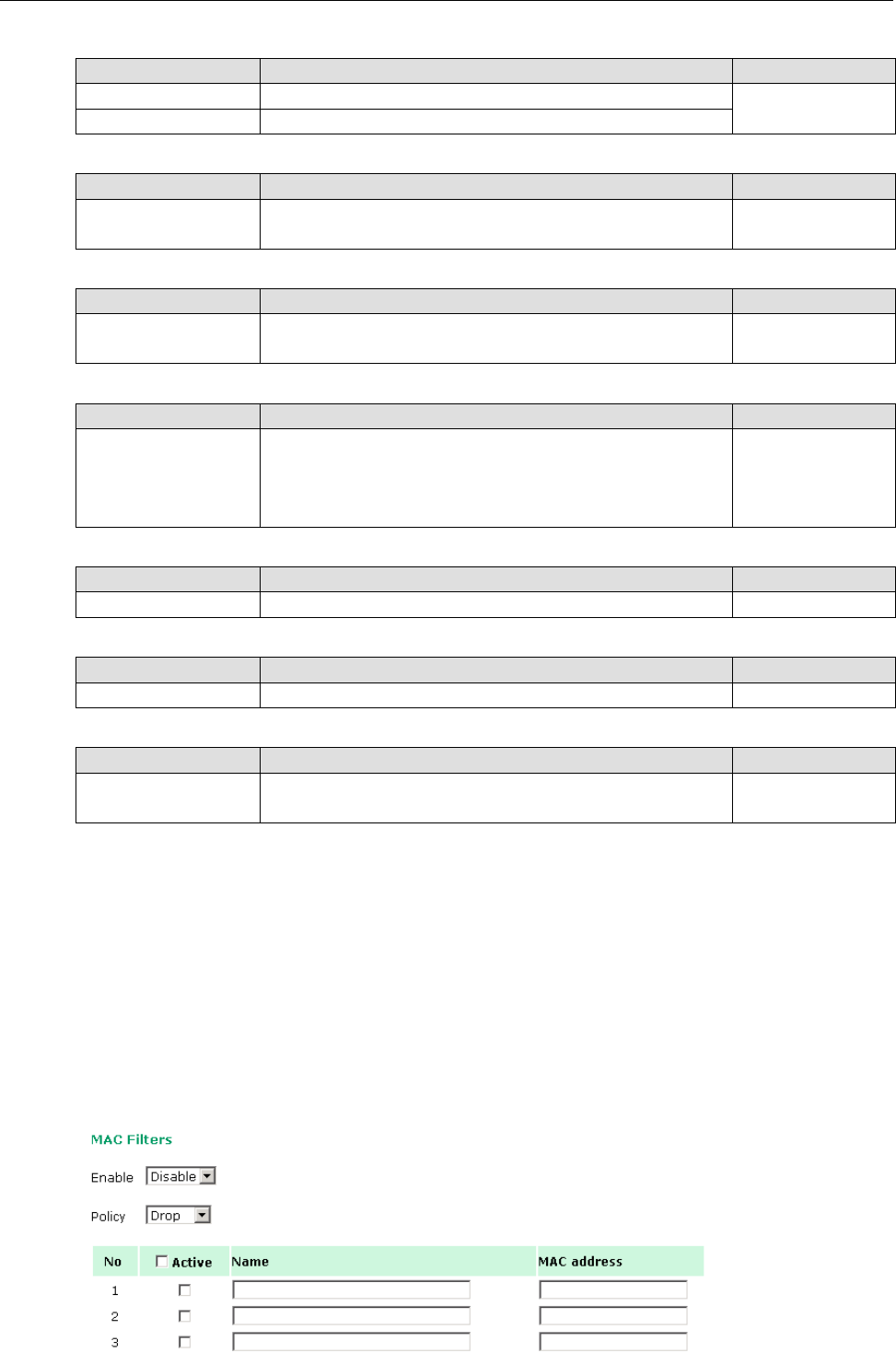
AirWorks AWK-4131A Web Console Configuration
3-26
DHCP server
Setting Description Factory Default
Enable Enables AWK-4131A as a DHCP server Disable
Disable Disable DHCP server function
Default gateway
Setting Description Factory Default
IP address of a default
gateway The IP address of the router that connects to an outside
network None
Subnet mask
Setting Description Factory Default
subnet mask Identifies the type of sub-network (e.g., 255.255.0.0 for a
Class B network, or 255.255.255.0 for a Class C network) None
Primary/ Secondary DNS server
Setting Description Factory Default
IP address of Primary/
Secondary DNS server
The IP address of the DNS Server used by your network. After
entering the DNS Server’s IP address, you can use URL as well.
The Secondary DNS server will be used if the Primary DNS
server fails to connect.
None
Start IP address
Setting Description Factory Default
IP address Indicates the IP address which AWK-4131A can start assigning
None
Maximum number of users
Setting Description Factory Default
1 – 999 Specifies how many IP address can be assigned continuously None
Client lease time
Setting Description Factory Default
1 – 10 days The lease time for which an IP address is assigned. The IP
address may go expired after the lease time is reached. 10 (days)
Packet Filters
The AWK-4131A includes various filters for IP-based packets going through LAN and WLAN interfaces. You
can set these filters as a firewall to help enhance network security.
MAC Filter
The AWK-4131A’s MAC filter is a policy-based filter that can allow or filter out IP-based packets with specified
MAC addresses. The AWK-4131A provides 8 entities for setting MAC addresses in your filtering policy.
Remember to check the Active check box for each entity to activate the setting.
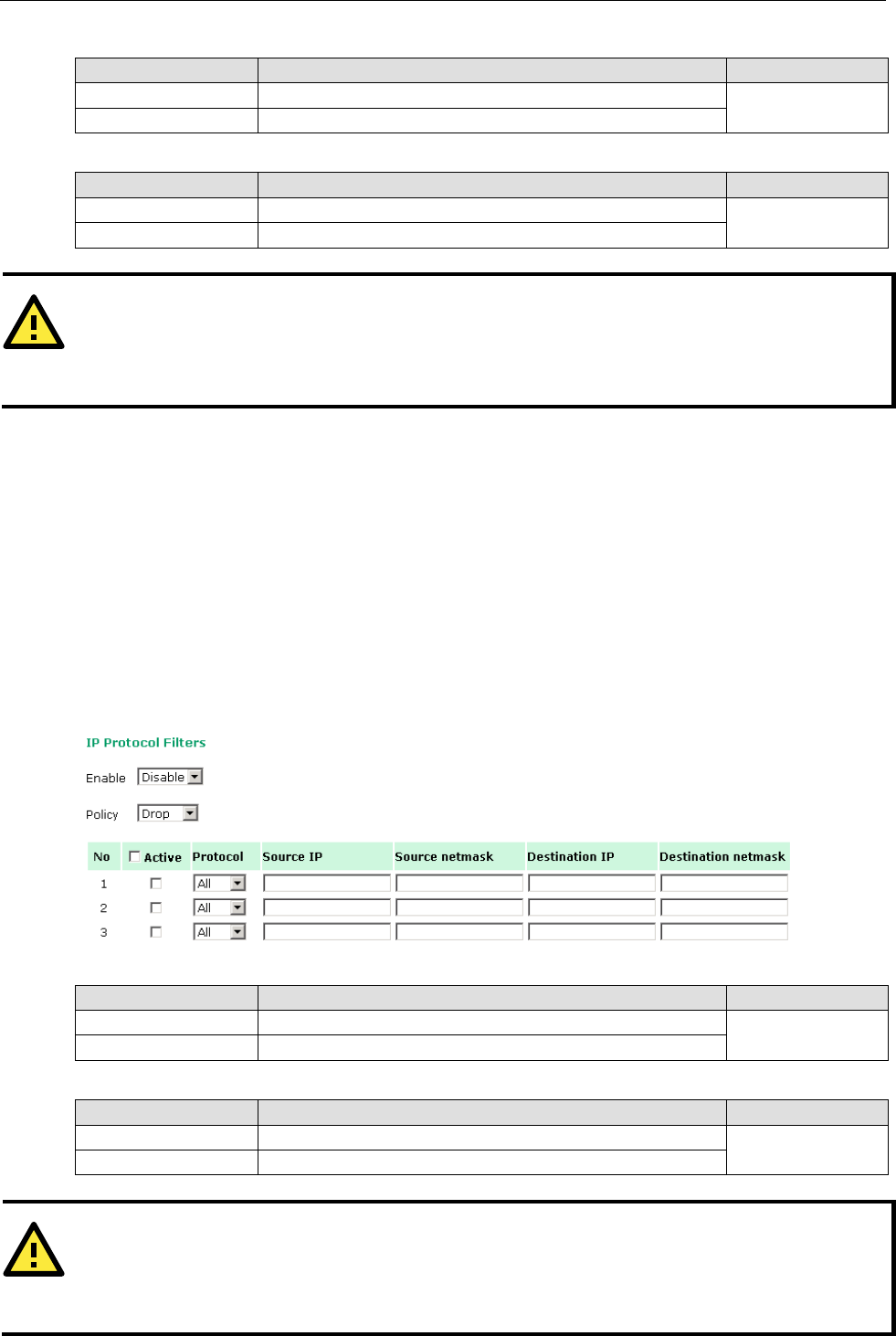
AirWorks AWK-4131A Web Console Configuration
3-27
Enable
Setting Description Factory Default
Enable Enables MAC filter Disable
Disable Disables MAC filter
Policy
Setting Description Factory Default
Accept Only the packets fitting the entities on list can be allowed. Drop
Drop Any packet fitting the entities on list will be denied.
ATTENTION
Be careful when you enable the filter function:
Drop + “
no entity on list is activated” = all packets are allowed
Accept + “
no entity on list is activated” = all packets are denied
IP Protocol Filter
The AWK-4131A’s IP protocol filter is a policy-based filter that can allow or filter out IP-based packets with
specified IP protocol and source/destination IP addresses.
The AWK-4131A provides 8 entities for setting IP protocol and source/destination IP addresses in your filtering
policy. Four IP protocols are available: All, ICMP, TCP, and UDP. You must specify either the Source IP or the
Destination IP. By combining IP addresses and netmasks, you can specify a single IP address or a range of IP
addresses to accept or drop. For example, “IP address 192.168.1.1 and netmask 255.255.255.255” refers to
the sole IP address 192.168.1.1. “IP address 192.168.1.1 and netmask 255.255.255.0” refers to the range of
IP addresses from 192.168.1.1 to 192.168.255. Remember to check the Active check box for each entity to
activate the setting.
Enable
Setting Description Factory Default
Enable Enables IP protocol filter Disable
Disable Disables IP protocol filter
Policy
Setting Description Factory Default
Accept Only the packets fitting the entities on the list can be allowed Drop
Drop Any packet fitting the entities on the list will be denied
ATTENTION
Be
careful when you enable the filter function:
Drop + “no entity on list is activated” = all packets are allowed.
Accept + “no entity on list is activated” = all packets are denied.
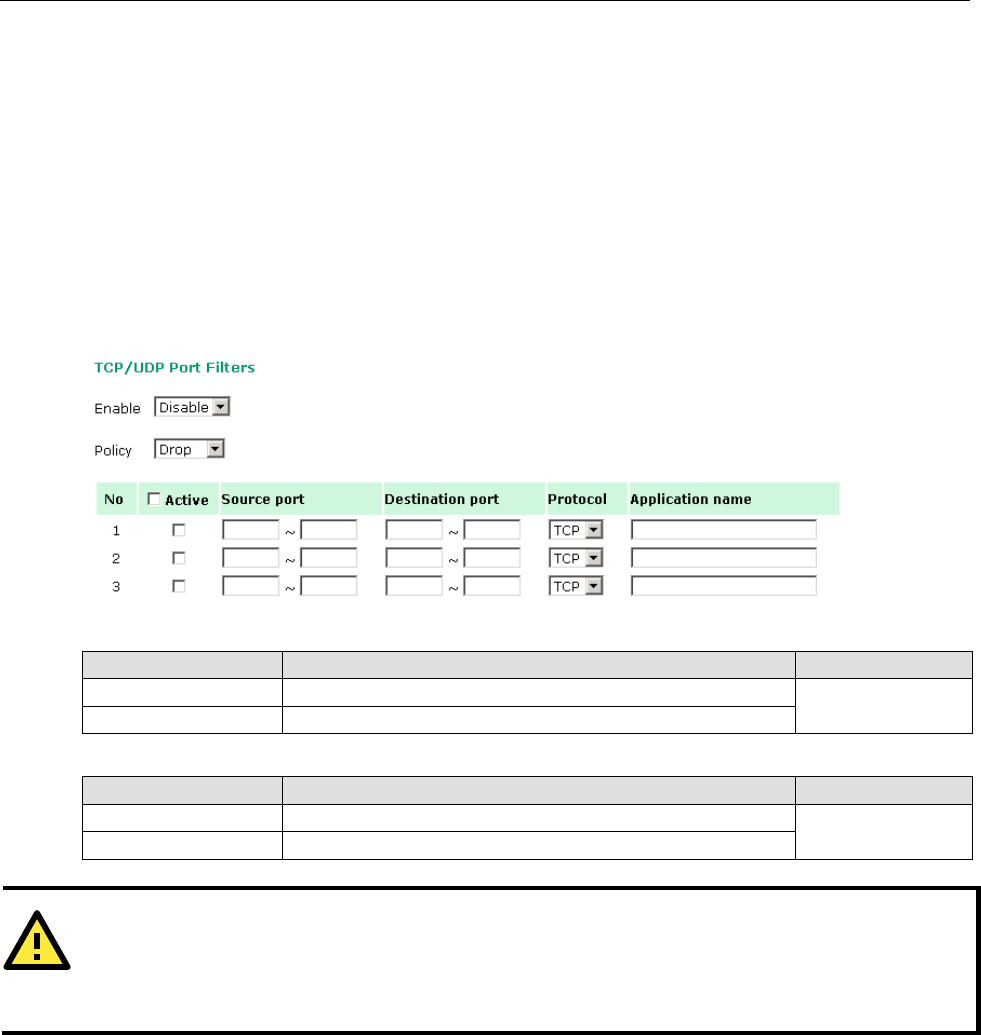
AirWorks AWK-4131A Web Console Configuration
3-28
TCP/UDP Port Filter
The AWK-4131A’s TCP/UDP port filter is a policy-based filter that can allow or filter out TCP/UDP-based packets
with a specified source or destination port.
The AWK-4131A provides 8 entities for setting the range of source/destination ports of a specific protocol. In
addition to selecting TCP or UDP protocol, you can set either the source port, destination port, or both. The end
port can be left empty if only a single port is specified. Of course, the end port cannot be larger then the start
port.
The Application name is a text string that describes the corresponding entity with up to 31 characters.
Remember to check the Active check box for each entity to activate the setting.
Enable
Setting Description Factory Default
Enable Enables TCP/UDP port filter Disable
Disable Disables TCP/UDP port filter
Policy
Setting Description Factory Default
Accept Only the packets fitting the entities on list can be allowed. Drop
Drop Any packet fitting the entities on list will be denied.
ATTENTION
Be careful when you enable the filter
function:
Drop + “
no entity on list is activated” = all packets are allowed
Accept + “
no entity on list is activated” = all packets are denied
RSTP Settings (for WDS, Maste, or Slave mode only)
AWK-4131A supports IEEE802.1D Spanning Tree Protocol and IEEE802.1w Rapid STP standards. In addition to
eliminating unexpected path looping, STP/RSTP can provide a backup path recovery if a wired/ wireless path
fails accidentally. The reliability and availability can increase because this fail-over function.
AWK-4131A’s STP/RSTP feature is disabled by default. To be completely effective, you must enable RSTP/STP
on every AWK-4131A connected to your network. If AWK-4131A plays a Client role, which is connected to a
device (PLC, RTU, etc.) as opposed to network switch equipment, it is not necessary to enable STP/RSTP. The
reason is that it will cause unnecessary negotiation. AWK-4131As support STP/RSTP in AP mode (including
WDS) only.
The following figures indicate which Spanning Tree Protocol parameters can be configured. A more detailed
explanation of each parameter is given below the figure.
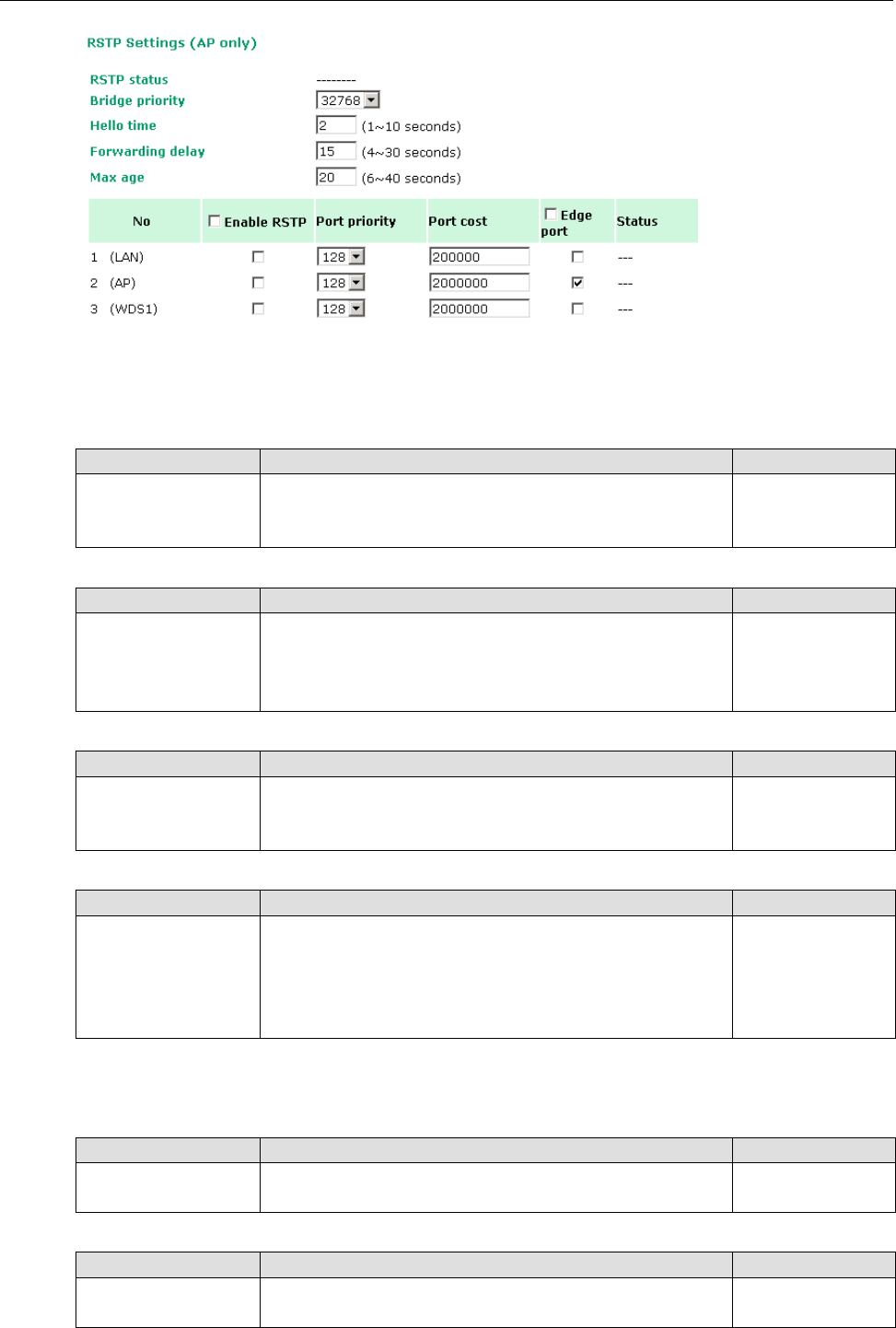
AirWorks AWK-4131A Web Console Configuration
3-29
RSTP status
This field will appear only when selected to operate STP/RSTP. It indicates whether this AWK-4131A is the Root
of the Spanning Tree (the root is determined automatically) or not.
Bridge priority
Setting Description Factory Default
Numerical value
selected
by user
You can increase the bridge priority by selecting a lower
number. A higher bridge priority brings a greater chance of
being established as the root of the Spanning Tree topology.
32768
Hello time
Setting Description Factory Default
Numerical value input
by user
(1 – 10 seconds)
The root of the Spanning Tree topology periodically sends out a
“hello” message to other devices on the network to check if the
topology is healthy. Hello time indicates how often the root
sends hello messages.
2 (seconds)
Forwarding delay
Setting Description Factory Default
Numerical value input
by user
(4 – 30 seconds)
The
amount of time this device waits before checking to see if it
should change to a different topology. 15 (seconds)
Max. age
Setting Description Factory Default
Numerical value input
by user
(6 – 40 seconds)
As a non-root role, if the device has not received a hello
message from the root longer than Max. age, it will reconfigure
itself as a root. Once two or more devices on the network are
recognized as a root, the devices will renegotiate to set up a
new Spanning Tree topology.
20 (seconds)
The AWK-4131A comes with 10 “ports” for RSTP settings. Numbers 3-10 (WDS1-WDS8) are available only
when WDS is enabled in AP mode.
Enable RSTP
Setting Description Factory Default
Enable/ disable Enables or disables the port as a node on the Spanning Tree
topology. Disable (unchecked)
Port priority
Setting Description Factory Default
Numerical value
selected by user Increase this port’s priority as a node on the Spanning Tree
topology by inputting a lower number. 128
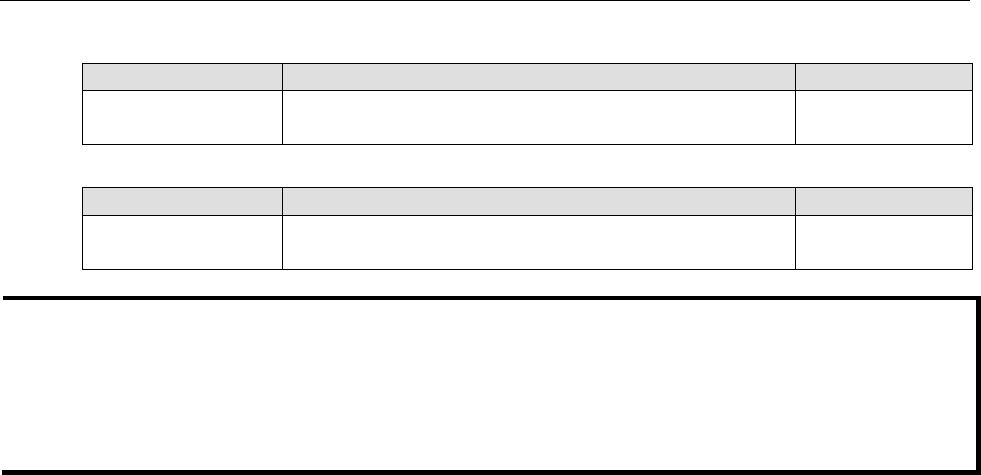
AirWorks AWK-4131A Web Console Configuration
3-30
Port cost
Setting Description Factory Default
Enable/ Disable
Input a higher cost to indicate that this port is less suitable as a
node for the Spanning Tree topology 2000000
Edge port
Setting Description Factory Default
Checked/ unchecked Sets a port, which no BPDU expectedly goes through, as an
edge port unchecked, except
AP port
NOTE
We recommend you set an edge port for the port, which is connected to a non
-STP/RSTP sub-
network or an end
device (PLC, RTU, etc.) as opposed to network equipment. This can prevent unnecessary waiting and
negotiation of STP/RSTP protocol, and accelerate system initialization. When an edge port receives BPDUs, it
can still function as an STP/RSTP port and start negotiation.
Setting an edge port is different from disabling STP/RSTP on a port. If you disable STP/RSTP, a port will not deal
with STP/RSTP BPDUs
at all.
Port Status
Port Status indicates the current Spanning Tree status of this port. Use Forwarding for normal transmission,
or Blocking to block transmission.
SNMP Agent
The AWK-4131A supports SNMP V1/V2c/V3. SNMP V1 and SNMP V2c use a community string match for
authentication, which means that SNMP servers access all objects with read-only or read/write permissions
using the community string public/private (default value). SNMP V3, which requires you to select an
authentication level of MD5 or SHA, is the most secure protocol. You can also enable data encryption to
enhance data security.
The AWK-4131A’s MIB can be found in the software CD and supports reading the attributes via SNMP. (Only
get method is supported.)
This model also supports “MXview” network management software. In the AWK settings, please make sure that
the SNMP settings match MXview's SNMP configuration settings.
SNMP security modes and security levels supported by the AWK-4131A are shown in the following table. Select
the security mode and level that will be used to communicate between the SNMP agent and manager.
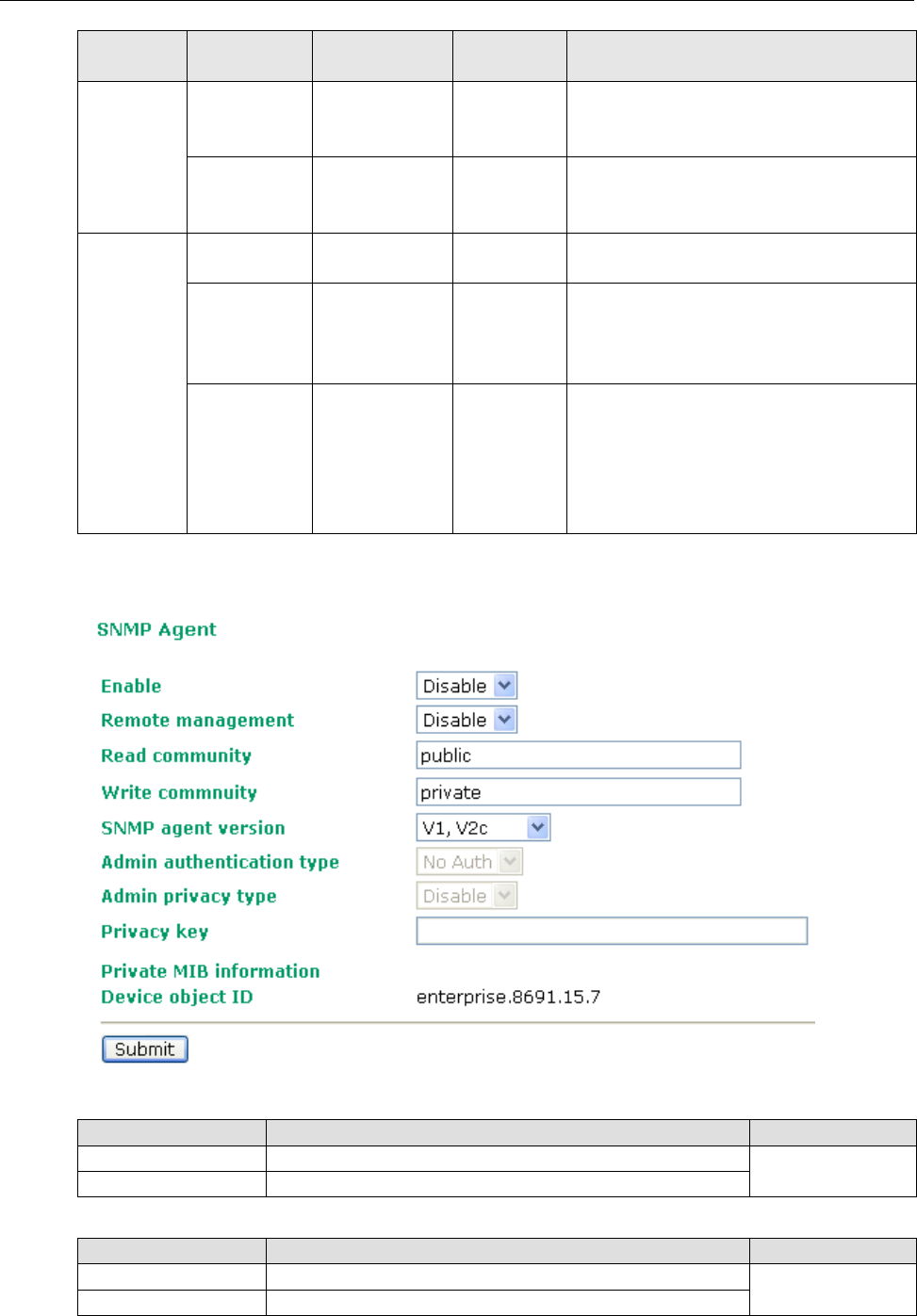
AirWorks AWK-4131A Web Console Configuration
3-31
Protocol
Version
Setting on
UI web page
Authentication
Type
Data
Encryption
Method
SNMP
V1, V2c V1, V2c
Read
Community
Community
string No Use a community string match for
authentication
V1, V2c
Write/Read
Community
Community
string No Use a community string match for
authentication
SNMP V3 No-Auth No No Use account with admin or user to access
objects
MD5 or SHA Authentication
based on MD5 or
SHA
No Provides authentication based on
HMAC-MD5, or HMAC-SHA algorithms.
8-character passwords are the minimum
requirement for authentication.
MD5 or SHA Authentication
based on MD5 or
SHA
Data
encryption
key
Provides authentication based on HMAC-
MD5
or HMAC-SHA algorithms, and data
encryption key. 8-character passwords and a
data encryption key are the minimum
requirements for authentication and
encryption.
The following parameters can be configured on the SNMP Agent page. A more detailed explanation of each
parameter is given below the following figure.
Enable
Setting Description Factory Default
Enable Enables SNMP Agent Disable
Disable Disables SNMP Agent
Remote Management
Setting Description Factory Default
Enable Allow remote management via SNMP agent Disable
Disable Disallow remote management via SNMP agent
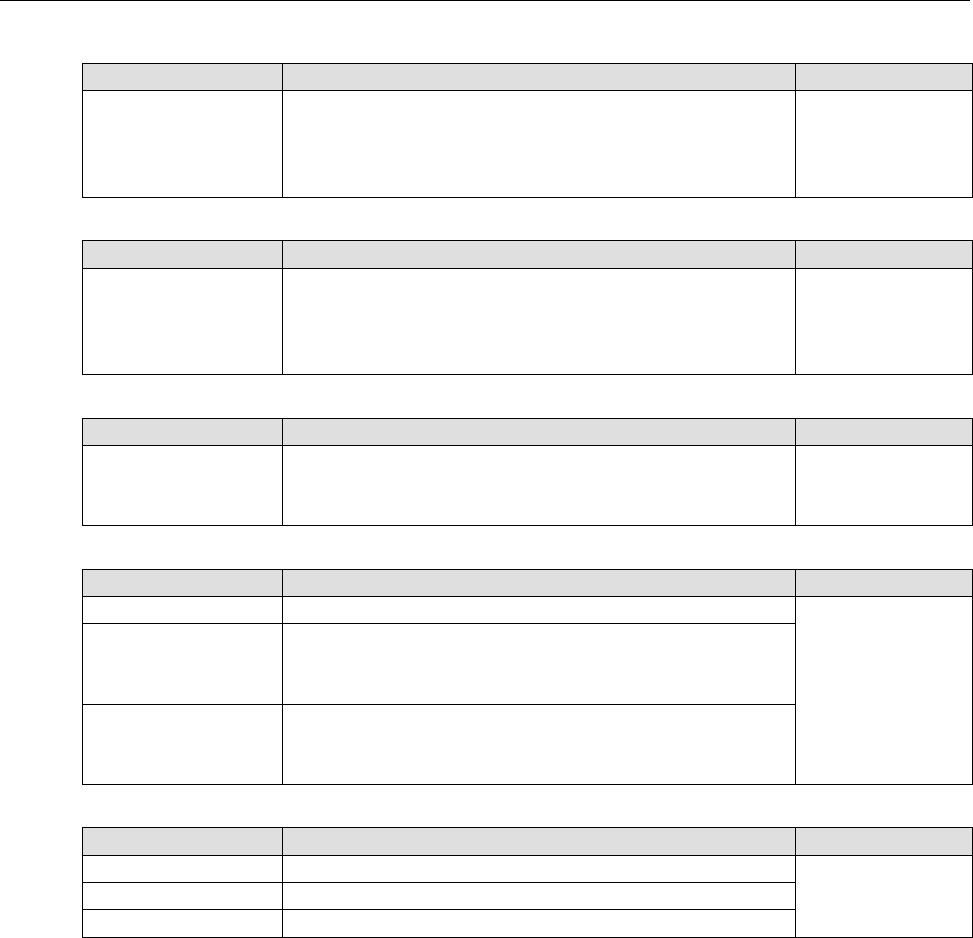
AirWorks AWK-4131A Web Console Configuration
3-32
Read community (for V1, V2c)
Setting Description Factory Default
V1, V2c Read
Community Use a community string match with a maximum of 31
characters for authentication. This means that the SNMP agent
can access all objects with read-only permissions using this
community string.
public
Write community (for V1, V2c)
Setting Description Factory Default
V1, V2c Read /Write
Community Use a community string match with a maximum of 31
characters for authentication. This means that the SNMP agent
can accesses all objects with read/write permissions using this
community string.
private
SNMP agent version
Setting Description Factory Default
V1, V2c, V3, or
V1, V2c, or
V3 only
Select the SNMP protocol version used to manage the switch. V1, V2c
Admin auth type (for V1, V2c, V3, and V3 only)
Setting Description Factory Default
No Auth Use admin account to access objects. No authentication No Auth
MD5 Provide authentication based on the HMAC-MD5 algorithms.
8-character passwords are the minimum requirement for
authentication.
SHA Provides authentication based on
HMAC-SHA algorithms. 8-character passwords are the
minimum requirement for authentication.
Admin private key (for V1, V2c, V3, and V3 only)
Setting Description Factory Default
Disable No data encryption Disable
DES DES-based data encryption
AES AES-based data encryption
Private key
A data encryption key is the minimum requirement for data encryption (maximum of 63 characters)
Private MIB Information Device Object ID
Also know as OID. This is the AWK-4131A’s enterprise value. It is fixed.
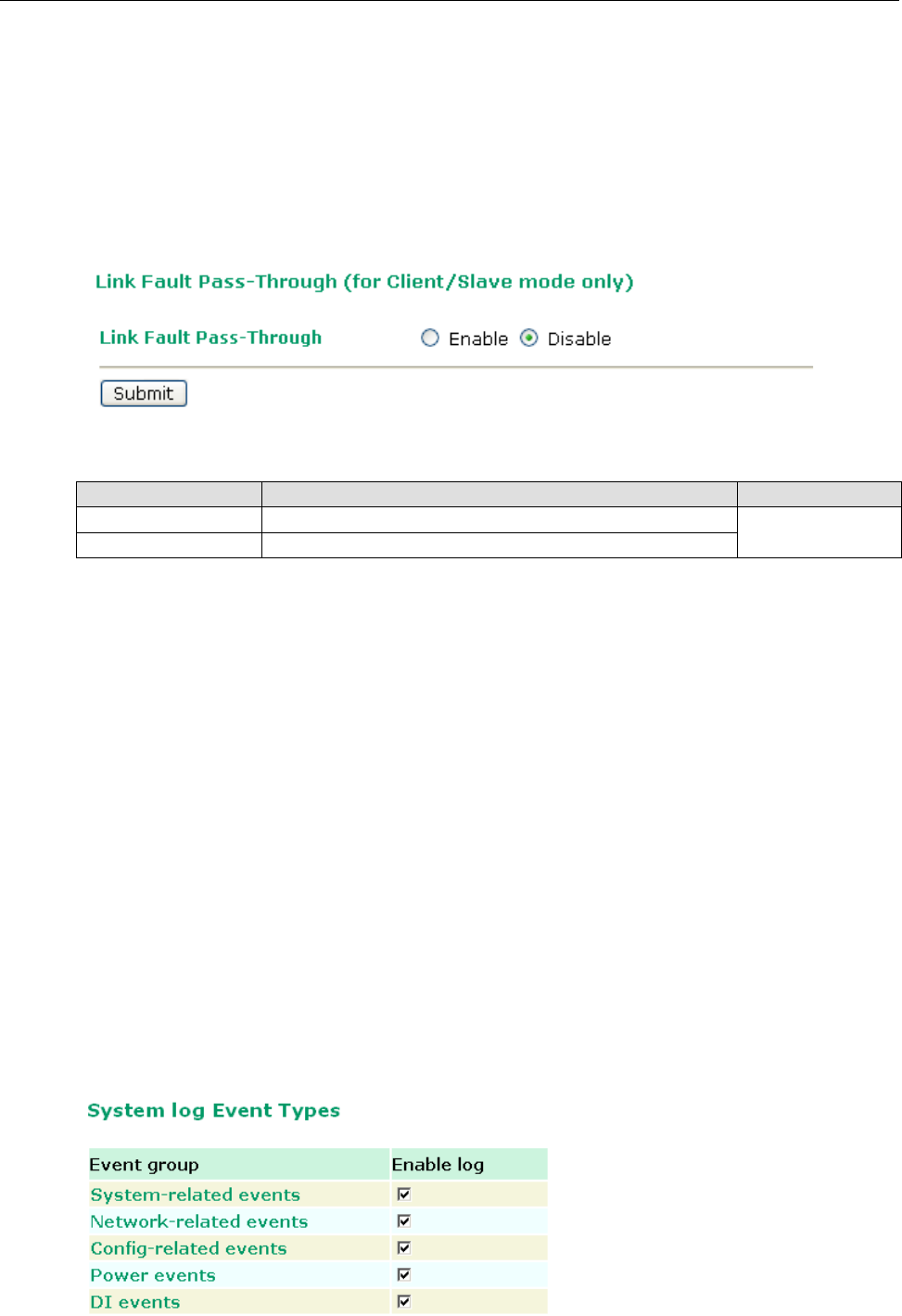
AirWorks AWK-4131A Web Console Configuration
3-33
Link Fault Pass-Through (for Client/Slave mode only)
This function means if Ethernet port is link down, wireless connection will be forced to disconnect. Once
Ethernet link is recovered, AWK will try to connect to AP.
If wireless is disconnected, AWK restarts auto-negotiation on Ethernet port but always stays in the link failure
state. Once the wireless connection is recovered, AWK will try to recover the Ethernet link.
System log will indicate the link fault pass through events in addition to the original link up/down events.
Link Fault Pass-Through
Setting Description Factory Default
Enable Enables Link Fault Pass-Through Disable
Disable Disable Link Fault Pass-Through
Auto Warning Settings
Since industrial-grade devices are often located at the endpoints of a system, these devices will not always
know what is happening elsewhere on the network. This means that these devices, including wireless APs or
clients, must provide system maintainers with real-time alarm messages. Even when system administrators
are out of the control room for an extended period, they can still be informed of the status of devices almost
instantaneously when exceptions occur.
In addition to logging these events, the AWK-4131A supports different approaches to warn engineers
automatically, such as SNMP trap, e-mail, and relay output. It also supports two digital inputs to integrate
sensors into your system to automate alarms by email and relay output.
System Log
System Log Event Types
Detail information for grouped events is shown in the following table. You can check the box for Enable log to
enable the grouped events. All default values are enabled (checked). The log for system events can be seen in
Status
System Log.
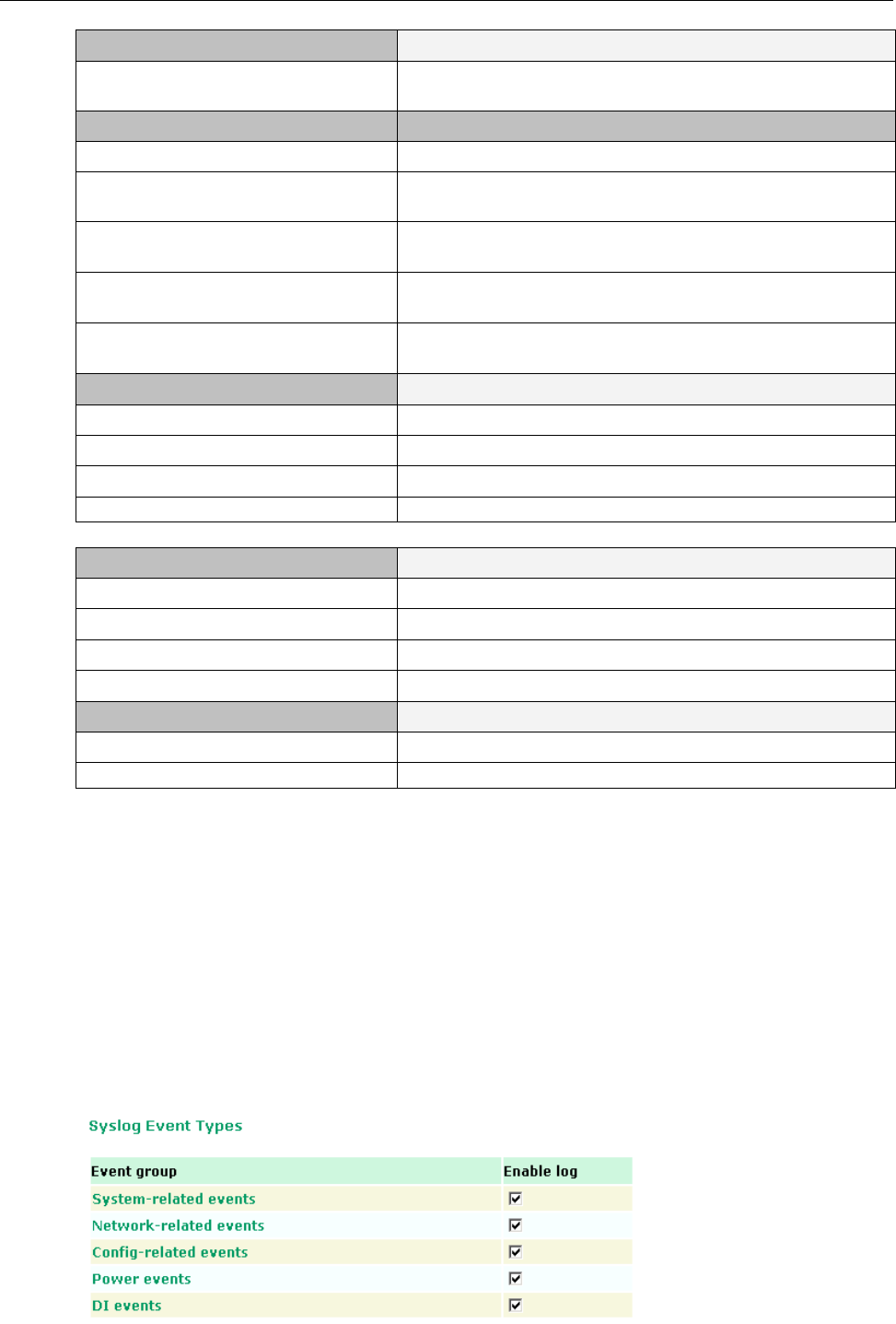
AirWorks AWK-4131A Web Console Configuration
3-34
System-related events Event is triggered when…
System restart (warm start) The AWK-4131A is rebooted, such as when its settings are
changed (IP address, subnet mask, etc.).
Network-related events Event is triggered when…
LAN link on The LAN port is connected to a device or network.
LAN link off The port is disconnected (e.g., the cable is pulled out, or the
opposing device shuts down).
Client joined/ left
(for AP/Master mode) A wireless client is associated or disassociated.
WLAN connected to AP
(for Client/Slave mode) The AWK-4131A is associated with an AP.
WLAN disconnected
(for Client/Slave mode) The AWK-4131A is disassociated from an AP.
Config-related events Event is triggered when…
Configuration Changed A configuration item has been changed.
Configuration file import via Web Console The configuration file is imported to the AWK-4131A.
Console authentication failure An incorrect password is entered.
Firmware upgraded The AWK-4131A’s firmware is updated.
Power events Event is triggered when…
Power 1/2 transition (On → Off) The AWK-4131A is powered down in PWR1/2.
PoE transition (On → Off) The AWK-4131A is powered down in PoE.
Power 1/2 transition (Off → On) The AWK-4131A is powered via PWR1/2.
PoE transition (Off → On) The AWK-4131A is powered via PoE.
DI events Event is triggered when…
DI1/2 transition (On
→
Off)
Digital Input 1/2 is triggered by on to off transition
DI1/2 transition (Off → On) Digital Input 1/2 is triggered by off to on transition
Syslog
This function provides the event logs for the Syslog server. The function supports up to three configurable
Syslog servers and Syslog server UDP port numbers. When an event occurs, the event will be sent as a Syslog
UDP packet to the specified Syslog servers.
Syslog Event Types
Detail information for the grouped events is shown in the following table. You can check the box for Enable log
to enable the grouped events. All default values are enabled (checked). Details for each event group can be
found on the “System log Event Types” table on page 3-31.
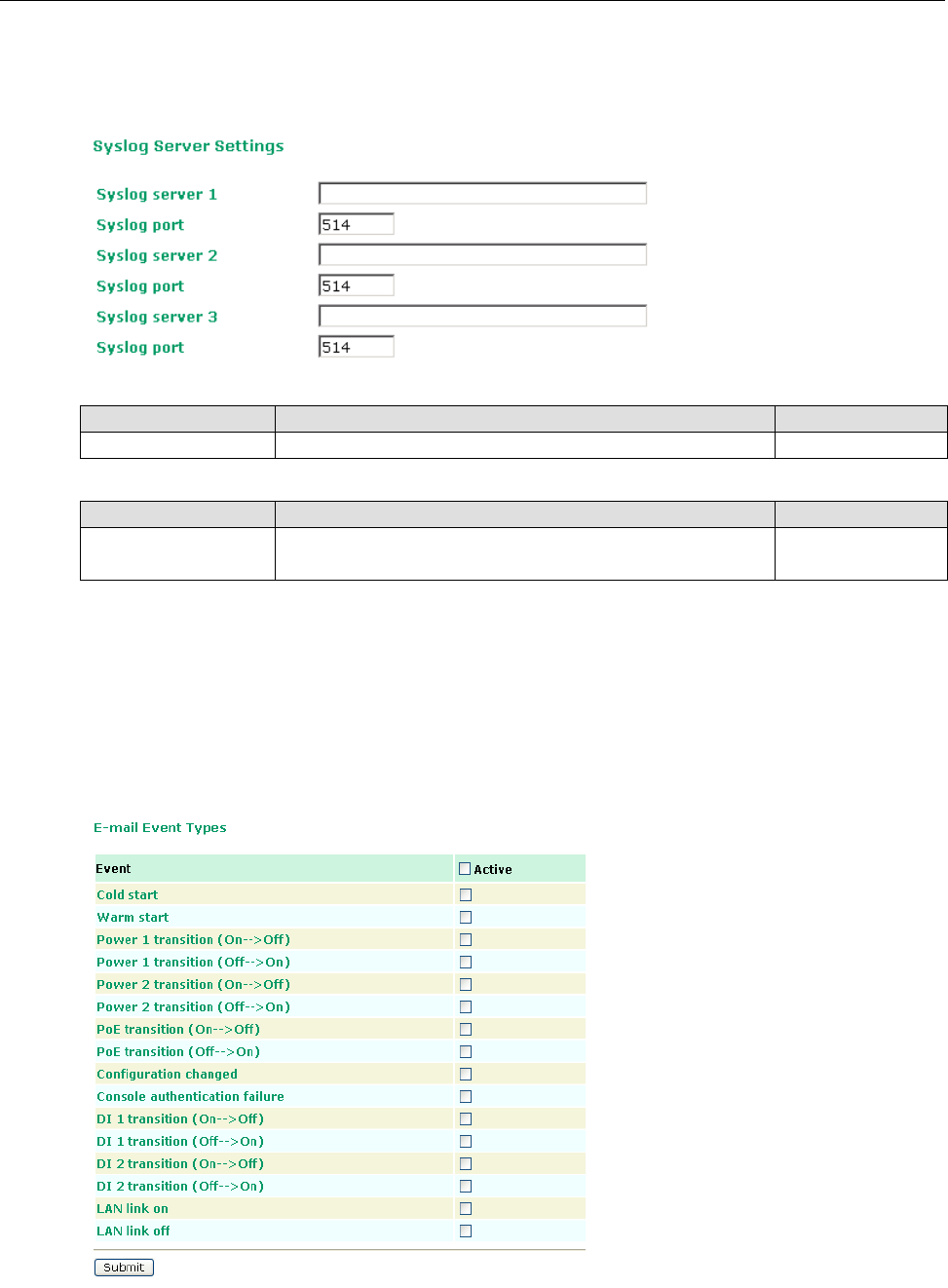
AirWorks AWK-4131A Web Console Configuration
3-35
Syslog Server Settings
You can configure the parameters for your Syslog servers in this page.
Syslog server 1/ 2/ 3
Setting Description Factory Default
IP address Enter the IP address of the 1st/ 2nd/ 3rd Syslog Server None
Syslog port
Setting Description Factory Default
Port destination
(1 to 65535) Enter the UDP port of the corresponding Syslog server 514
E-mail
E-mail Event Types
Check the box for Active to enable the event items. All default values are deactivated (unchecked). Details for
each event item can be found on the “System log Event Types” table on page 3-31.
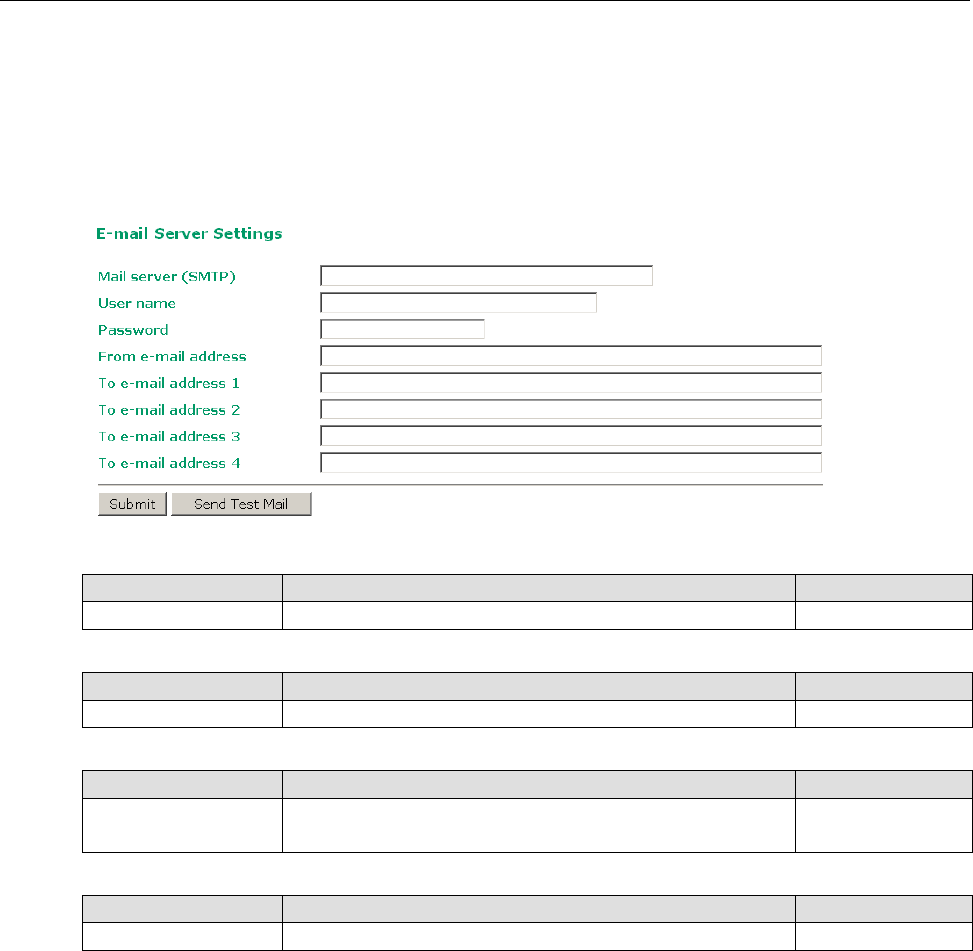
AirWorks AWK-4131A Web Console Configuration
3-36
E-mail Server Settings
You can set up to 4 e-mail addresses to receive alarm emails from the AWK-4131A. The following parameters
can be configured on the E-mail Server Settings page. Besides, a Send Test Mail button can be used to test
whether the Mail server and e-mail addresses are working. More detailed explanations for these parameters
are provided after the following figure.
Mail server (SMTP)
Setting Description Factory Default
IP address The IP address of your email server. None
User name & Password
Setting Description Factory Default
User name and password used in the SMTP server None
From e-mail address
Setting Description Factory Default
Max. 63 characters Enter the administrator’s e-
mail address which will be shown in
the “From” field of a warning e-mail. None
To E-mail address 1/ 2/ 3/ 4
Setting Description Factory Default
Max. 63 characters Enter the receivers’ e-mail addresses. None
Relay
The AWK-4131A has one relay output, which consists of 2 terminal block contacts on the AWK-4131A’s top
panel. These relay contacts are used to indicate user-configured events and system failure.
The two wires attached to the relay contacts form an open circuit when a user-configured event is triggered. If
a user-configured event does not occur, the relay circuit will remain closed. For safety reasons, the relay circuit
is kept open when the AWK-4131A is not powered.
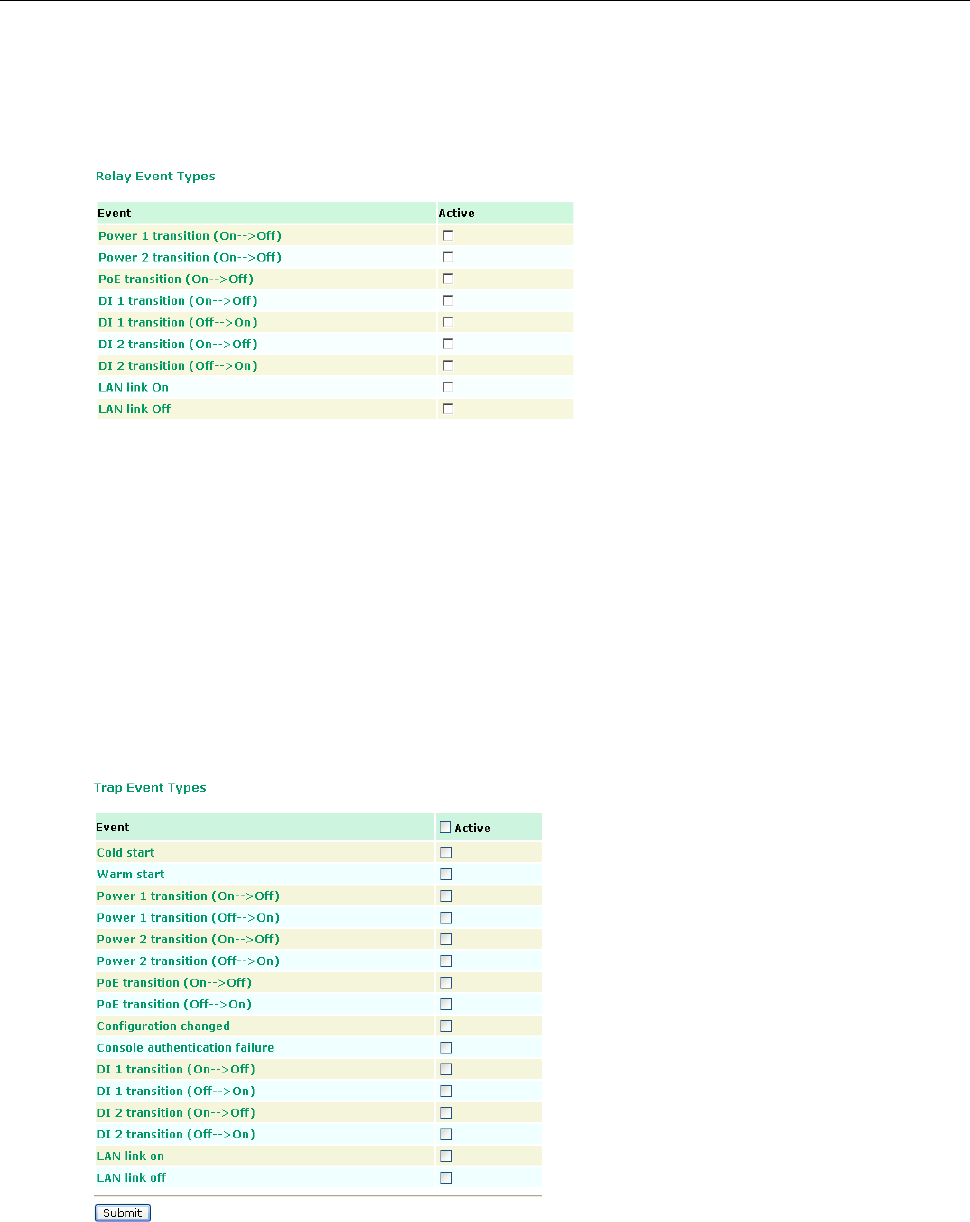
AirWorks AWK-4131A Web Console Configuration
3-37
Relay Event Types
You can check the box for Active to enable the event items. All default values are deactivated (unchecked).
Details for each event item can be found in the “System log Event Types” table on page 3-31.
Trap
Traps can be used to signal abnormal conditions (notifications) to a management station. This trap-driven
notification can make your network more efficient.
Because a management station usually takes care of a large number of devices that have a large number of
objects, it will be overloading for the management station to poll or send requests to query every object on
every device. It would be better if the managed device agent could notify the management station by sending
a message known as a trap for the event.
Trap Event Types
SNMP Trap Receiver Settings
SNMP traps are defined in SMIv1 MIBs (SNMPv1) and SMIv2 MIBs (SNMPv2c). The two styles are basically
equivalent, and it is possible to convert between the two. You can set the parameters for SNMP trap receivers
through the web page.
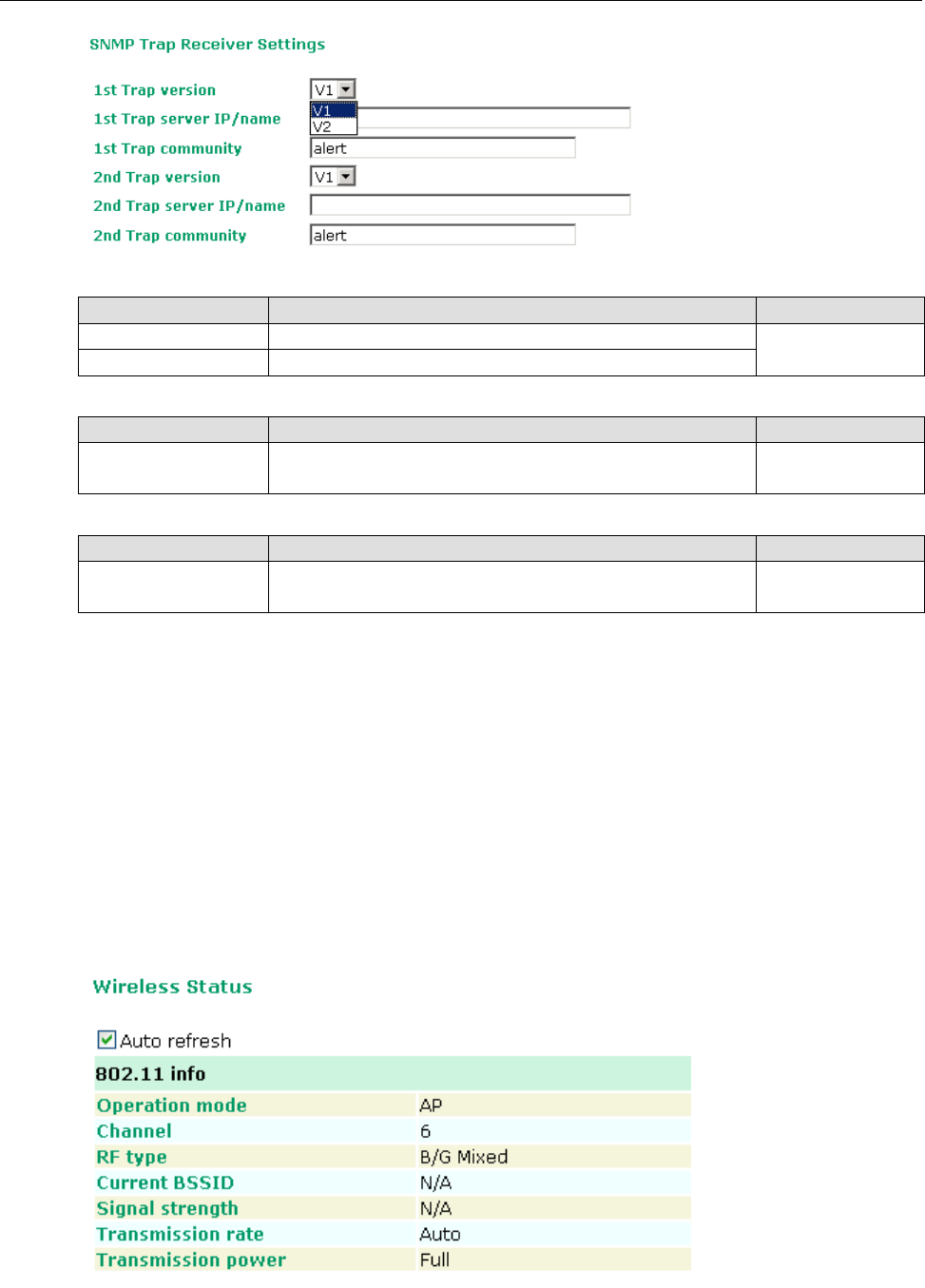
AirWorks AWK-4131A Web Console Configuration
3-38
1st / 2nd Trap version
Setting Description Factory Default
V1 SNMP trap defined in SNMPv1 V1
V2 SNMP trap defined in SNMPv2
1st / 2nd Trap server IP/name
Setting Description Factory Default
IP address or host
name Enter the IP address or name of the trap server used by your
network. None
1st / 2nd Trap community
Setting Description Factory Default
Max. 31 characters Use a community string match with a maximum of 31
characters for authentication. Alert
Status
Wireless Status
The status for 802.11 info parameters, such as Operation mode and Channel, are shown on the Wireless
Status page. The status will refresh every 5 seconds if the Auto refresh box is checked.
Certain values for 802.11 info may not show up due to different operation modes. As a result, Current BSSID
and Signal strength are not available in AP mode.
It is helpful to use the continuously updated information on this page, such as Signal strength, to monitor the
signal strength of the AWK-4131A in Client mode.
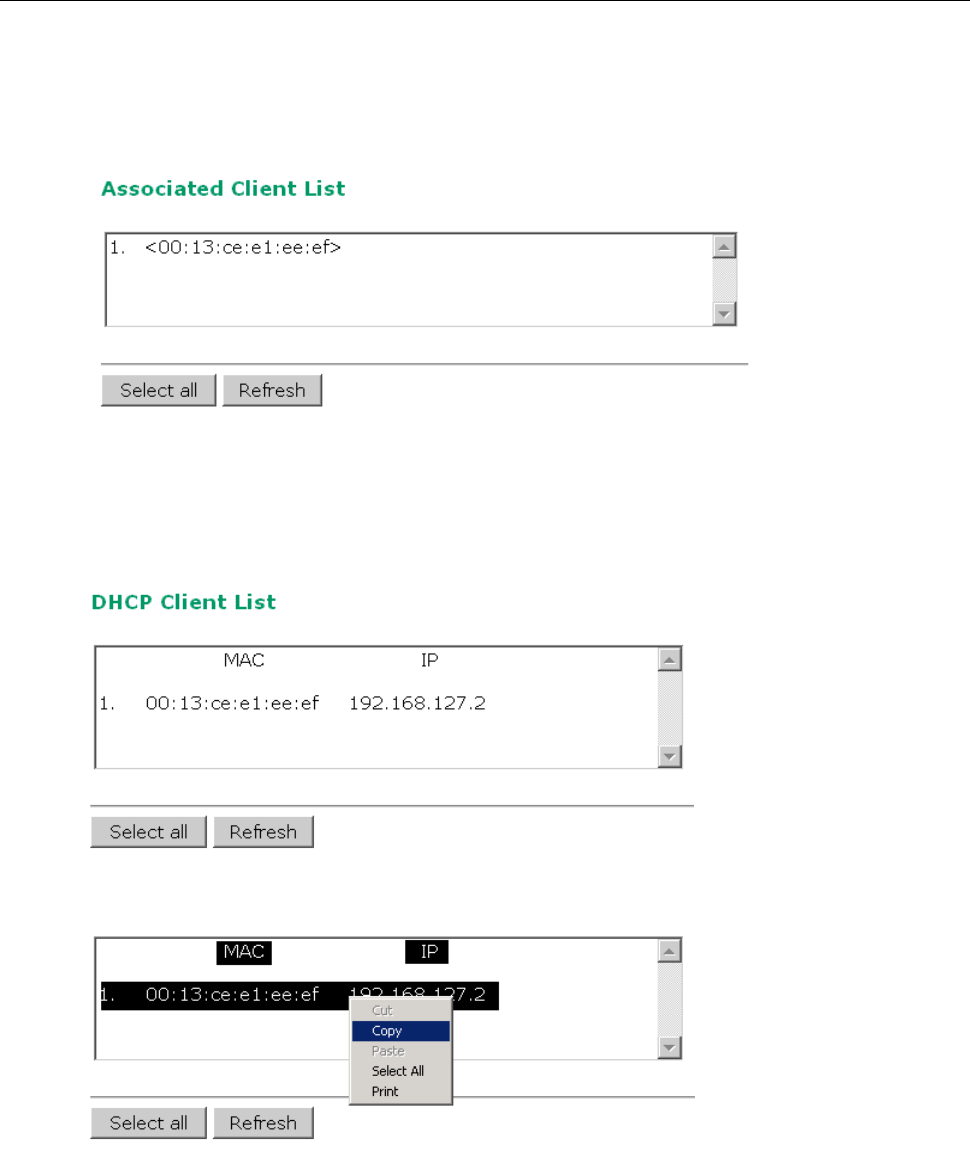
AirWorks AWK-4131A Web Console Configuration
3-39
Associated Client List (for AP mode only)
Associated Client List shows all the clients that are currently associated with a specific AWK-4131A. You can
click Select all to select all the content in the list for further editing. You can click Refresh to refresh the list.
DHCP Client List (for AP mode only)
The DHCP Client List shows all the clients that require and have successfully received IP assignments. You can
click the Refresh button to refresh the list.
You can press Select all button to select all content in the list for further editing.
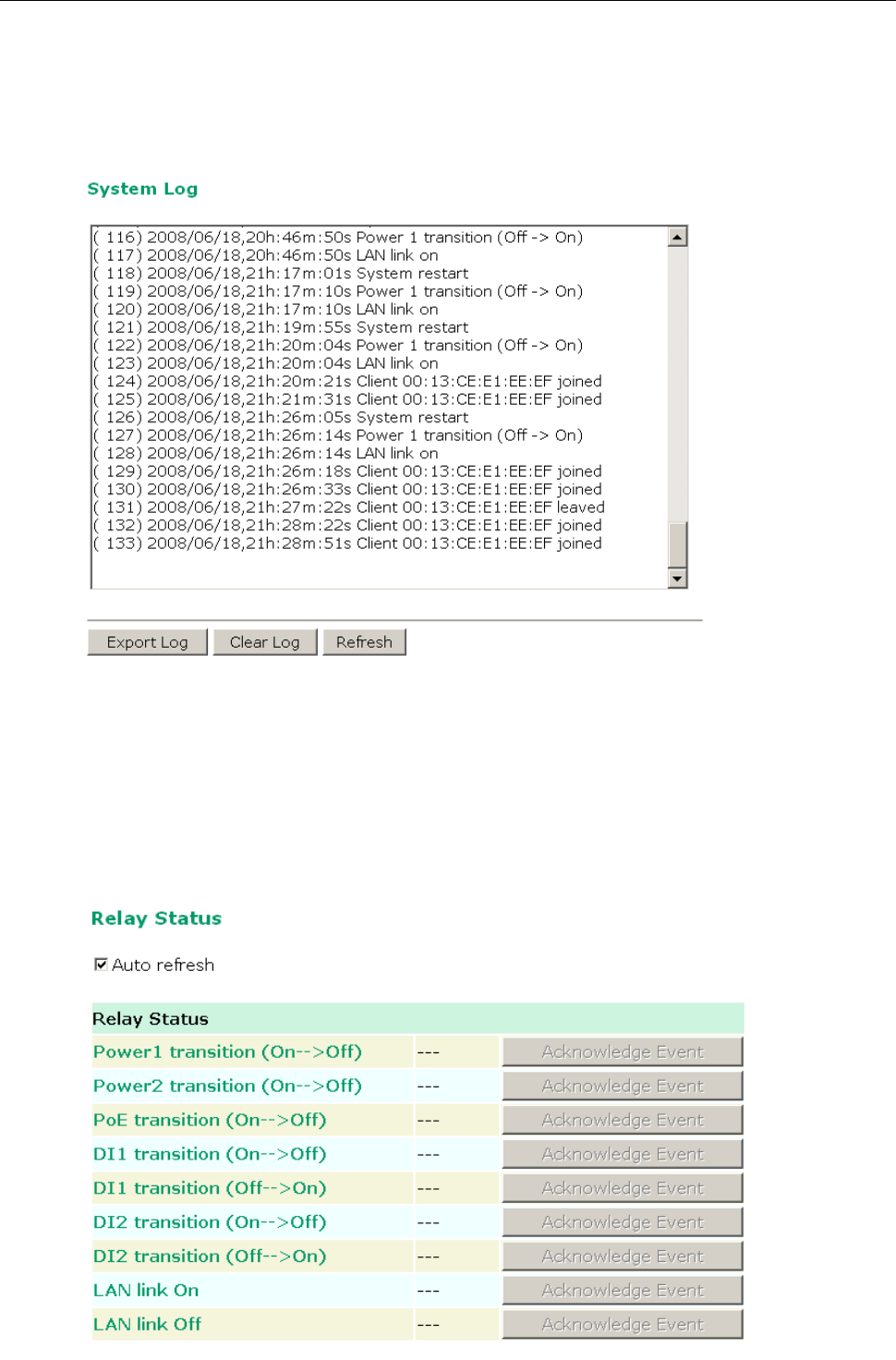
AirWorks AWK-4131A Web Console Configuration
3-40
System Log
Triggered events are recorded in System Log. You can export the log contents to an available viewer by clicking
Export Log. You can use the Clear Log button to clear the log contents and the Refresh button to refresh the
log.
Relay Status
The status of user-configurable events can be found under Relay Status. The status will refresh every 5
seconds if the Auto refresh box is checked.
If an event is triggered, it will be noted on this list. System administrators can click Acknowledge Event when
he has acknowledged the event and addressed it.
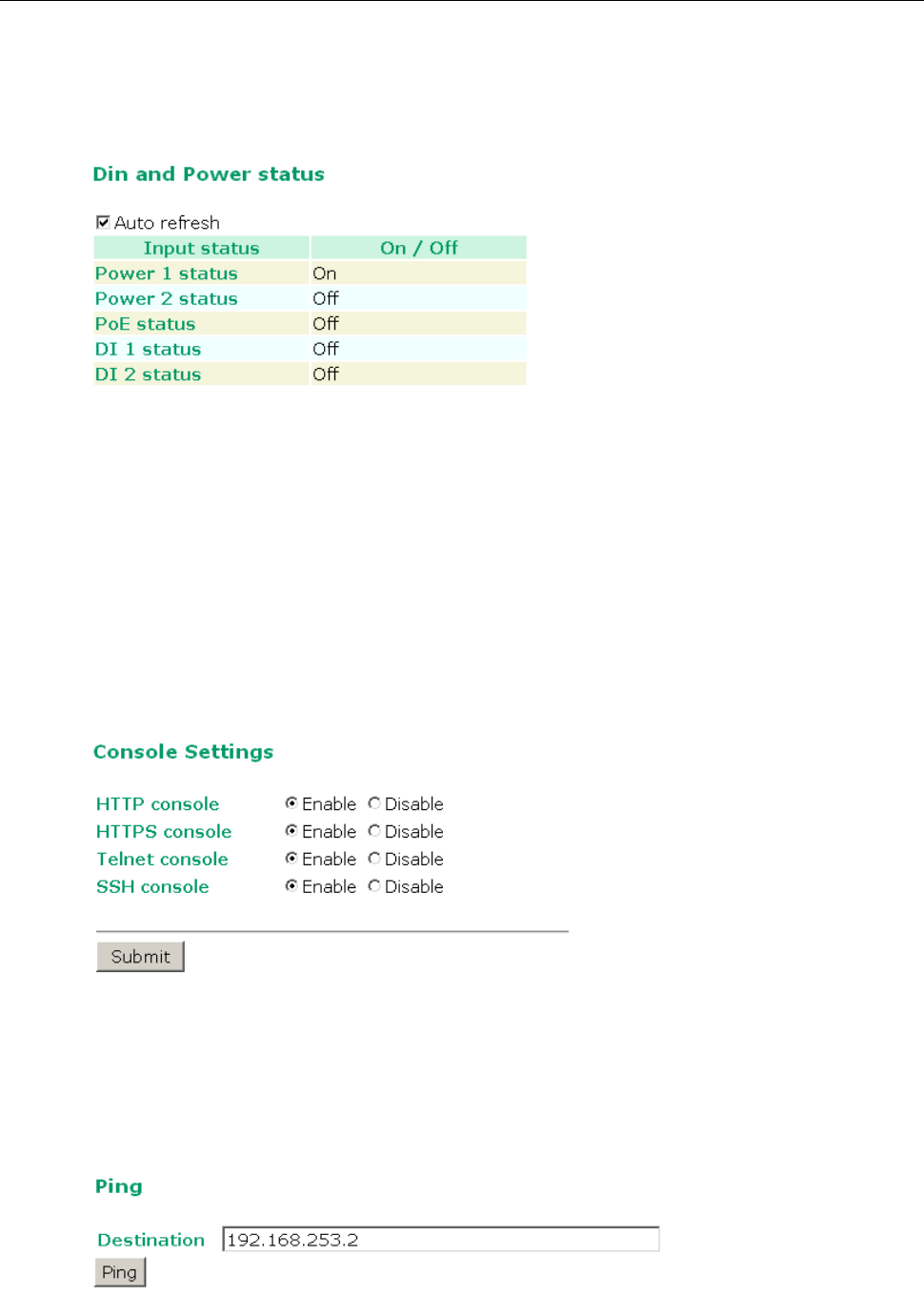
AirWorks AWK-4131A Web Console Configuration
3-41
DI and Power Status
The status of power inputs and digital inputs is shown on this web page. The status will refresh every 5 seconds
if the Auto refresh box is checked.
Maintenance
Maintenance functions provide the administrator with tools to manage the AWK-4131A and wired/wireless
networks.
Console Settings
You can enable or disable access permission for the following consoles: HTTP, HTTPS, Telnet and SSH
connections. For more security, we recommend you only allow access to the two secured consoles, HTTPS and
SSH.
Ping
Ping helps to diagnose the integrity of wired or wireless networks. By inputting a node’s IP address in the
Destination field, you can use the ping command to make sure it exists and whether or not the access path
is available.
If the node and access path are available, you will see that all packets were successfully transmitted with no
loss. Otherwise, some, or even all, packets may get lost, as shown in the following figure.
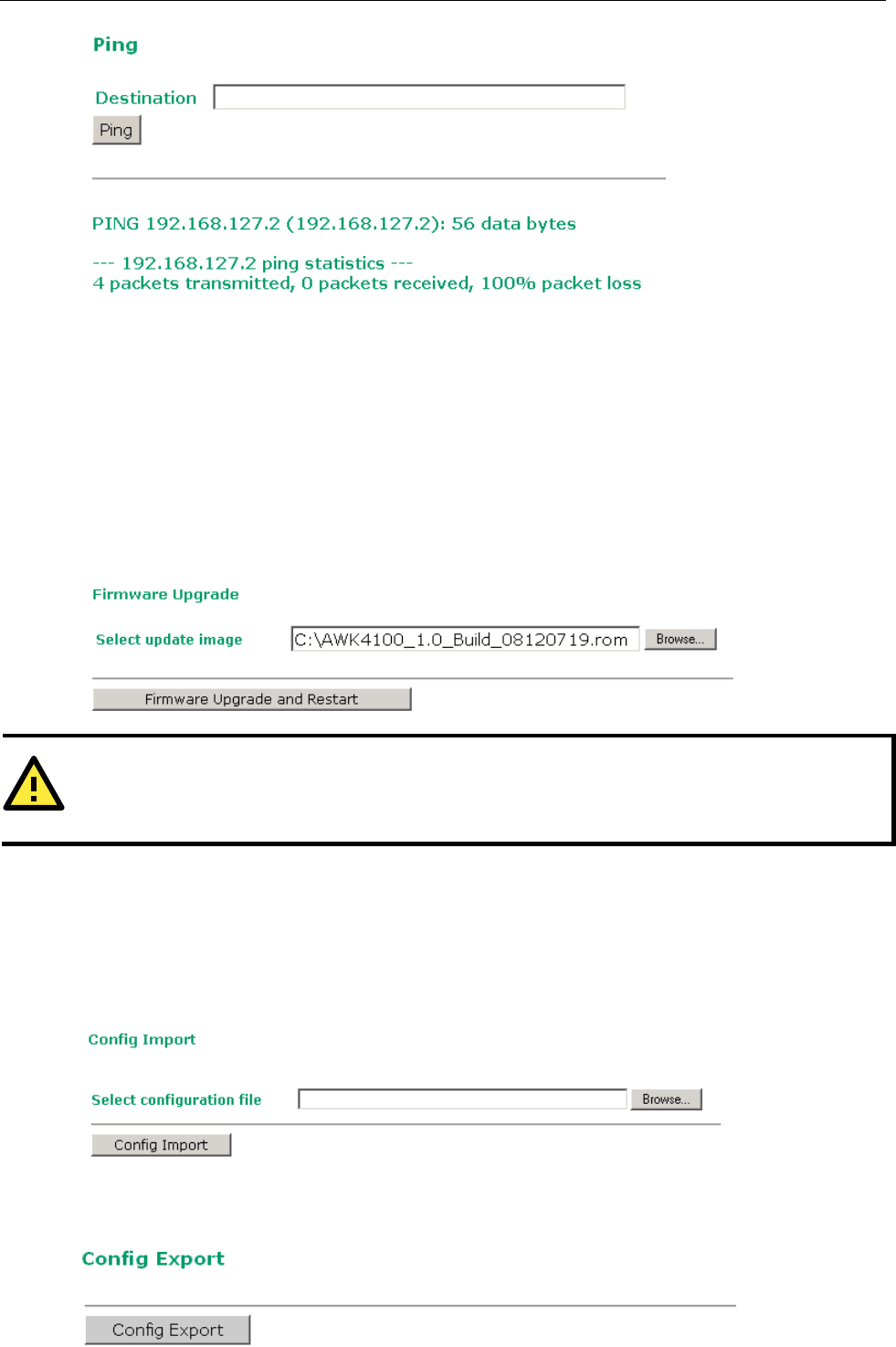
AirWorks AWK-4131A Web Console Configuration
3-42
Firmware Upgrade
The AWK-4131A can be enhanced with more value-added functions by installing firmware upgrades. The latest
firmware is available at Moxa’s download center.
Before running a firmware upgrade, make sure the AWK-4131A is off-line. Click the Browse button to specify
the firmware image file and click Firmware Upgrade and Restart to start the firmware upgrade. After the
progress bar reaches 100%, the AWK-4131A will reboot itself.
When upgrading your firmware, the AWK-4131A’s other functions are forbidden.
ATTENTION
Please make sure the power source is stable when you upgrade your firmware. An unexpected power breakup
may damage your
AWK-4131A.
Config Import Export
You can back up or restore the AWK-4131A’s configuration with Config Import Export.
In the Config Import section, click Browse to specify the configuration file and click Config Import button
to begin importing the configuration.
In the Config Export section, click the Config Export button and save the configuration file onto your local
storage media. The configuration file is a text file and you can view and edit it with a general text-editing tool.
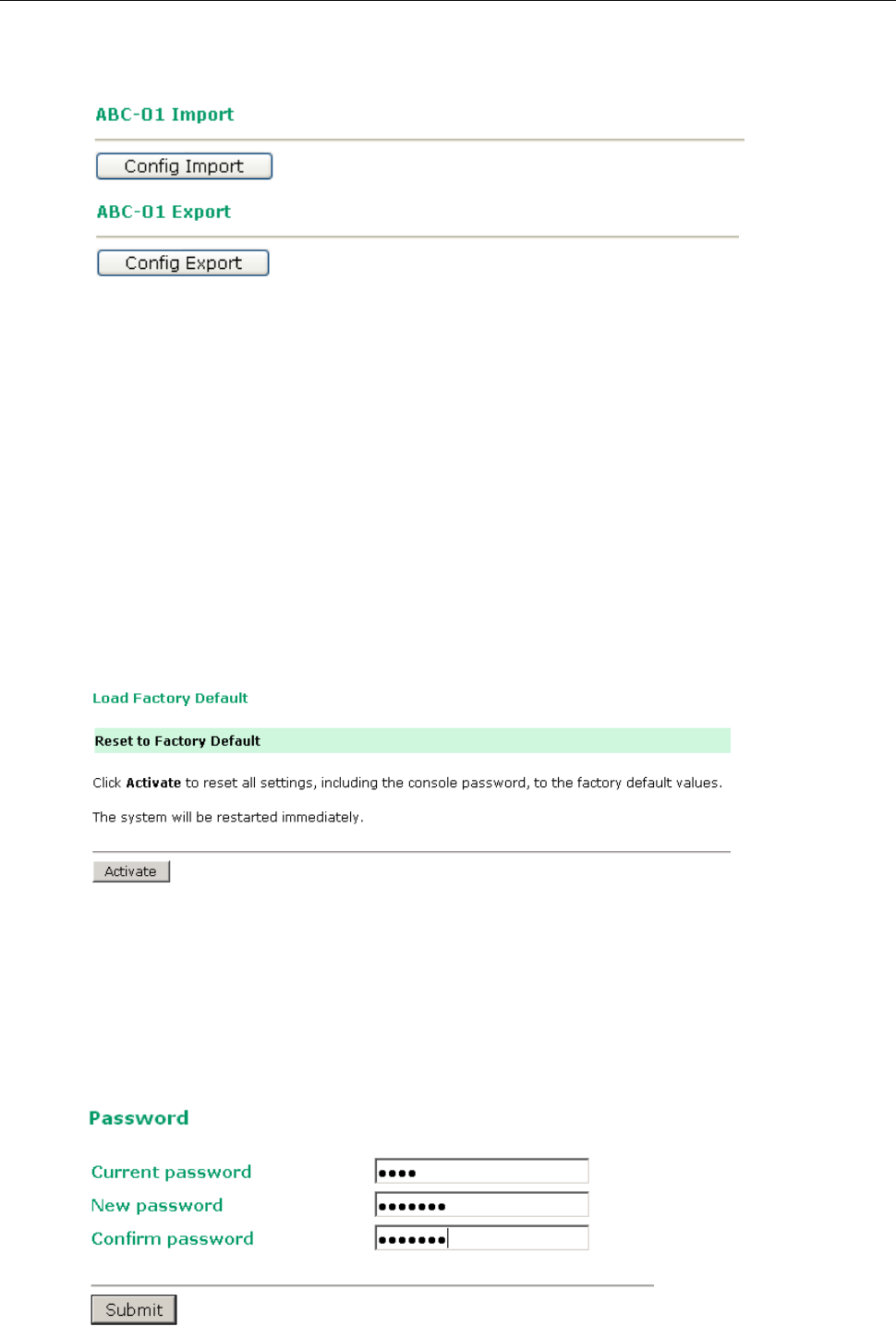
AirWorks AWK-4131A Web Console Configuration
3-43
You can also back up or restore the ABC-01 (HW Rev. 1.1 support only) configuration with Config Import
Export.
To download the configuration to the AWK:
1. Turn off the AWK.
2. Plug in the ABC-01 to the AWK’s RS-232 console.
3. Turn on AWK.
4. AWK will detect ABC-01 during bootup, and download the configuration from the ABC-01 to the AWK
automatically. Once the configuration downloads and if configuration format is correct, the AWK will emit
three short beeps, then continue the boot up.
5. Once the AWK has booted up successfully, it will emit the normal two beeps, and the ready LED will turn to
solid green.
Load Factory Default
Use this function to reset the AWK-4131A and roll all settings back to the factory default values. You can also
reset the hardware by pressing the reset button on the top panel of the AWK-4131A.
Password
You can change the administration password for each of the AWK-4131A’s console managers by using the
Password function. Before you set up a new password, you must input the current password and reenter the
new password for confirmation. For your security, do not use the default password root, and remember to
change the administration password regularly.
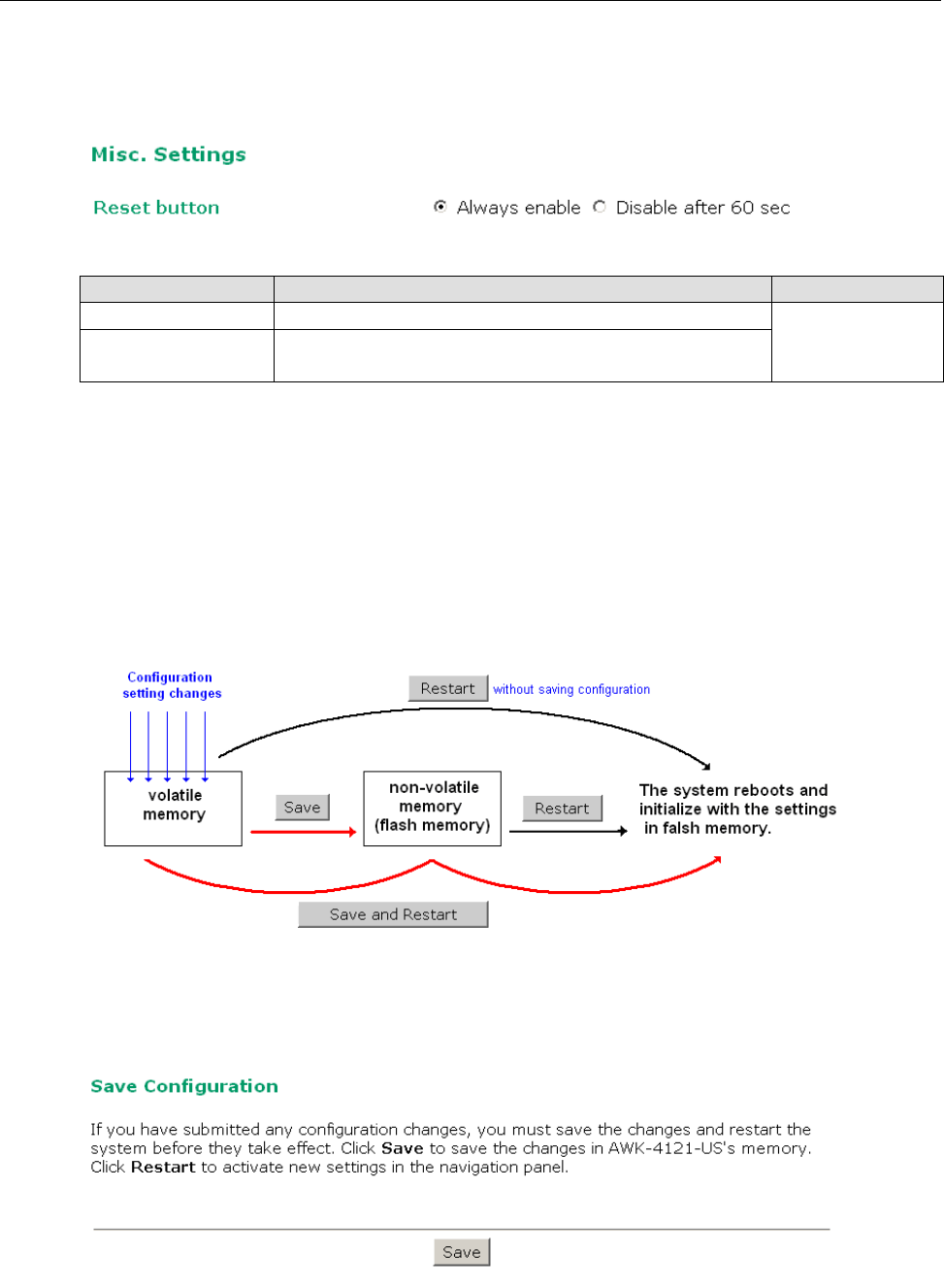
AirWorks AWK-4131A Web Console Configuration
3-44
Misc. Settings
This section provides additional settings that can be used to manage your AWK-4131A more conveniently.
Reset button
Setting Description Factory Default
Always enable The AWK-4131A’s Reset button works normally. Always enable
Disable after 60 sec The AWK-4131A’s reset to default function will become invalid
60 seconds after the AWK-4131A finishes booting up.
Save Configuration
The following figure shows how the AWK-4131A stores the setting changes into volatile and non-volatile
memory. All data stored in volatile memory will disappear when the AWK-4131A is shutdown or rebooted
unless they are y. Because the AWK-4131A starts up and initializes with the settings stored in flash memory,
all new changes must be saved to flash memory before restarting the AWK-4131A.
This also means the new changes will not work unless you run either the Save Configuration function or the
Restart function.
After you click on Save Configuration in the left menu box, the following screen will appear. Click Save if you
wish to update the configuration settings in the flash memory at this time. Alternatively, you may choose to run
other functions and put off saving the configuration until later. However, the new setting changes will remain
in the non-volatile memory until you save the configurations.
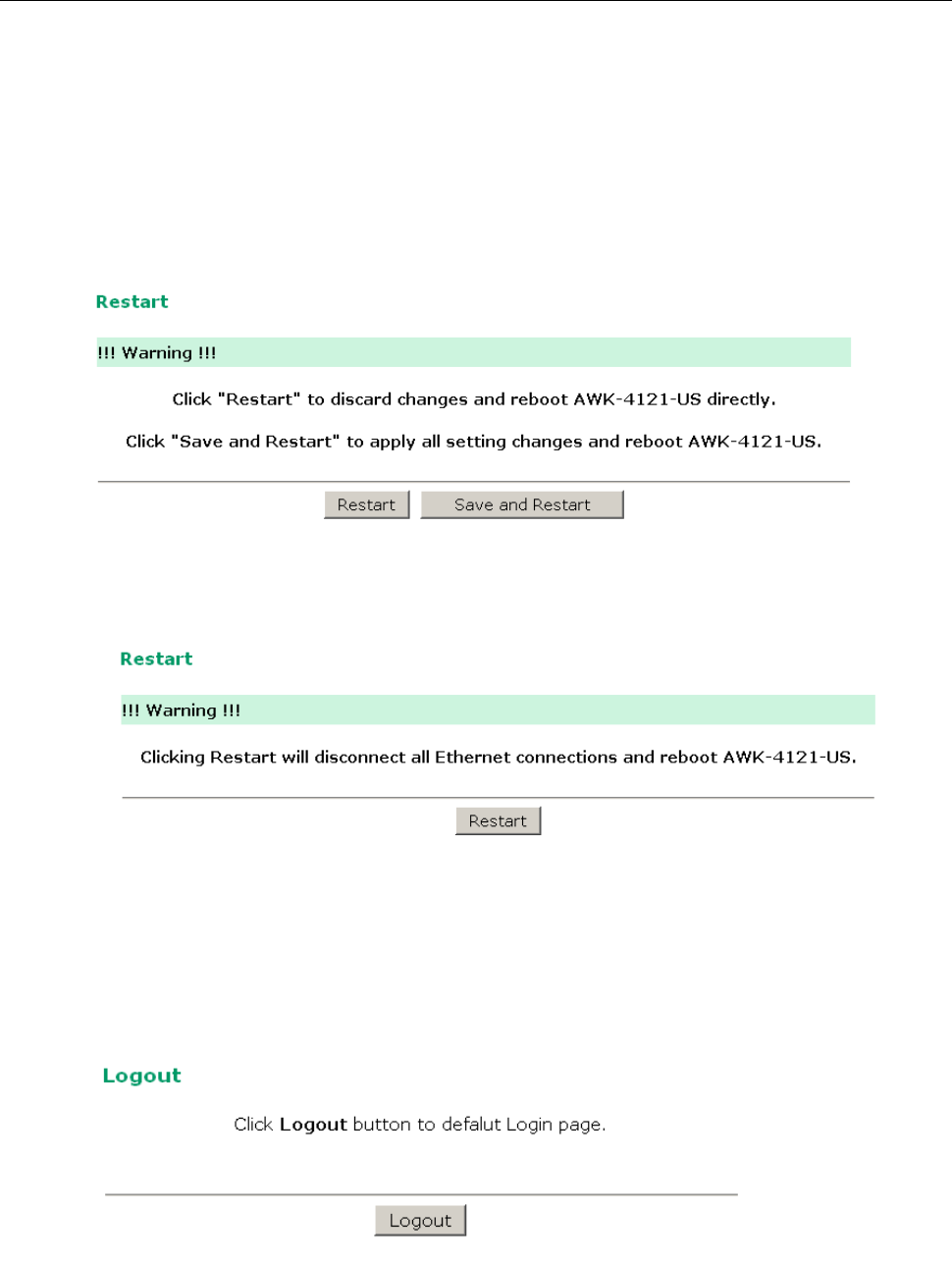
AirWorks AWK-4131A Web Console Configuration
3-45
Restart
If you submitted configuration changes, you will find a blinking string in the upper right corner of the screen.
After making all your changes, click the Restart function in the left menu box. One of two different screens will
appear.
If you made changes recently but did not save, you will be given two options. Clicking the Restart button here
will reboot the AWK-4131A directly, and all setting changes will be ignored. Clicking the Save and Restart
button will apply all setting changes and then reboot the AWK-4131A.
If you run the Restart function without changing any configurations or with all changes already saved, you will
see just one Restart button on your screen.
You will not be able to run any of the AWK-4131A’s functions while the system is rebooting.
Logout
Logout helps users disconnect the current HTTP or HTTPS session and go to the Login page. For security
reasons, we recommend you logout before quitting the console manager.
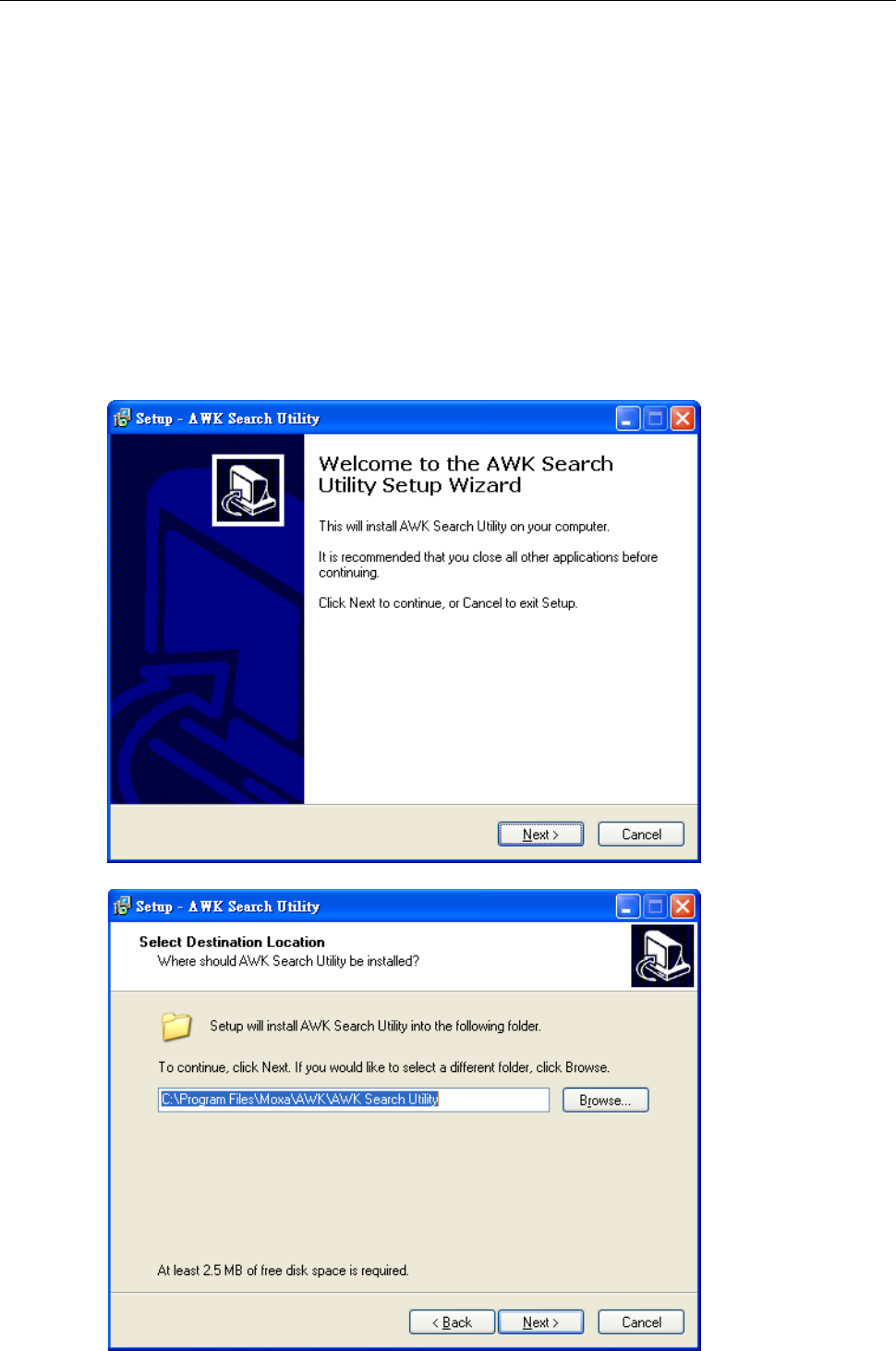
AirWorks AWK-4131A Software Installation/Configuration
4-2
Overview
The Documentation & Software CD included with your AWK-4131A is designed to make the installation and
configuration procedure easy and straightforward. This auto-run CD includes AWK Search Utility (to broadcast
search for all AWK’s accessible over the network), the AWK-4131A User’s Manual, and Quick Installation Guide.
AWK Search Utility
Installing AWK Search Utility
1. Click the INSTALL UTILITY button in the AWK Installation CD auto-run window to install AWK Search
Utility. Once the program starts running, click Yes to proceed.
2. Click Next when the Welcome screen opens to proceed with the installation.
3. Click Next to install program files to the default directory, or click Browse to select an alternate location.
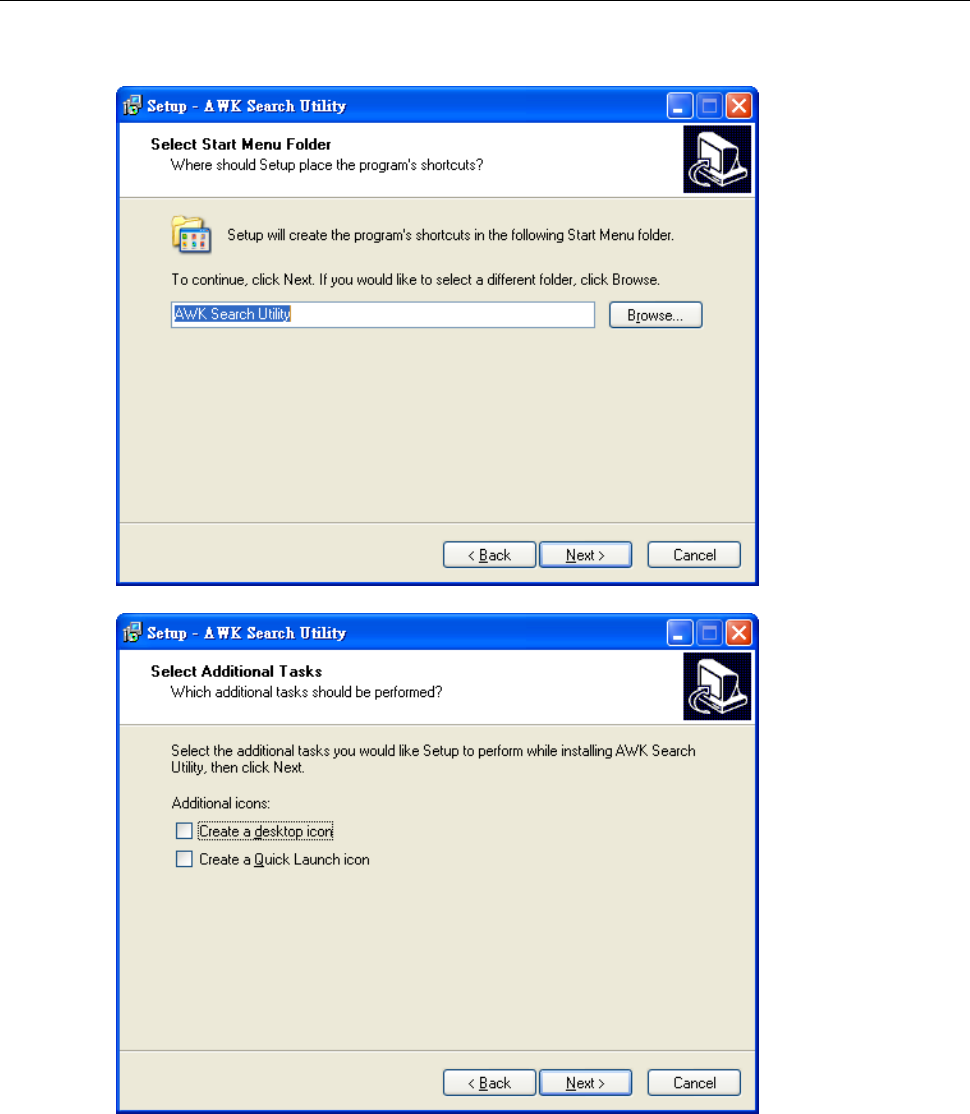
AirWorks AWK-4131A Software Installation/Configuration
4-3
4. Click Next to create the program’s shortcut files to the default directory, or click Browse to select an
alternate location.
5. Click Next to select additional tasks.
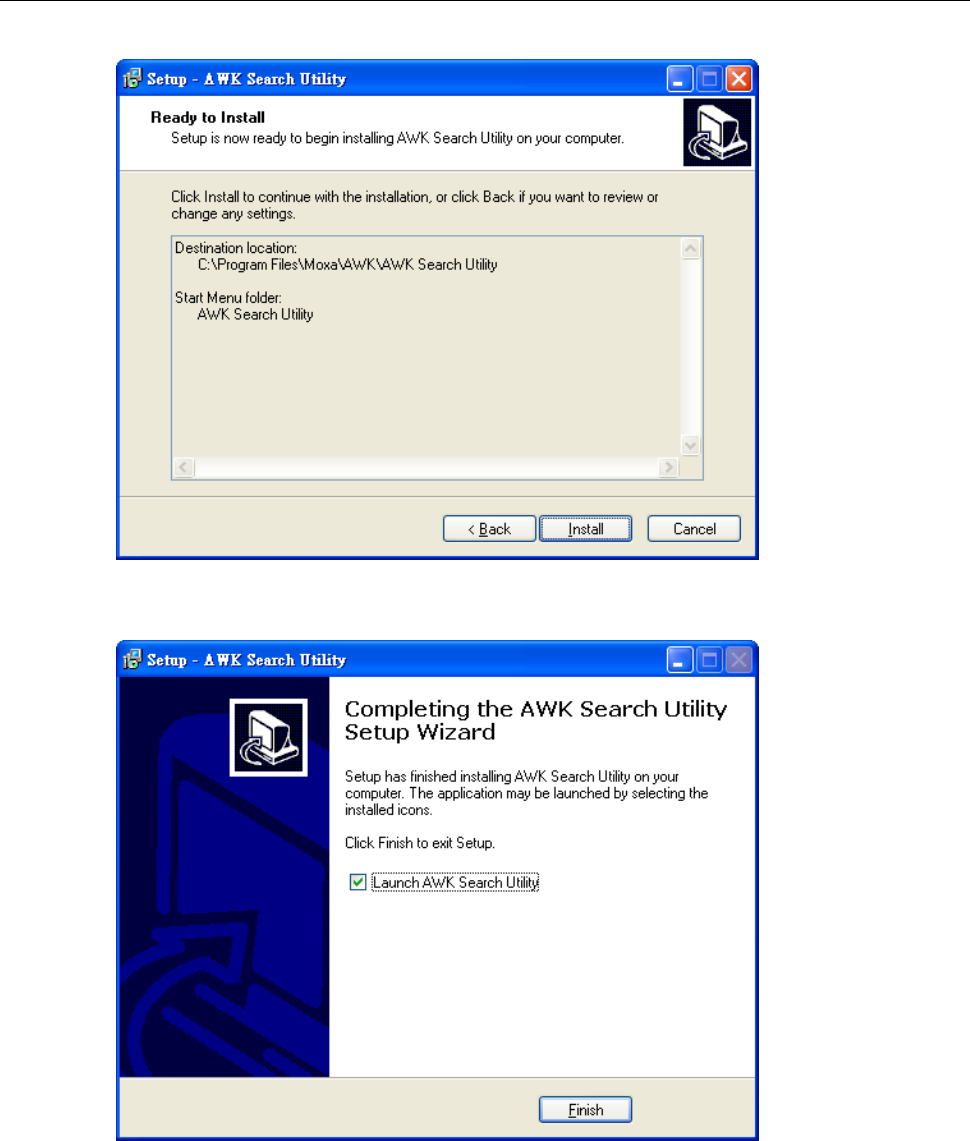
AirWorks AWK-4131A Software Installation/Configuration
4-4
6. Click Next to proceed with the installation. The installer then displays a summary of the installation options.
7. Click Install to begin the installation. The setup window will report the progress of the installation. To
change the installation settings, click Back and navigate to the previous screen.
8. Click Finish to complete the installation of AWK Search Utility.
Configuring AWK Search Utility
The Broadcast Search function is used to locate all AWK-4131A APs that are connected to the same LAN as your
computer. After locating an AWK-4131A, you will be able to change its IP address. Since the Broadcast Search
function searches by TCP packet and not IP address, it doesn’t matter if the AWK-4131A is configured as an AP
or Client. In either case, APs and Clients connected to the LAN will be located, regardless of whether or not they
are part of the same subnet as the host.
1. Start the AWK Search Utility program. When the Login page appears, select the “Search AWK only”
option to search for AWKs and to view each AWK’s configuration. Select the “AWK management” option to
assign IPs, upgrade firmware, and locate devices.
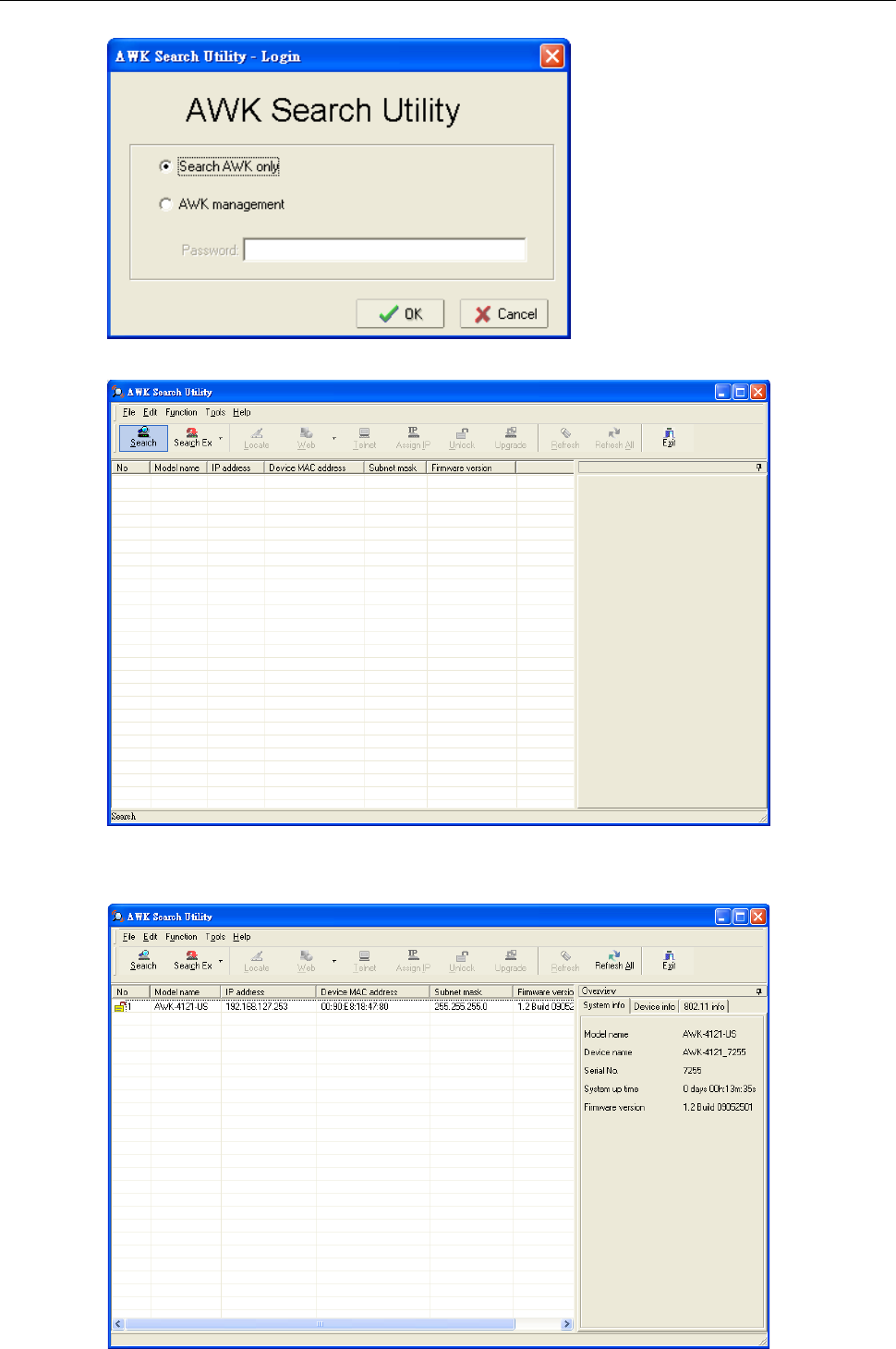
AirWorks AWK-4131A Software Installation/Configuration
4-5
2. Open the AWK Search Utility and then click the Search icon.
The “Searching” window indicates the progress of the search.
3. When the search is complete, all AWKs that were located will be displayed in the AWK Search Utility window.
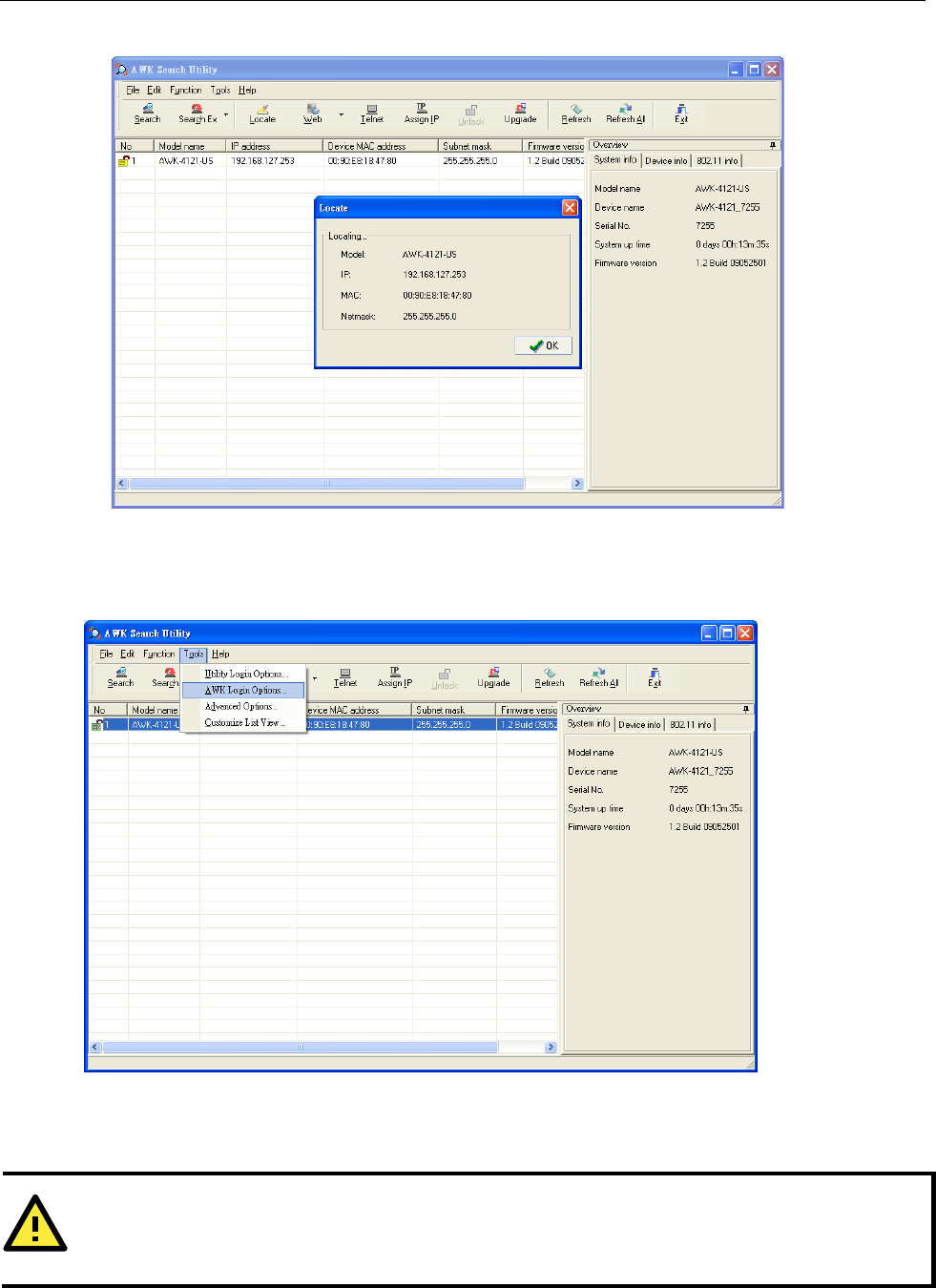
AirWorks AWK-4131A Software Installation/Configuration
4-6
4. Click Locate to cause the selected device to beep.
Make sure your AWK is unlocked before using the search utility’s icons setting. The AWK will unlock
automatically if the password is set to the default. Otherwise you must enter the new password manually.
Go to Tools
AWK login Options to manage and unlock additional AWKs.
Use the scroll down list to select the MAC addresses of those AWKs you would like to manage, and then click
Add. Key in the password for the AWK device and then click OK to save. If you return to the search page and
search for the AWK again, you will find that the AWK will unlock automatically.
ATTENTION
For security purposes, we suggest you can change the AWK search utility login password instead of using
default.
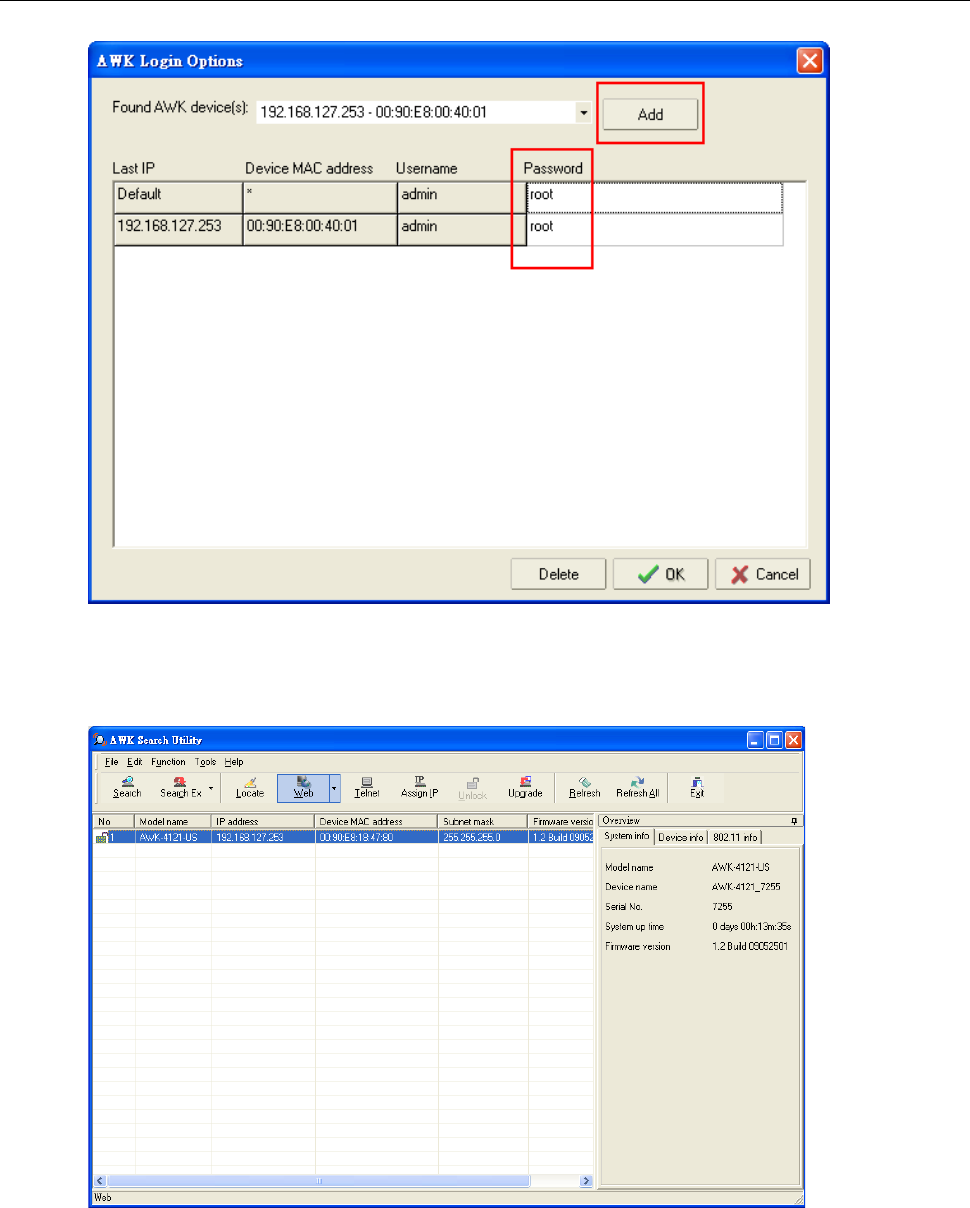
AirWorks AWK-4131A Software Installation/Configuration
4-7
To modify the configuration of the highlighted AWK, click on the Web icon to open the web console. This will
take you to the web console, where you can make all configuration changes. Refer to Chapter 3, “Using the Web
Console,” for information on how to use the web console.
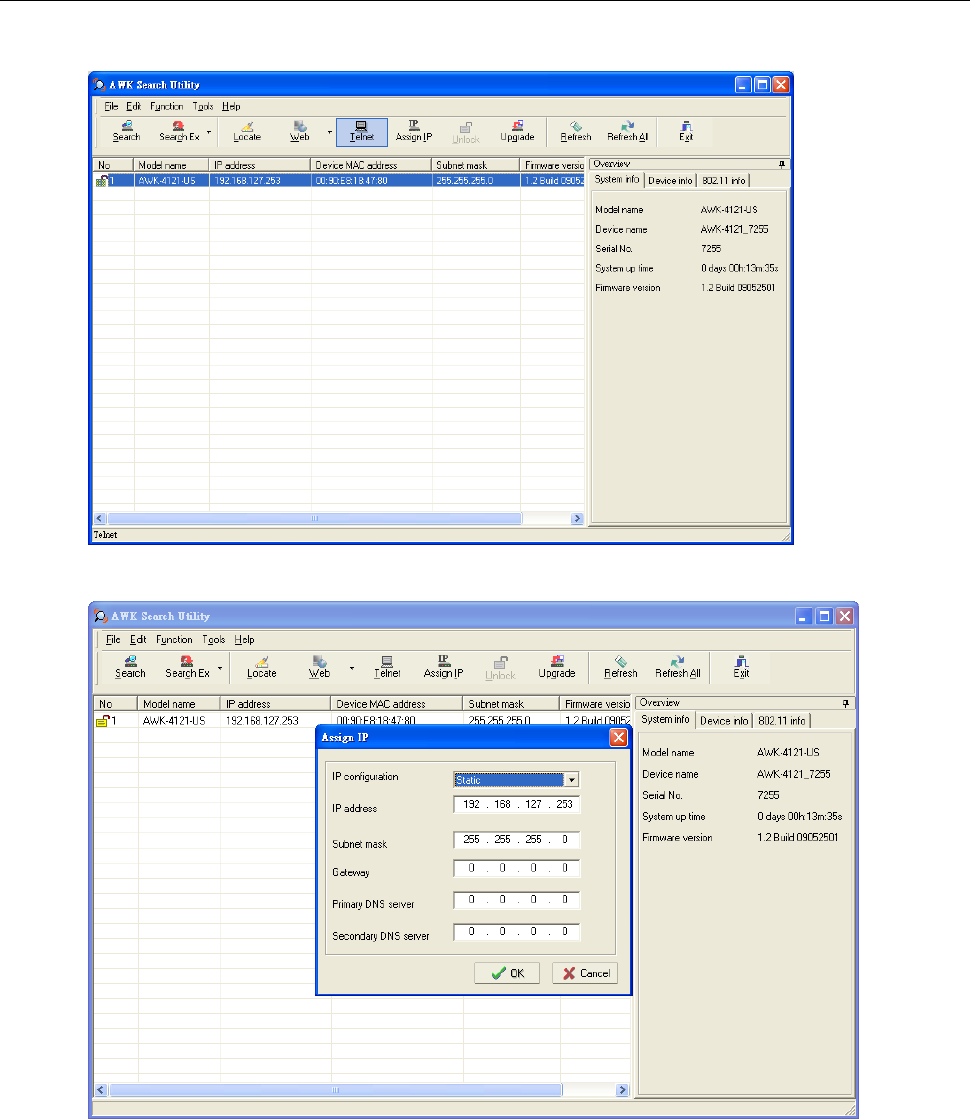
AirWorks AWK-4131A Software Installation/Configuration
4-8
Click on Telnet if you would like to use telnet to configure your AWKs.
Click Assign IP to change the IP setting.
The three advanced options—Search, Connection, and Miscellaneous—are explained below:
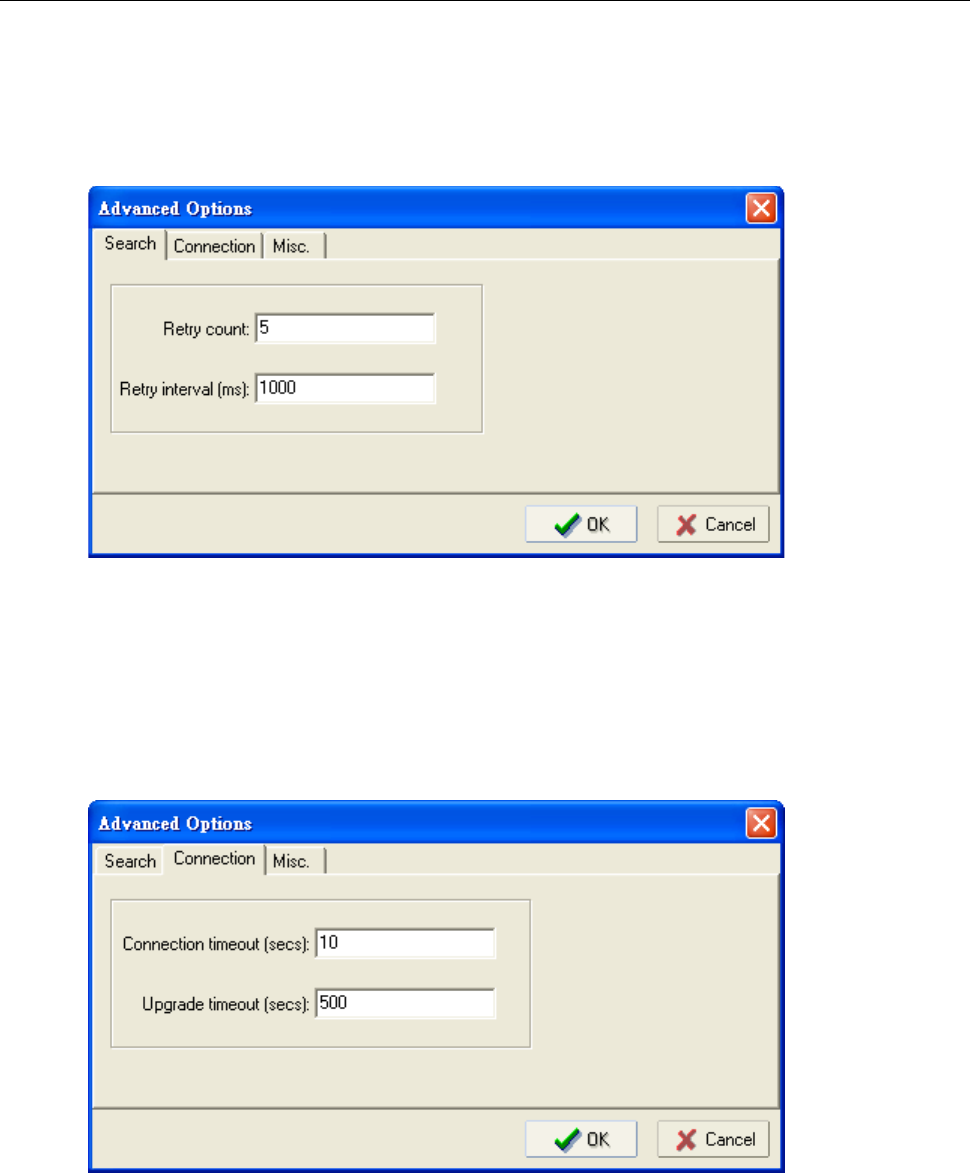
AirWorks AWK-4131A Software Installation/Configuration
4-9
Search
Retry count (default=5): Indicates how many times the search will be retried automatically.
Retry interval (ms): The time lapsed between retries.
Connection
Connection timeout (secs): Use this option to set the waiting time for the Default Login,
Locate, Assign IP, Upload Firmware, and Unlock to complete.
Upgrade timeout (secs): Use this option to set the waiting time for the connection to disconnect while the
firmware is upgrading. Use this option to set the waiting time for the Firmware to write to flash.
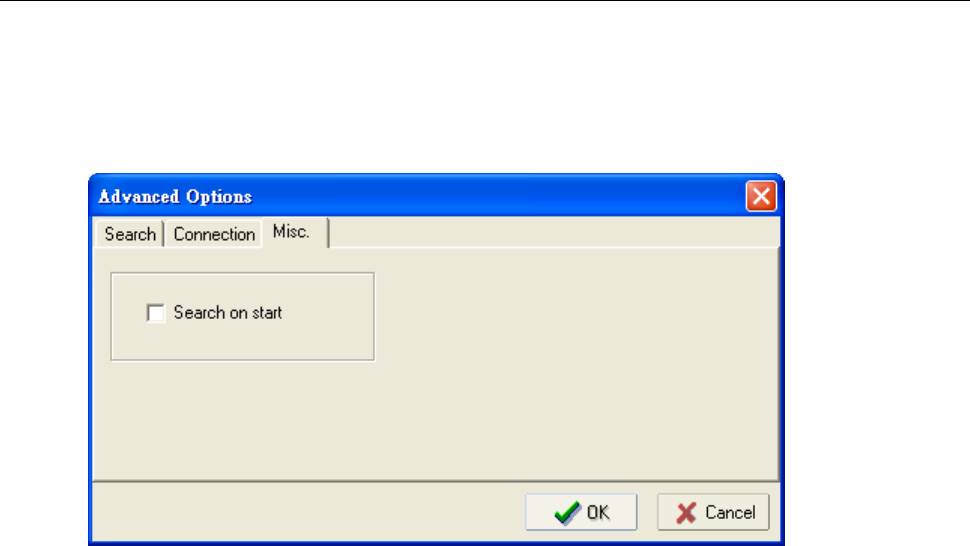
AirWorks AWK-4131A Software Installation/Configuration
4-10
Misc.
Search on start: Checkmark this box if you would like the search function to start searching for devices after
you log in to the AWK search Utility.

5
5. Other Console Configurations
This chapter explains how to access the AWK-4131A for the first time. In addition to HTTP access, there are four
ways to access AWK-4131A: serial console, Telnet console, SSH console, and HTTPS console. The serial console
connection method, which requires using a short serial cable to connect the AWK-4131A to a PC’s COM port,
can be used if you do not know the AWK-4131A’s IP address. The other consoles can be used to access the
AWK-4131A over an Ethernet LAN, or over the Internet.
The following topics are covered in this chapter:
RS-232 Console Configuration (115200, None, 8, 1, VT100)
Configuration by Telnet and SSH Consoles
Configuration by Web Browser with HTTPS/SSL
Disabling Telnet and Browser Access
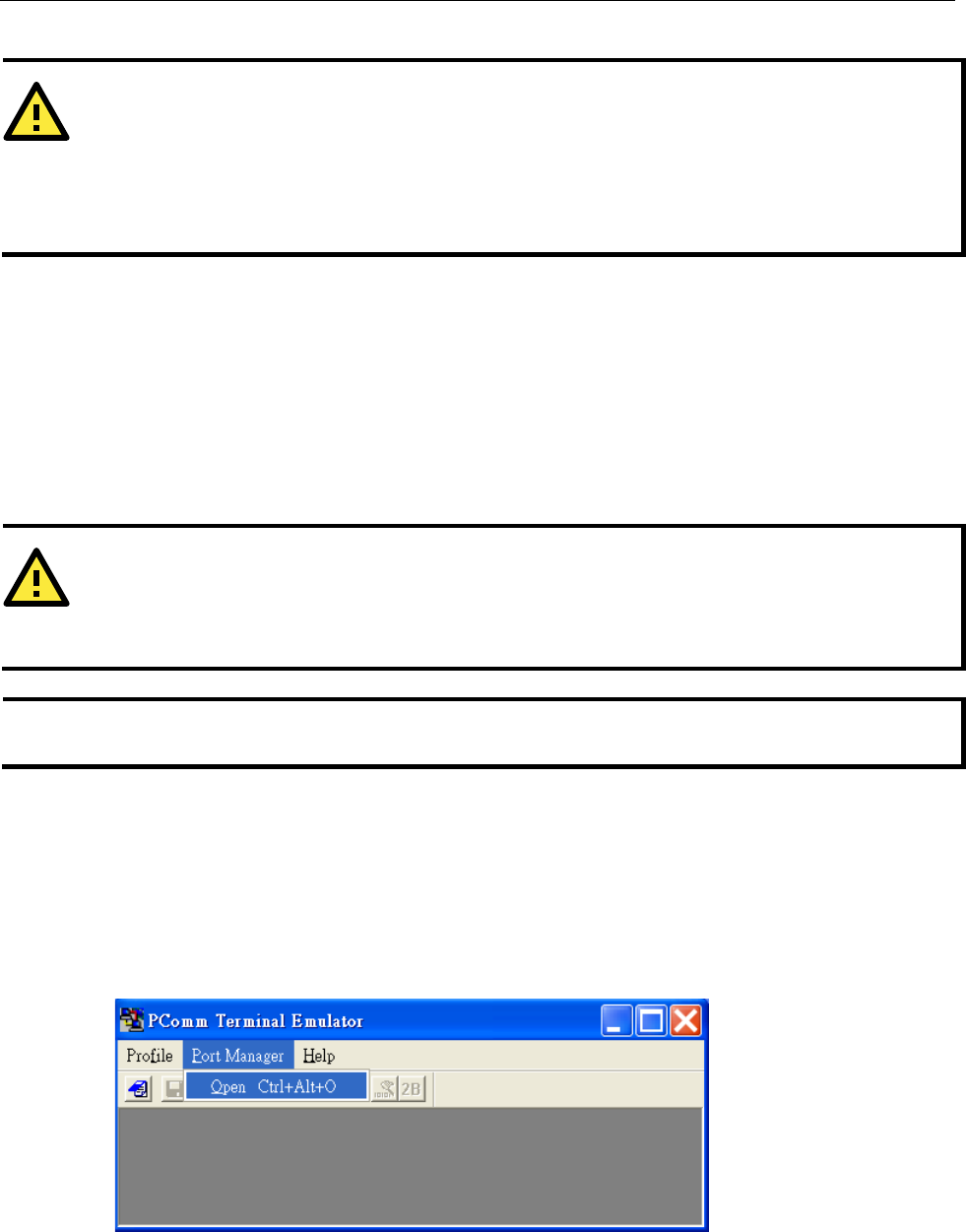
AirWorks AWK-4131A Other Console Configurations
5-2
ATTENTION
1.
You CANNOT connect to the AWK-4131A by two ore more of these console configurations
simultaneously.
2.
You can connect to the AWK-4131A simultaneously by web browser and serial/ Telnet /SSH console.
However, we strongly suggest that you
do NOT use more than one connection method at the same time.
Following this advice will allow you to maintain better control over the configuration of you
r AWK-4131A.
RS-232 Console Configuration (115200, None, 8,
1, VT100)
The serial console connection method, which requires using a short serial cable to connect the AWK-4131A to
a PC’s COM port, can be used if you do not know the AWK-4131A’s IP address. It is also convenient to use serial
console configurations when you cannot access the AWK-4131A over Ethernet LAN, such as in the case of LAN
cable disconnections or broadcast storming over the LAN.
ATTENTION
Do not use the
RS-232 console manager when the AWK-4131A is powered at reversed voltage (ex. -
48VDC),
even though reverse voltage protection is supported. If you need to connect the RS
-232 console at reverse
voltage, Moxa’s TCC
-82 isolator is your best solution.
NOTE
We recommend using Moxa PComm (Lite) Terminal Emulator, which can be downloaded free of charge from
Moxa’s website.
Before running PComm Terminal Emulator, use an RJ45 to DB9-F (or RJ45 to DB25-F) cable to connect the
AWK-4131A’s RS-232 console port to your PC’s COM port (generally COM1 or COM2, depending on how your
system is set up). After installing PComm Terminal Emulator, take the following steps to access the RS-232
console utility.
1. From the Windows desktop, open the Start menu and start PComm Terminal Emulator in the PComm
(Lite) group.
2. Select Open under Port Manager to open a new connection.
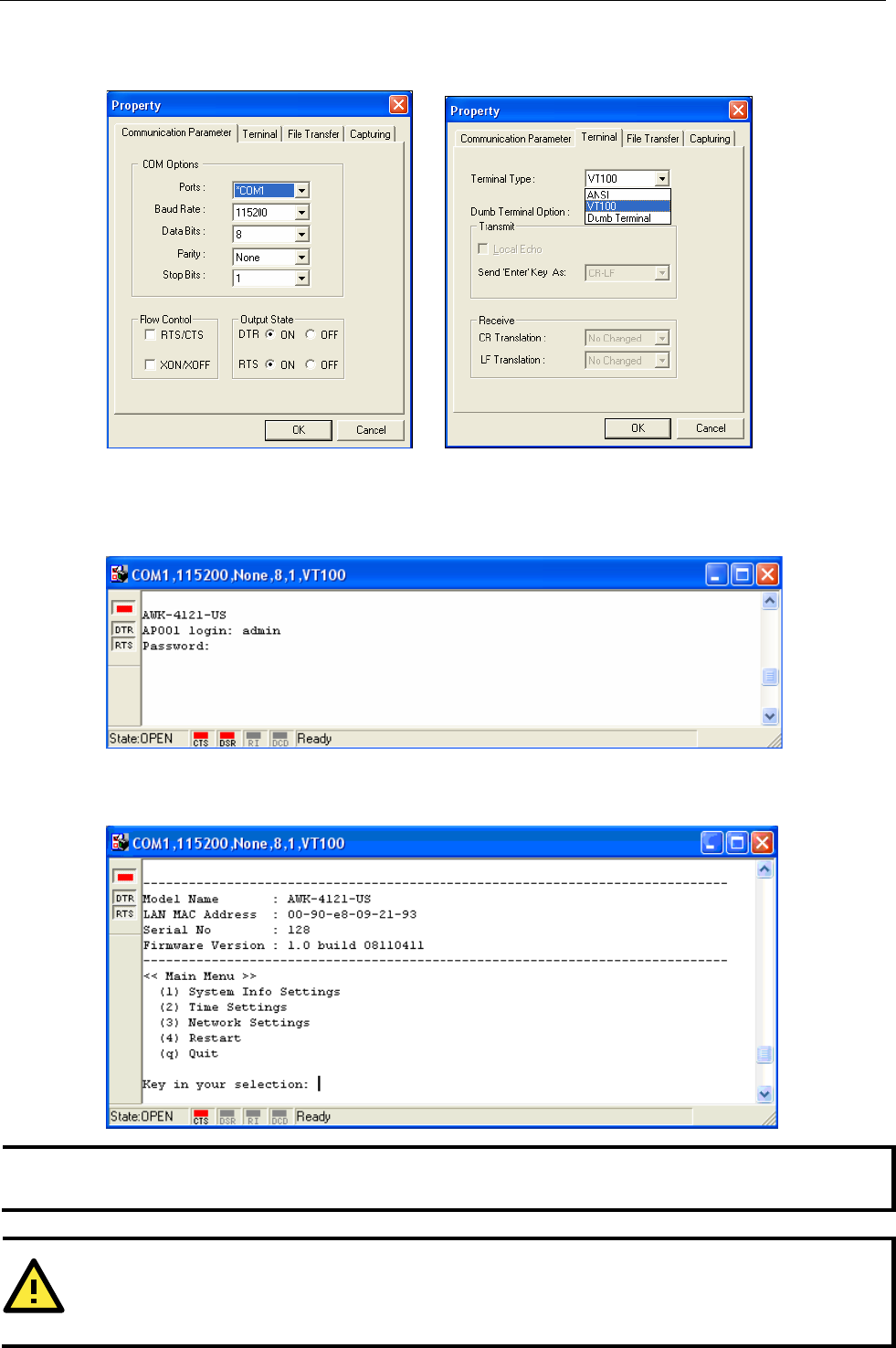
AirWorks AWK-4131A Other Console Configurations
5-3
3. The Communication Parameter page of the Property window opens. Select the appropriate COM port for
Console Connection, 115200 for Baud Rate, 8 for Data Bits, None for Parity, and 1 for Stop Bits.
4. Click on the Terminal tab, and select VT100 (or ANSI) for Terminal Type. Click on OK to continue.
5. The Console login screen will appear. Log into the RS-232 console with the login name (default: admin)
and password (default: root, if no new password is set).
6. The AWK-4131A’s device information and Main Menu will be displayed. Please follow the description on
screen and select the administration option you wish to perform.
NOTE
To modify the appearance of the PComm Terminal Emulator window, select Edit
Font and then choose the
desired formatting options.
ATTENTION
If you unplug the RS
-232 cable or trigger DTR, you will automatically be lo
gged out for network security. You
will need to log in again to resume operation.
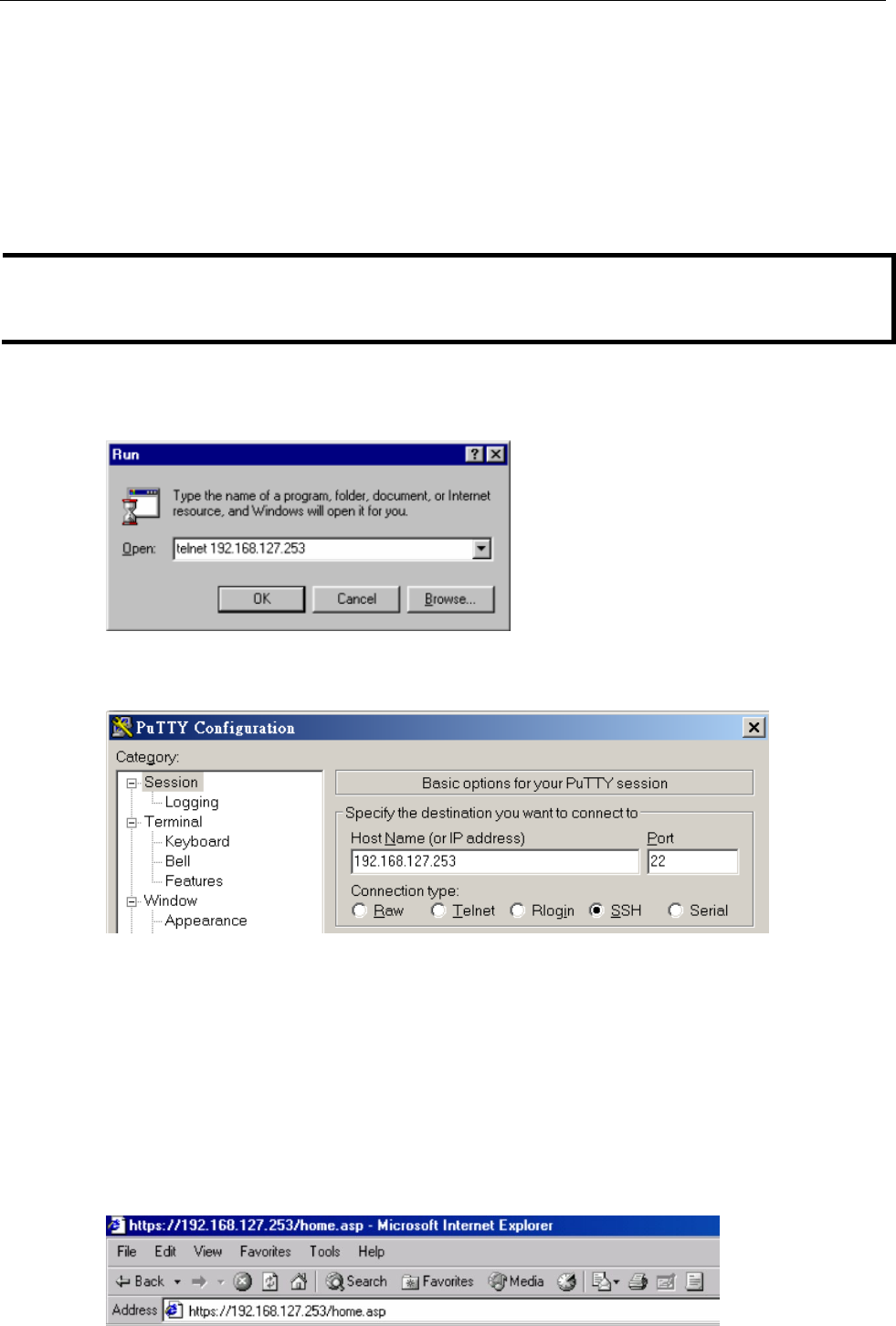
AirWorks AWK-4131A Other Console Configurations
5-4
Configuration by Telnet and SSH Consoles
You may use Telnet or SSH client to access the AWK-4131A and manage the console over a network. To access
the AWK-4131A’s functions over the network from a PC host that is connected to the same LAN as the
AWK-4131A, you need to make sure that the PC host and the AWK-4131A are on the same logical subnet. To
do this, check your PC host’s IP address and subnet mask.
NOTE
The
AWK-4131A’s default IP address is 192.168.127.253
and the default subnet mask is 255.255.255.0 (for
a Class C network). If you do not set these values properly, please check the network settings of your PC host
and then change the IP address to 192.168.127
.xxx and subnet mask to 255.255.255.0.
Follow the steps below to access the console utility via Telnet or SSH client.
1. From Windows Desktop, run Start
Run, and then use Telnet to access the AWK-4131A’s IP address from
the Windows Run window. (You may also issue the telnet command from the MS-DOS prompt.)
When using SSH client (ex. PuTTY), please run the client program (ex. putty.exe) and then input the
AWK-4131A’s IP address, specifying 22 for the SSH connection port.
2. The Console login screen will appear. Please refer to the previous paragraph “RS-232 Console
Configuration” and for login and administration.
Configuration by Web Browser with HTTPS/SSL
To secure your HTTP access, the AWK-4131A supports HTTPS/SSL encryption for all HTTP traffic. Perform the
following steps to access the AWK-4131A’s web browser interface via HTTPS/SSL.
1. Open your web browser and type https://<AWK-4131A’s IP address> in the address field. Press Enter to
establish the connection.
\
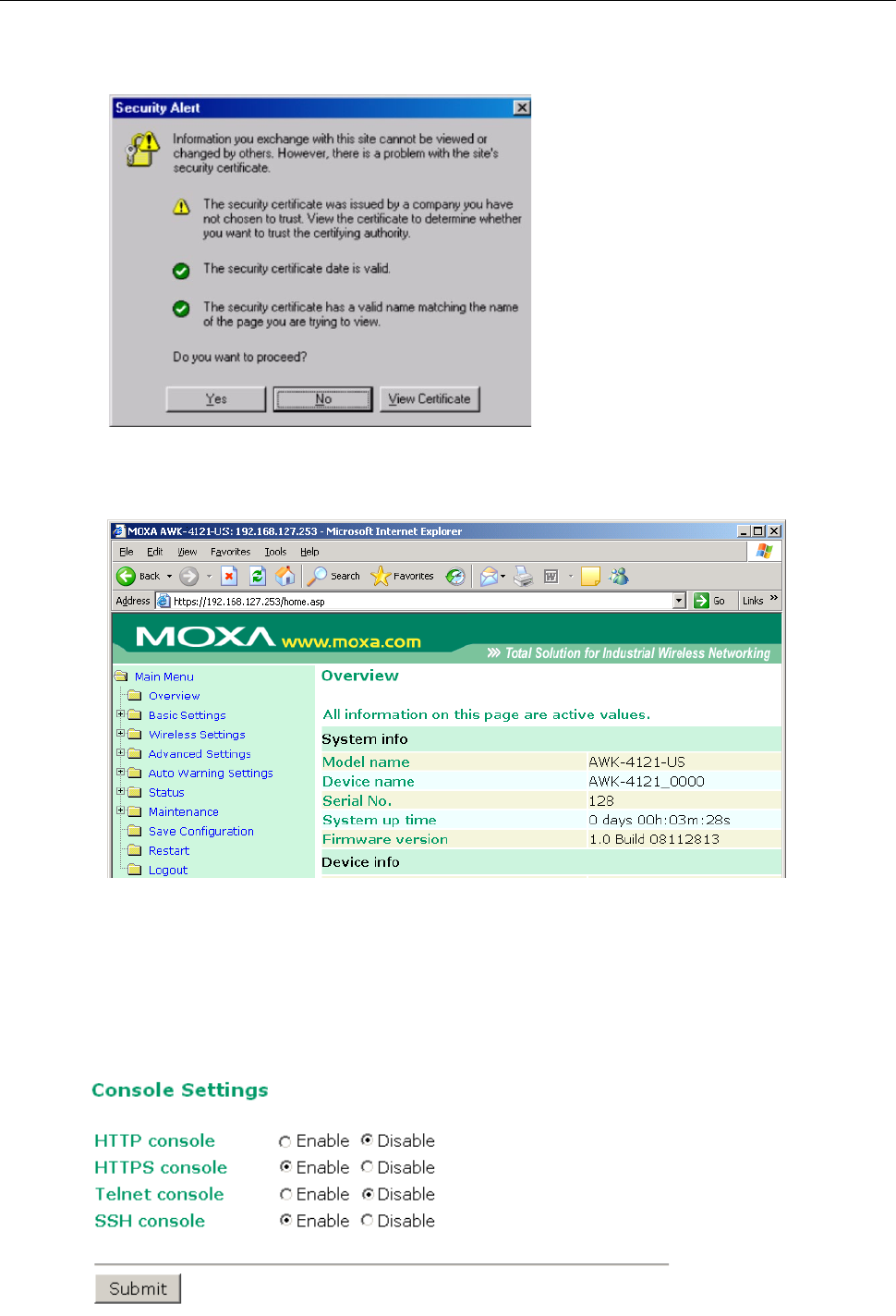
AirWorks AWK-4131A Other Console Configurations
5-5
2. Warning messages will pop out to warn users that the security certificate was issued by a company they
have not chosen to trust.
3. Select Yes to accept the certificate issued by Moxa IW and then enter the AWK-4131A’s web browser
interface secured via HTTPS/SSL. (You can see the protocol in URL is https.) Then you can use the menu
tree on the left side of the window to open the function pages to access each of the AWK-4131A’s functions.
Disabling Telnet and Browser Access
If you are connecting the AWK-4131A to a public network but do not intend to use its management functions
over the network, then we suggest disabling both Telnet Console and Web Configuration. Please run
Maintenance
Console Settings to disable them, as shown in the following figure.

6
6. References
This chapter provides more detailed information about wireless-related technologies. The information in this
chapter can help you administer your AWK-4131As and plan your industrial wireless network better.
The following topics are covered in this chapter:
Wireless Distribution System (WDS)
Beacon
DTIM
Fragment
RTS Threshold
STP and RSTP
The STP/RSTP Concept
Differences between RSTP and STP
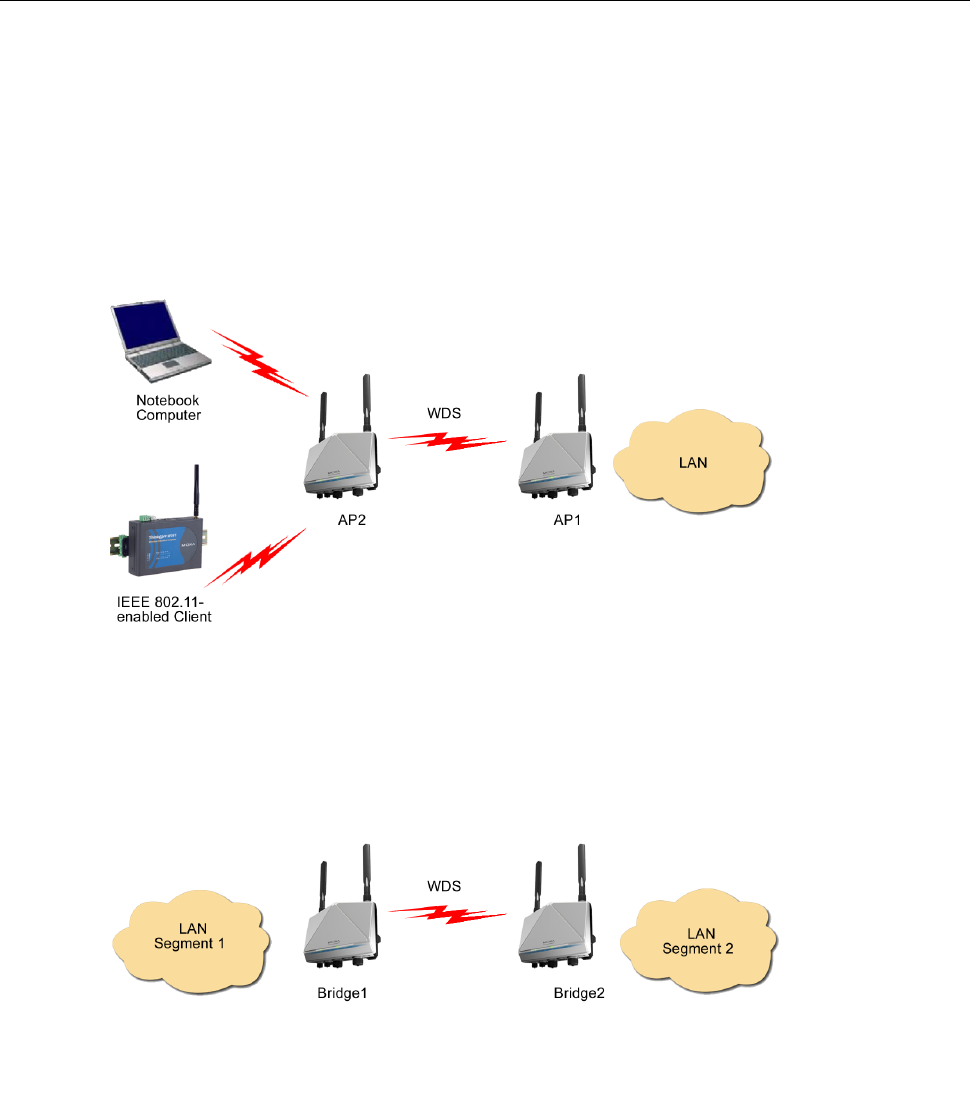
AirWorks AWK-4131A References
6-2
Wireless Distribution System (WDS)
Traditionally, APs are connected via Ethernet LAN ports. By using a Wireless Distribution System (WDS), APs
can communicate with one another wirelessly. For example, AP 2 acts as an access point for the notebook
computers or other IEEE802.11-enabled clients, and forwards packets sent from the notebook computers to AP
1 through WDS. Then, AP 1 forwards the packets to the Ethernet LAN. Packets destined for the notebook
computers follow a reverse path from the Ethernet LAN through the APs to the notebook computers. In this way,
AP 2 acts as an “AP repeater.”
By using WDS, two or more LAN segments can be connected wirelessly. As illustrated in the above figure, a pair
of wireless LAN-to-LAN bridges is used to connect two LAN segments. Since the AP is WDS-enabled, it can be
used as a wireless bridge.
It is a good idea to plan your wireless network by drawing a diagram so that you know how each AWK-4131A
is connected to other peer APs or wireless bridges by WDS, and how bridges are connected to other peer
bridges by WDS. See the following figure for an example of a network-planning diagram.
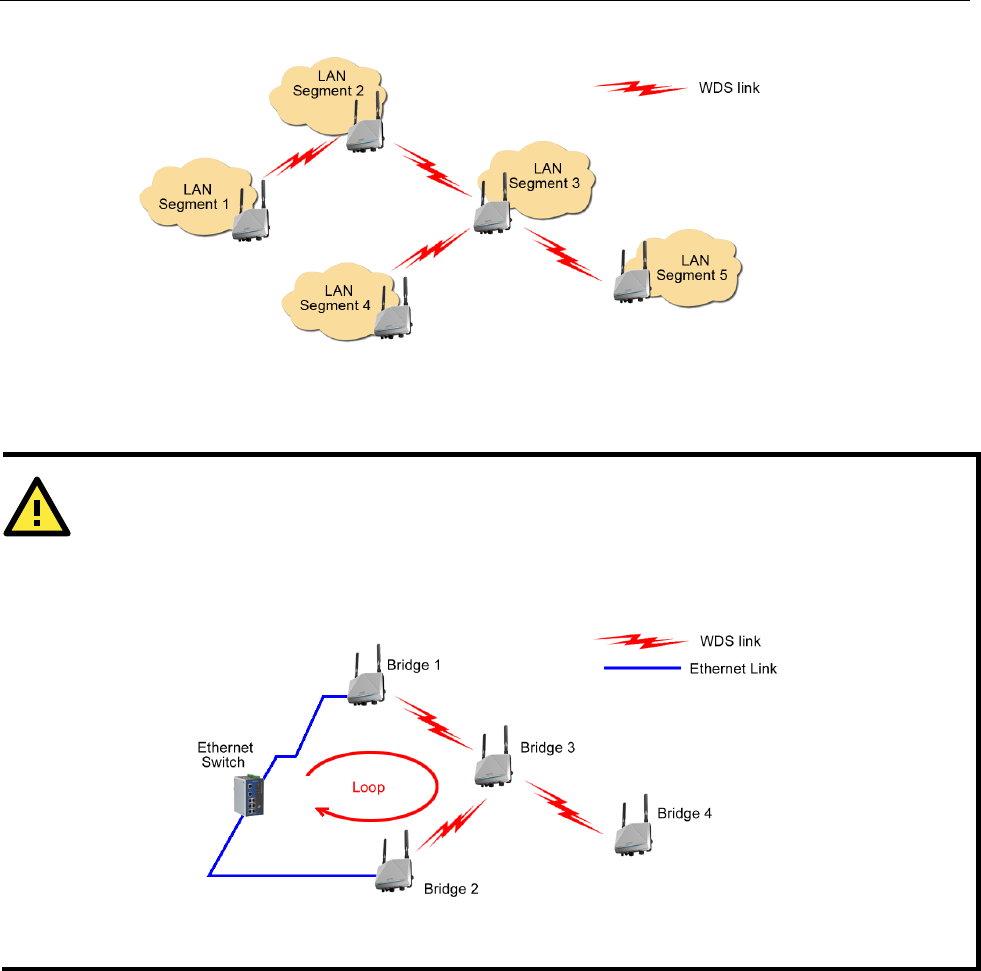
AirWorks AWK-4131A References
6-3
ATTENTION
Be sure to eliminate loops from networks that consist of wireless bridges, Ethernet switches, Ethernet links,
and WDS links. If a
ny loops exist, packets will circle around the loops and network performance will be
seriously degraded. The following figure shows a network topology containing a loop.
Beacon
A beacon is a packet broadcast by the AP to keep the network synchronized. A beacon includes the wireless LAN
service area, the AP address, the Broadcast destination address, a time stamp, Delivery Traffic Indicator Maps
(DTIM), and the Traffic Indicator Message (TIM). Beacon Interval indicates the frequency interval of AP.
DTIM
Delivery Traffic Indication Map (DTIM) is contained in beacon frames. It is used to indicate that broadcast and
multicast frames buffered by the AP will be delivered shortly. Lower settings result in more efficient networking,
while preventing your PC from dropping into power-saving sleep mode. Higher settings allow your PC to enter
sleep mode, thus saving power.

AirWorks AWK-4131A References
6-4
Fragment
A lower setting means smaller packets, which will create more packets for each transmission. If you have
decreased this value and experience high packet error rates, you can increase it again, but it will likely decrease
overall network performance. Only minor modifications of this value are recommended.
RTS Threshold
RTS Threshold (256-2346) – This setting determines how large a packet can be before the Access Point
coordinates transmission and reception to ensure efficient communication. This value should remain at its
default setting of 2,346. When you encounter inconsistent data flow, only minor modifications are
recommended.
STP and RSTP
The STP/RSTP Concept
Spanning Tree Protocol (STP) was designed to help reduce link failures in a network, and provide protection
from loops. Networks that have a complicated architecture are prone to broadcast storms caused by
unintended loops in the network. The STP protocol is part of the IEEE802.1D standard, 1998 Edition bridge
specification.
Rapid Spanning Tree Protocol (RSTP) implements the Spanning Tree Algorithm and Protocol defined by
IEEE802.1w-2001 standard. RSTP provides the following benefits:
The topology of a bridged network will be determined much more quickly compared to STP.
RSTP is backward compatible with STP, making it relatively easy to deploy. For example:
Defaults to sending 802.1D-style BPDUs if packets with this format are received.
STP (802.1D) and RSTP (802.1w) can operate on the LAN ports and WLAN ports (AP and WDS1-WDS8) of the
same AWK-4131A.
This feature is particularly helpful when the AWK-4131A connects to older equipment, such as legacy switches.
Differences between RSTP and STP
RSTP is similar to STP, but includes additional information in the BPDUs that allow each bridge to confirm that
it has taken action to prevent loops from forming when it decides to enable a link to a neighboring bridge.
Adjacent bridges connected via point-to-point links will be able to enable a link without waiting to ensure that
all other bridges in the network have had time to react to the change. The main benefit of RSTP is that the
configuration decision is made locally rather than network-wide, allowing RSTP to carry out automatic
configuration and restore a link faster than STP.

7
7. Supporting Information
This chapter presents additional information about this manual and product. You can also learn how to contact
Moxa for technical support.
The following topics are covered in this chapter:
About This User’s Manual
DoC (Declaration of Conformity)
Federal Communication Commission Interference Statement
R&TTE Compliance Statement
Firmware Recovery
Technical Support Contact Information
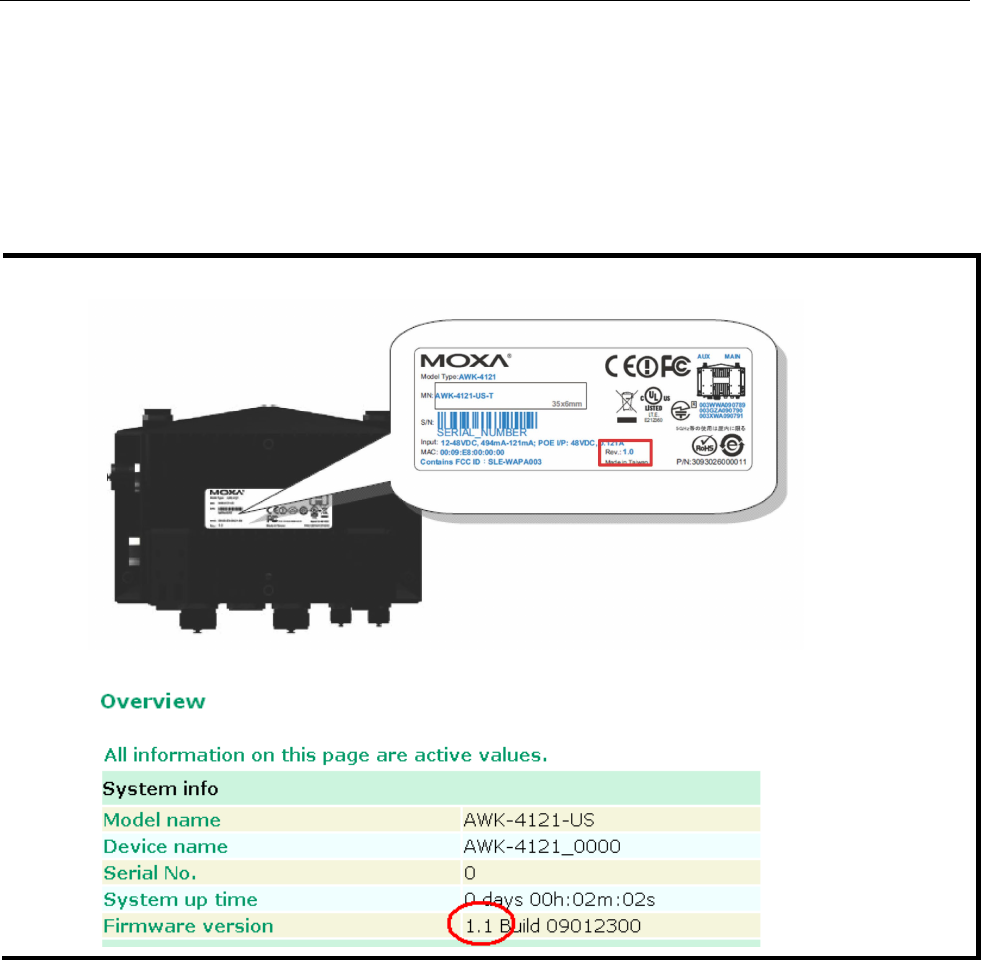
AirWorks AWK-4131A Supporting Information
7-2
About This User’s Manual
This manual is mainly designed for, but no limited to, the following hardware and firmware for the AWK-4131A:
• Hardware Rev: 1.1
• Firmware Ver: 1.10
You are strongly recommended to visit Moxa’s website (http://www.moxa.com) and find the latest product
datasheet, firmware, QIG (Quick Installation Guide), UM (User’s Manual) and related information.
NOTE
You can find out the hardware revision number of
AWK-4131A on the side label.
The firmware version number can be seen on the Overview page, as follow:
DoC (Declaration of Conformity)
Federal Communication Commission Interference Statement
This equipment has been tested and found to comply with the limits for a Class B digital device, pursuant to Part
15 of the FCC Rules. These limits are designed to provide reasonable protection against harmful interference in
a residential installation. This equipment generates, uses and can radiate radio frequency energy and, if not
installed and used in accordance with the instructions, may cause harmful interference to radio
communications. However, there is no guarantee that interference will not occur in a particular installation. If
this equipment does cause harmful interference to radio or television reception, which can be determined by
turning the equipment off and on, the user is encouraged to try to correct the interference by one of the
following measures:
• Reorient or relocate the receiving antenna.
• Increase the separation between the equipment and receiver.
• Connect the equipment into an outlet on a circuit different from that to which the receiver is connected.
• Consult the dealer or an experienced radio/TV technician for help.

AirWorks AWK-4131A Supporting Information
7-3
FCC Caution: To assure continued compliance, (example – use only shielded interface cables when connecting
to computer or peripheral devices). Any changes or modifications not expressly approved by the party
responsible for compliance could void the user’s authority to operate this equipment. This transmitter must not
be co-located or operated in conjunction with any other antenna or transmitter.
FCC Radiation Exposure Statement
This equipment complies with FCC radiation exposure limits set forth for an uncontrolled environment. This
equipment should be installed and operated with a minimum distance of 20 cm between the radiator & your
body.
This device complies with Part 15 of the FCC Rules. Operation is subject to the following two conditions: (1) This
device may not cause harmful interference, and (2) this device must accept any interference received,
including interference that may cause undesired operation.
FCC 15.407(e): Within the 5.15-5.25 GHz band, U-NII devices are restricted to indoor operations to reduce any
potentially harmful interference to co-channel MSS operations.
NOTE
The availability of some specific channels and / or operational frequency bands are country dependent and are
firmware programmed at the factory to match the intended destination. The firmware setting is not accessible
by the end user.
R&TTE Compliance Statement
Moxa declares that the apparatus AWK-3121 complies with the essential requirements and other relevant
provisions of Directive 1999/5/EC.
This equipment complies with all the requirements of DIRECTIVE 1999/5/CE OF THE EUROPEAN PARLIAMENT
AND THE COUNCIL OF 9 March 1999 on radio equipment and telecommunication terminal equipment and the
mutual recognition of their conformity (R&TTE).
The R&TTE Directive repeals and replaces in the directive 98/13/EEC (Telecommunications Terminal
Equipment and Satellite Earth Station Equipment) as of April 8, 2000.
Safety
This equipment is designed with the utmost care for the safety of those who install and use it. However, special
attention must be paid to the dangers of electric shock and static electricity when working with electrical
equipment. All guidelines of this and of the computer manufacturer must therefore be allowed at all times to
ensure the safe use of the equipment.
EU Countries Intended for Use
The ETSI version of this device is intended for home and office use in Austria, Belgium, Denmark, Finland,
France (with Frequency channel restrictions), Germany, Greece, Ireland, Italy, Luxembourg, Portugal, Spain,
Sweden, The Netherlands, and United Kingdom.
The ETSI version of this device is also authorized for use in EFTA member states Norway and Switzerland.
EU Countries Not Intended for Use
None.
Potential Restrictive Use
France: only channels 10, 11, 12, and 13.
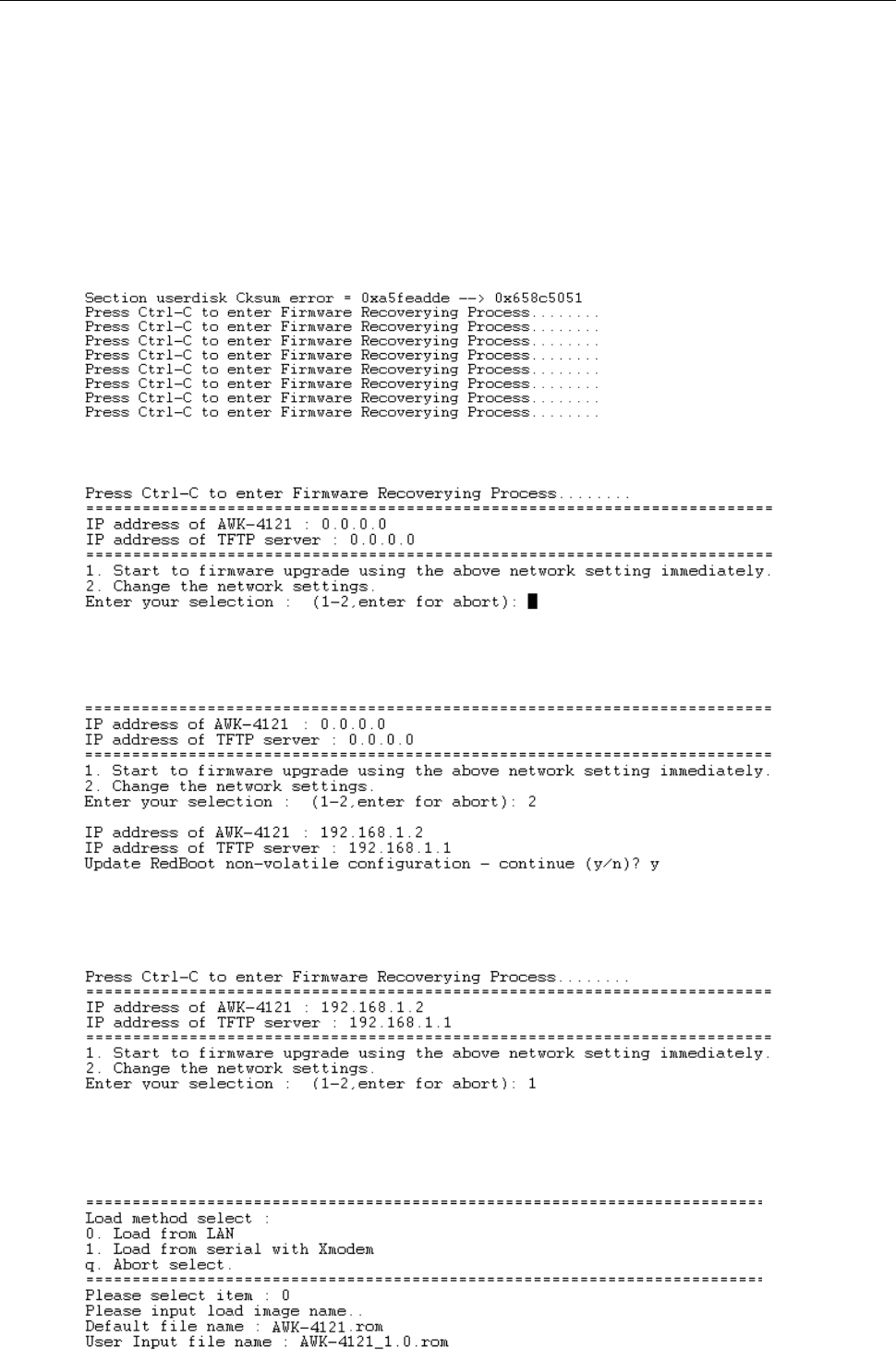
AirWorks AWK-4131A Supporting Information
7-4
Firmware Recovery
When the LEDs of FAULT, Signal Strength, CLIENT, BRIDGE and WLAN all light up simultaneously and
blink at one-second interval, it means the system booting has failed. It may result from some wrong operation
or uncontrollable issues, such as an unexpected shutdown during firmware update. The AWK-4131A is
designed to help administrators recover such damage and resume system operation rapidly. You can refer to
the following instructions to recover the firmware:
Connect to the AWK-4131A’s ES-232 console with 115200bps and N-8-1. You will see the following message
shown on the terminal emulator every one second.
Press Ctrl - C and the following message will appear.
Enter 2 to change the network setting. Specify where the AWK-4131A’s firmware file on the TFTP server and
press y to write the settings into flash memory.
AWK-4131A restarts, and the “Press Ctrl-C to enter Firmware Recovery Process…” message will reappear.
Press Ctrl-C to enter the menu and select 1 to start the firmware upgrade process.
Select 0 in the sub-menu to load the firmware image via LAN, and then enter the file name of the firmware to
start the firmware recovery.

AirWorks AWK-4131A Supporting Information
7-5
Technical Support Contact Information
Customer satisfaction is our number one concern, and to ensure that customers receive the full benefit of our
products, Moxa Internet Services has been set up to provide technical support, driver updates, product
information, certification status, installation guide and user’s manual updates.
The following services are provided:
• E-mail for technical support:
support@moxa.com (Worldwide)
support@usa.moxa.com (The Americas)
• World Wide Web (WWW) Site for product information:
http://www.moxa.com
